






GM STC
Course Catalog






GM STC
Course Catalog


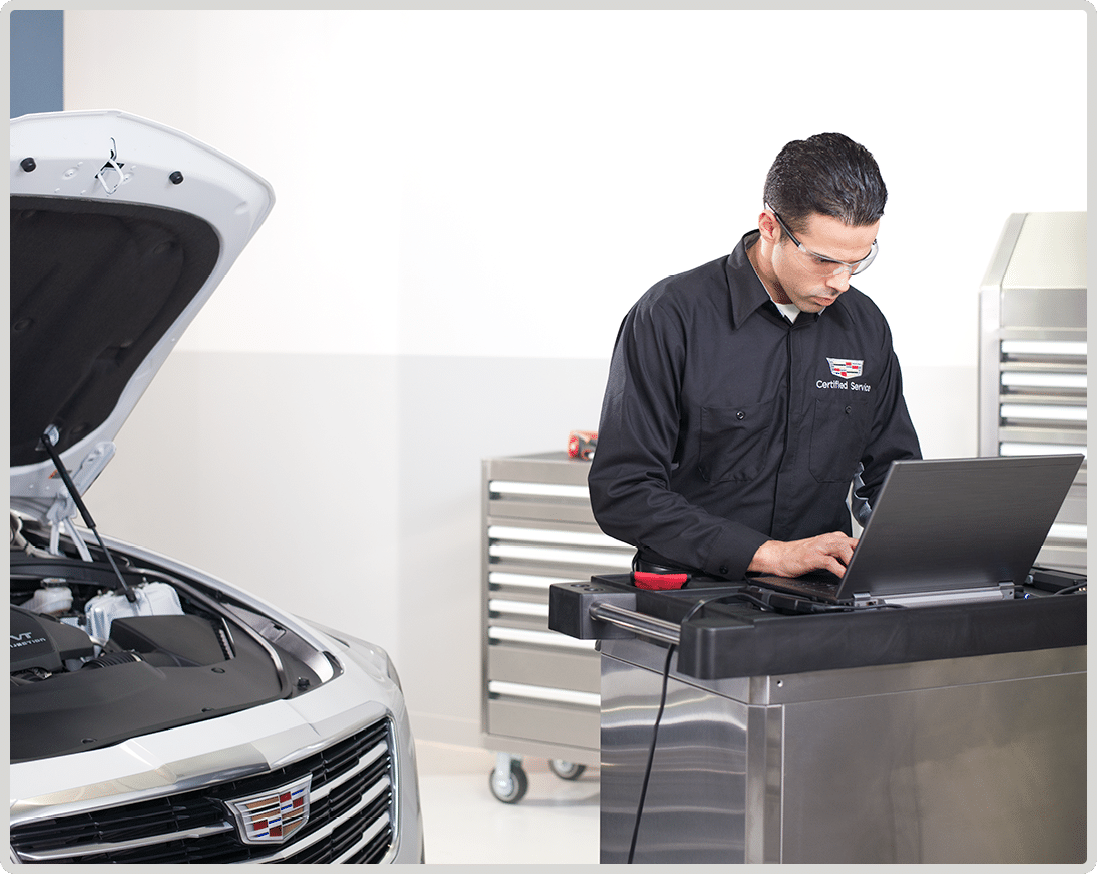
1.2 GM Service Technical College (GM STC)
The GM STC works in conjunction with GM’s Center of Learning to eliminate redundant courses and unify the service technical training curriculum. Through its blended media approaches and high quality instructional design, GM STC helps to develop the service technician’s knowledge and skills while reducing time away from dealerships. GM’s customers benefit by knowing that the service technician has the background and experience to repair the vehicle correctly the first time.
1.1 The GM Mission
Our mission is to improve the performance of GM dealerships through the professional development of dealership personnel. We provide a comprehensive curriculum of job-relevant courses, effective instruction, learning measurement, and feedback systems.
The goals of GM training are to:
1.1.1 Commonality, Productivity, and Efficiency
The GM training program continues to evolve by ensuring the right content reaches the right people at the right time. The program offers every dealership a consistent source for most training needs; it’s designed to improve performance by focusing on quality – not quantity – and by offering knowledge that is smart, convenient, and easy to access. All dealers are encouraged to participate in training.
The GM training program offers:
For information regarding enrollment, specific charges and/or program information, please contact the Center of Learning Help Desk using the Live Chat feature on the Help/Support page on www.centerlearning.com.


Our mission is to improve the performance of GM dealerships through the professional development of dealership personnel. We provide a comprehensive curriculum of job-relevant courses, effective instruction, learning measurement, and feedback systems.
The goals of GM training are to:
1.1.1 Commonality, Productivity, and Efficiency
The GM training program continues to evolve by ensuring the right content reaches the right people at the right time. The program offers every dealership a consistent source for most training needs; it’s designed to improve performance by focusing on quality – not quantity – and by offering knowledge that is smart, convenient, and easy to access. All dealers are encouraged to participate in training.
The GM training program offers:
Access to the Center of Learning website, which offers the following features:
For information regarding enrollment, specific charges and/or program information, please contact the Center of Learning Help Desk using the Live Chat feature on the Help/Support page on www.centerlearning.com.
1.1.2 GM Service Technical College (GM STC)
The GM STC works in conjunction with GM’s Center of Learning to eliminate redundant courses and unify the service technical training curriculum. Through its blended media approaches and high quality instructional design, GM STC helps to develop the service technician’s knowledge and skills while reducing time away from dealerships. GM’s customers benefit by knowing that the service technician has the background and experience to repair the vehicle correctly the first time.
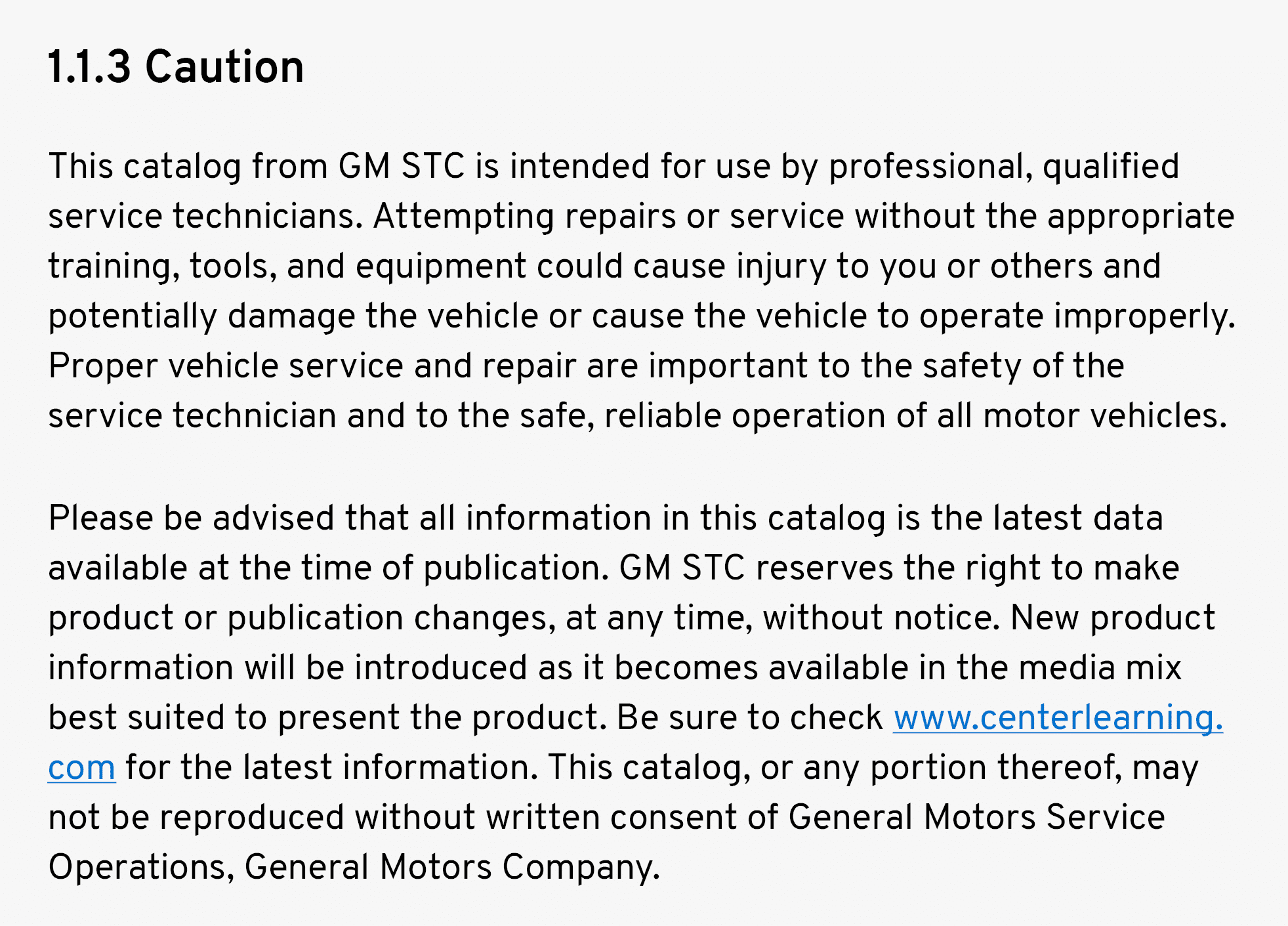

Dealer Divisional STS Courses
GM Master Technician Certification Courses
Supplemental Courses
2.1.4 Performance-Based Curriculum
The GM STC performance-based curriculum offers training courses across Chevrolet, Buick, GMC, and Cadillac brands. To receive credit for a course, service technicians must demonstrate competency in all applicable course components, which may include web-based, VOD, VCT, and GM Service Know-How Emerging Issues seminars.
If a service technician does not demonstrate sufficient competency, they will be required to review or retake the course component until competency is obtained.
The goal of the performance-based curriculum is to provide a path for service technicians to meet the requirements for GM’s Dealer Divisional Service Training Standards (STS) (for example, become Division Certified) and GM Master Technician Certification (MTC). The curriculum is divided into certification areas covering cars and light-duty trucks.
The 17 curriculum areas are:
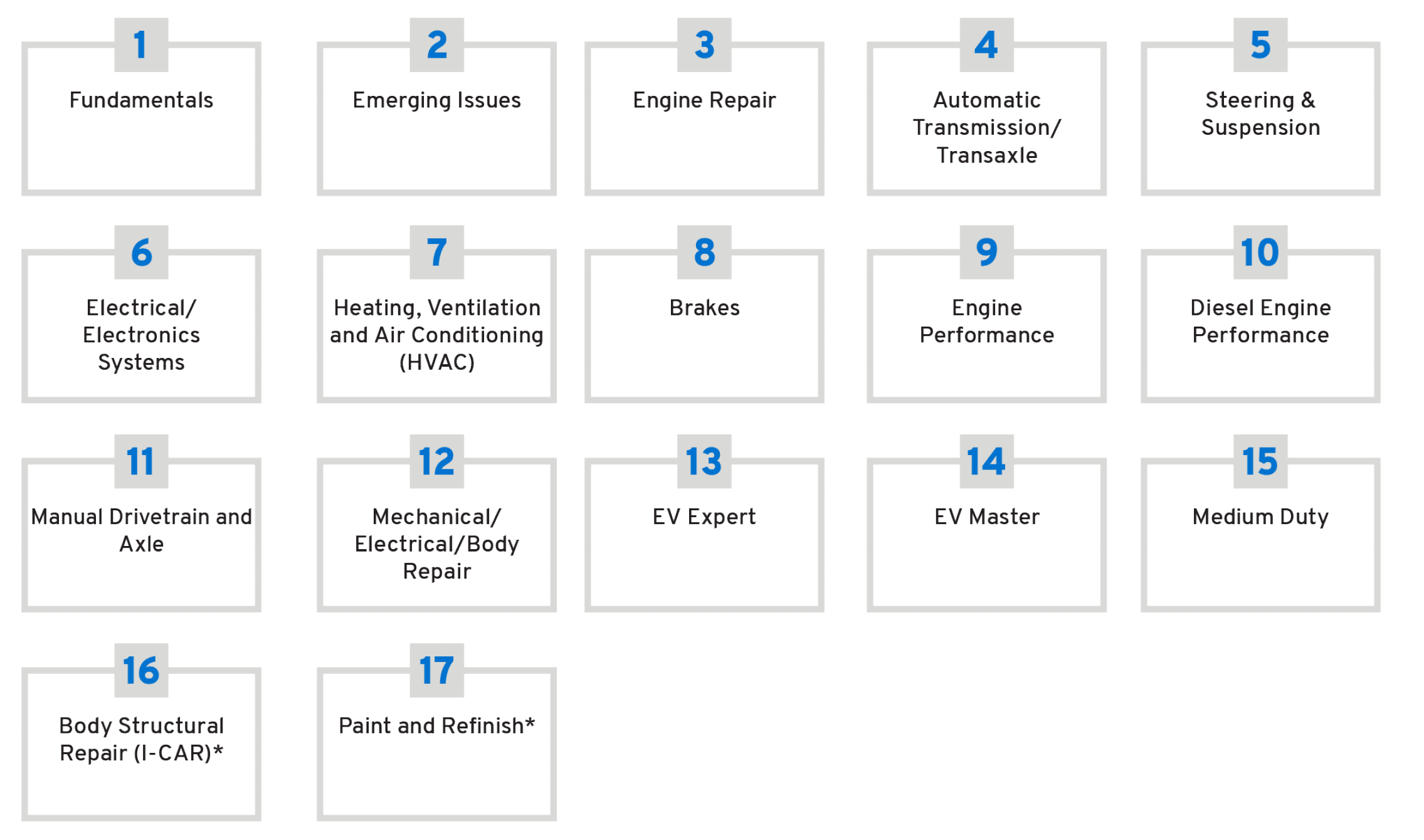
*Training and certification is offered through GM-approved suppliers and not through GM STC.
2.1.3 Service Technician Benefits
By participating in the GM STC training program, service technicians experience the following benefits:
2.1.2 Dealer Benefits
By actively participating in the GM STC training program, dealers experience the following benefits:
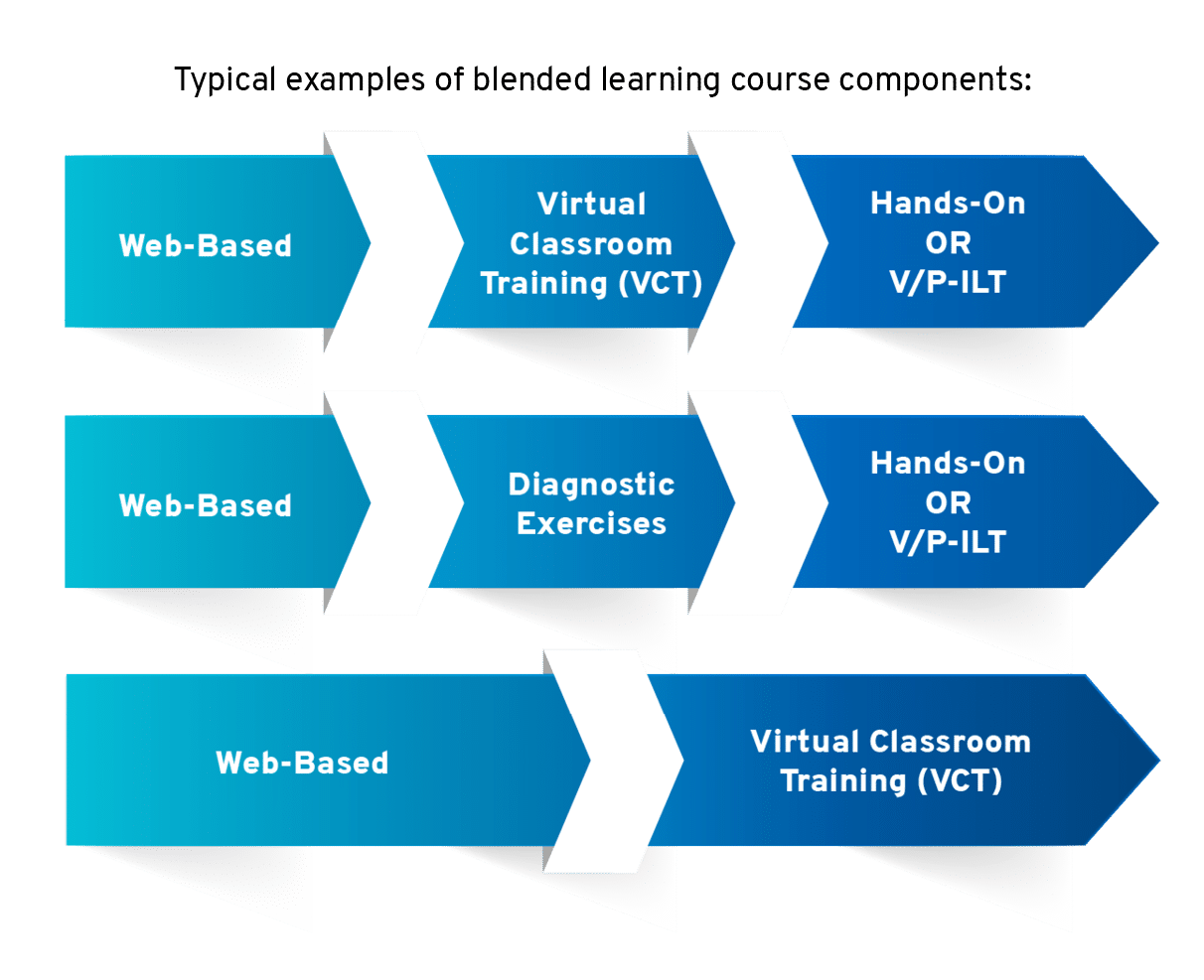 GM STC blended training delivers courses in multiple components; these different components provide the service technician with the skills necessary to “Fix it Right the First Time!”
GM STC blended training delivers courses in multiple components; these different components provide the service technician with the skills necessary to “Fix it Right the First Time!”
Multiple component courses may use combinations of the following media:
Web-based training addresses the knowledge portion of the class. The material is designed to teach the service technician theory of operation and function of the systems and components, and to introduce diagnostic procedures.
VCT reinforces the knowledge provided in the WBT and introduces the service technician to diagnostic skills necessary to repair the vehicle.
Hands On or V/P-ILT allows the service technician to practice diagnostic skills in a setting similar to the work environment.
Virtual and Performance ILT series allow technicians to complete part of the Hands-On course within their dealership using the VCT system. This small group, interactive session is followed by in-dealership Self-Study that the technician completes along with a Center of Learning assessment. Finally, the technician attends a Performance Instructor-Led Training at a GM Training Center where diagnostic procedures are focused on. This series is a new way technicians can complete their Hands-On requirements, reducing the amount of the time they are out of the dealership.
Diagnostic Exercises facilitate the practice of skills, educate, and update knowledge.
Video On Demand has an easy-to-use “Search Videos” function, which allows users to review specific content. This search capability allows technicians to locate a specific topic at any time.
In each component of the blended training, successful completion of a final test is required for course component credit.
Videos augment the basic course components and should be taken at the appropriate time in the Learning Path based on prerequisites.
2.2.1 Credit for Course Components (known as Cross Credits)
The Center of Learning enables technicians who have successfully completed a previous version of a course to conveniently get credit for a new version of the same course in their training history without having to repeat the entire course again.
2.2.2 Testing
Most courses allow for two test attempts. Technicians should review the materials carefully before taking the test; if the test attempts are exceeded, technicians will be locked out indefinitely until GM STC resets the tests on a periodic basis. Unless otherwise noted under respective course components, testing for the listed course components is as follows:
Video On Demand: Testing for content on VOD is available by going to the Course Details page in www.centerlearning.com. When the course is live and ready for viewing, service technicians should click “Launch”. When they are done viewing the course, they must click on the “Take Test” link that appears in the Video On-Demand player at the completion of the video.
The Placement Assessment process is provided by GM as a means for experienced technicians entering a GM dealership for the first time to quickly receive course credit for their knowledge, skills, and experience. Placement Assessments measure knowledge and/or skills in a given certification area and are designed to allow experienced service technicians the opportunity to test out of course components. They will not be reset if test attempts are exceeded; technicians will need to take the course to receive credit.
Successful completion of a Placement Assessment gives service technicians credit for the web-based and VCT course components and also allows them an opportunity to place out of the component (where applicable). Tests are aligned to a single component.
To take a Web-Based Placement Assessment:

2.3.1 Service Area Placement Assessments (SAPAs)
Intended for those who are new to a GM dealership and also have ASE accreditation, technicians can now take service area placement assessments to earn credit for multiple GM STC courses at once.
These service area placement assessments contain questions pertaining to multiple courses within a service area and will provide credit for each of those courses based on how the technician scores. In order to take a service area placement assessment, the technician must have the corresponding ASE certification. After completing the service area placement assessment, the system will provide the technician with their results, indicating which courses they will receive credit for and which ones they didn’t pass. Same as with the individual placement assessments, technicians only have two attempts at each service area placement assessment.
To find service area placement assessments, navigate to the Center of Learning Catalog and search for “SAPA” or the course number if you know it. You can also select the Testing tab on the main menu, and then select Service Technical, and then Service Area Placement Assessment.

Important Notes:
The certification areas are made up of three types of courses:
Blended Learning Media Mix Overview and Course Components
Center of Learning training is available at the dealership through a variety of media.
GM STC courses have evolved from traditional instructor-led to blended learning with more flexible delivery methods while emphasizing performance-based outcomes. This approach better supports service technician training by offering the appropriate media mix for the needed training in the 21st century.
The media mix includes, but is not exclusive to, Web-Based Training (WBT), Virtual Classroom Training (VCT), Video On-Demand (VOD), Performance Support Objects (PSO), and the Video Resource Library. This media mix allows service technicians to improve their product knowledge and advance their repair and diagnostic skills while spending less time away from the dealership.
 Courses can also be accessed via a tablet; just look for this symbol. GM STC offers two modes of training:
Courses can also be accessed via a tablet; just look for this symbol. GM STC offers two modes of training:
GM STC also offers a number of Accessibility options to help accommodate those that may need them. Review each type of training below to understand the different options available. If additional assistance is needed that is not accommodated by the information below, please reach out to the Help Desk and/or Training Center (depending on the type of training that accommodations are needed for) in a timely manner before the class session, so proper accommodations can be made.
2.1.1 Training Goals
GM STC helps service technicians achieve the highest level of customer satisfaction in dealer service by structuring their training around a standard performance-based curriculum.
The curriculum provides a blended approach to training, dividing training between in-dealership and off-site locations. With the right mix of training methods, a growing number of technicians are able to demonstrate they are ready to “Fix it Right the First Time!”
Improved service quality leads to improved customer satisfaction and loyalty to the dealership and the product; improved customer satisfaction also helps the dealer achieve long-term profitability.
The certification areas are made up of three types of courses:
Blended Learning Media Mix Overview and Course Components
Center of Learning training is available at the dealership through a variety of media.
GM STC courses have evolved from traditional instructor-led to blended learning with more flexible delivery methods while emphasizing performance-based outcomes. This approach better supports service technician training by offering the appropriate media mix for the needed training in the 21st century.
The media mix includes, but is not exclusive to, Web-Based Training (WBT), Virtual Classroom Training (VCT), Video On-Demand (VOD), Performance Support Objects (PSO), and the Video Resource Library. This media mix allows service technicians to improve their product knowledge and advance their repair and diagnostic skills while spending less time away from the dealership.
 Courses can also be accessed via a tablet; just look for this symbol. GM STC offers two modes of training:
Courses can also be accessed via a tablet; just look for this symbol. GM STC offers two modes of training:
GM STC also offers a number of Accessibility options to help accommodate those that may need them. Review each type of training below to understand the different options available. If additional assistance is needed that is not accommodated by the information below, please reach out to the Help Desk and/or Training Center (depending on the type of training that accommodations are needed for) in a timely manner before the class session, so proper accommodations can be made.

2.1.1 Training Goals
GM STC helps service technicians achieve the highest level of customer satisfaction in dealer service by structuring their training around a standard performance-based curriculum.
The curriculum provides a blended approach to training, dividing training between in-dealership and off-site locations. With the right mix of training methods, a growing number of technicians are able to demonstrate they are ready to “Fix it Right the First Time!”
Improved service quality leads to improved customer satisfaction and loyalty to the dealership and the product; improved customer satisfaction also helps the dealer achieve long-term profitability.
2.1.2 Dealer Benefits
By actively participating in the GM STC training program, dealers experience the following benefits:
2.1.3 Service Technician Benefits
By participating in the GM STC training program, service technicians experience the following benefits:
2.1.4 Performance-Based Curriculum

The GM STC performance-based curriculum offers training courses across Chevrolet, Buick, GMC, and Cadillac brands. To receive credit for a course, service technicians must demonstrate competency in all applicable course components, which may include web-based, VOD, VCT, and GM Service Know-How Emerging Issues seminars.
If a service technician does not demonstrate sufficient competency, they will be required to review or retake the course component until competency is obtained.
The goal of the performance-based curriculum is to provide a path for service technicians to meet the requirements for GM’s Dealer Divisional Service Training Standards (STS) (for example, become Division Certified) and GM Master Technician Certification (MTC). The curriculum is divided into certification areas covering cars and light-duty trucks.
The 17 curriculum areas are:
Medium Duty: this category does not have a training path in the Center of Learning
*Training and certification is offered through GM-approved suppliers and not through GM STC.
GM STC blended training delivers courses in multiple components; these different components provide the service technician with the skills necessary to “Fix it Right the First Time!”
Multiple component courses may use combinations of the following media:
Web-based training addresses the knowledge portion of the class. The material is designed to teach the service technician theory of operation and function of the systems and components, and to introduce diagnostic procedures.
VCT reinforces the knowledge provided in the WBT and introduces the service technician to diagnostic skills necessary to repair the vehicle.
Hands On or V/P-ILT allows the service technician to practice diagnostic skills in a setting similar to the work environment.
Virtual and Performance ILT series allow technicians to complete part of the Hands-On course within their dealership using the VCT system. This small group, interactive session is followed by in-dealership Self-Study that the technician completes along with a Center of Learning assessment. Finally, the technician attends a Performance Instructor-Led Training at a GM Training Center where diagnostic procedures are focused on. This series is a new way technicians can complete their Hands-On requirements, reducing the amount of the time they are out of the dealership.
Diagnostic Exercises facilitate the practice of skills, educate, and update knowledge.
Video On Demand has an easy-to-use “Search Videos” function, which allows users to review specific content. This search capability allows technicians to locate a specific topic at any time.
In each component of the blended training, successful completion of a final test is required for course component credit.
Videos augment the basic course components and should be taken at the appropriate time in the Learning Path based on prerequisites.
2.2.1 Credit for Course Components (known as Cross Credits)
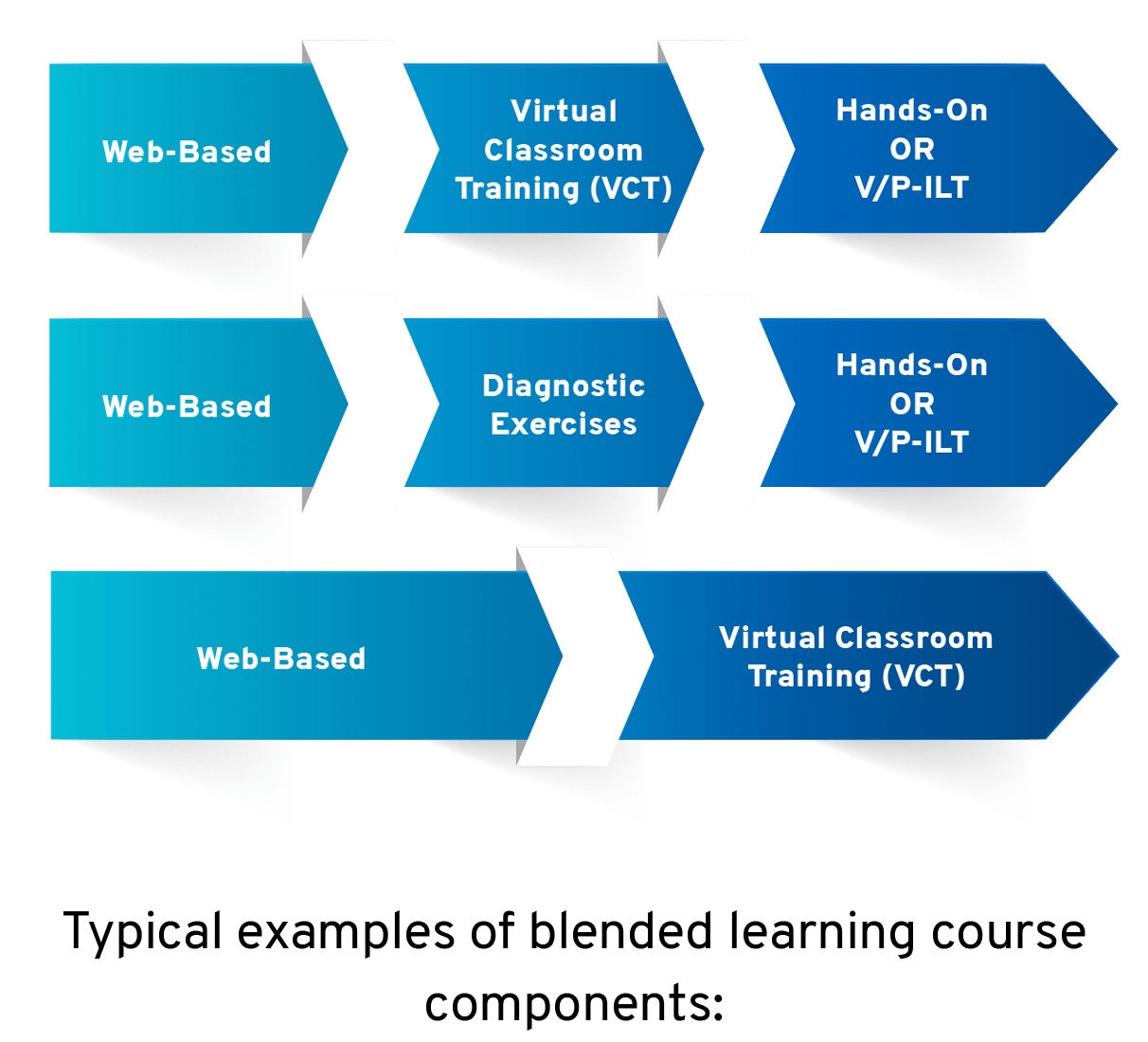
The Center of Learning enables technicians who have successfully completed a previous version of a course to conveniently get credit for a new version of the same course in their training history without having to repeat the entire course again.
2.2.2 Testing
Most courses allow for two test attempts. Technicians should review the materials carefully before taking the test; if the test attempts are exceeded, technicians will be locked out indefinitely until GM STC resets the tests on a periodic basis. Unless otherwise noted under respective course components, testing for the listed course components is as follows:
Video On Demand: Testing for content on VOD is available by going to the Course Details page in www.centerlearning.com. When the course is live and ready for viewing, service technicians should click “Launch”. When they are done viewing the course, they must click on the “Take Test” link that appears in the Video On-Demand player at the completion of the video.
The Placement Assessment process is provided by GM as a means for experienced technicians entering a GM dealership for the first time to quickly receive course credit for their knowledge, skills, and experience. Placement Assessments measure knowledge and/or skills in a given certification area and are designed to allow experienced service technicians the opportunity to test out of course components. They will not be reset if test attempts are exceeded; technicians will need to take the course to receive credit.
Successful completion of a Placement Assessment gives service technicians credit for the web-based and VCT course components and also allows them an opportunity to place out of the component (where applicable). Tests are aligned to a single component.
To take a Web-Based Placement Assessment:

2.3.1 Service Area Placement Assessments (SAPAs)
Intended for those who are new to a GM dealership and also have ASE accreditation, technicians can now take service area placement assessments to earn credit for multiple GM STC courses at once.
These service area placement assessments contain questions pertaining to multiple courses within a service area and will provide credit for each of those courses based on how the technician scores. In order to take a service area placement assessment, the technician must have the corresponding ASE certification. After completing the service area placement assessment, the system will provide the technician with their results, indicating which courses they will receive credit for and which ones they didn’t pass. Same as with the individual placement assessments, technicians only have two attempts at each service area placement assessment.
To find service area placement assessments, navigate to the Center of Learning Catalog and search for “SAPA” or the course number if you know it. You can also select the Testing tab on the main menu, and then select Service Technical, and then Service Area Placement Assessment.

Important Notes:
If a technician receives a score of 80% or greater on a series of Placement Assessments that culminate in a Hands-On course component, a link to the Hands-On Performance Checklist will appear on the test results page. Technicians may download and complete the checklist with their manager.
If both the technician and the manager agree that the technician is able to perform at least 80% of the tasks on the checklist, the manager can grant the technician credit for the Hands-On class through Center of Learning.
In order for the technician to access a performance checklist, they must have passed all the placement assessments that led up to that particular performance checklist either through individual placement assessments, the service area placement assessment, or a combination of the two. If the technician took any of the courses traditionally (meaning they opted not to test out of one via a placement assessment) they lose access to receiving the performance checklist and will need to attend the Hands-On course in order to receive credit. If the service technician successfully completes all Placement Assessments that have a Hands-On component, a link to the Hands-On Performance Checklist appears at the end of the Assessment. The checklist can then be downloaded simply by clicking the link. (Adobe Acrobat Reader 5.0 or higher is required to download the checklist.)
Each Hands-On Performance Checklist contains various tasks related to the Hands-On component. The service technician must be able to correctly perform at least 80% of the tasks listed on the checklist to receive Hands-On component credit. If the service technician can perform at least 80% of the tasks on the Performance Checklist, they should notify their service manager. The service manager can then assign Hands-On credit in www.centerlearning.com.
The service manager must ensure the service technician can perform at least 80% of the tasks contained within the Checklist. Failure to assess the service technician’s skills accurately may result in his/her not qualifying for GM Master Technician Certification.
Note: If the service technician cannot perform at least 80% of the tasks contained within the Checklist, they should enroll in the Hands-On course component.
GM Master Technician Certification Courses
Supplemental Courses
Dealer Divisional STS Courses
If a technician receives a score of 80% or greater on a series of Placement Assessments that culminate in a Hands-On course component, a link to the Hands-On Performance Checklist will appear on the test results page. Technicians may download and complete the checklist with their manager.
If both the technician and the manager agree that the technician is able to perform at least 80% of the tasks on the checklist, the manager can grant the technician credit for the Hands-On class through Center of Learning.
In order for the technician to access a performance checklist, they must have passed all the placement assessments that led up to that particular performance checklist either through individual placement assessments, the service area placement assessment, or a combination of the two. If the technician took any of the courses traditionally (meaning they opted not to test out of one via a placement assessment) they lose access to receiving the performance checklist and will need to attend the Hands-On course in order to receive credit. If the service technician successfully completes all Placement Assessments that have a Hands-On component, a link to the Hands-On Performance Checklist appears at the end of the Assessment. The checklist can then be downloaded simply by clicking the link. (Adobe Acrobat Reader 5.0 or higher is required to download the checklist.)
Each Hands-On Performance Checklist contains various tasks related to the Hands-On component. The service technician must be able to correctly perform at least 80% of the tasks listed on the checklist to receive Hands-On component credit. If the service technician can perform at least 80% of the tasks on the Performance Checklist, they should notify their service manager. The service manager can then assign Hands-On credit in www.centerlearning.com.
The service manager must ensure the service technician can perform at least 80% of the tasks contained within the Checklist. Failure to assess the service technician’s skills accurately may result in his/her not qualifying for GM Master Technician Certification.
Note: If the service technician cannot perform at least 80% of the tasks contained within the Checklist, they should enroll in the Hands-On course component.
Below is a list of all the Placement Assessments, the corresponding Service Area Placement Assessments, and the corresponding Performance Checklists.
|
Placement Assessments |
Associated Hands-On Course & Checklist |
||
|---|---|---|---|
|
Course Number |
Course Name |
Course Number |
Hands-On Course/Checklist Name |
|
00510.05WP |
Maintenance - Underhood |
10015.005H |
Introduction to Vehicle Maintenance and Inspection |
|
00510.10WP |
Maintenance – Behind the Wheel |
||
|
00510.15WP |
Maintenance Under Car |
||
|
01510.10WP |
HVAC Service |
||
|
09510.01WP |
Personal Shop Safety |
||
|
10010.00WP-R2 |
Lubrication Inspection and Maintenance |
||
|
10011.00WP |
Automotive Fluids |
||
|
10012.00WP-R2 |
Multi-Point Vehicle Inspection (MPVI) |
||
|
10041.12Wp-R2 |
Service Information (SI) Overview |
||
|
11010.00WP-R2 |
Cooling System Inspection and Maintenance |
||
|
11012.00WP-R2 |
HVAC Inspection and Maintenance |
||
|
13010.00WP-R2 |
Steering and Suspension Inspection and Maintenance |
||
|
14010.00WP-R2 |
Driveline Inspection and Maintenance |
||
|
15010.00WP-R2 |
Brakes Inspection and Maintenance |
||
|
16005.00WP |
Battery Inspection and Maintenance |
||
|
16006.00WP-R2 |
Tune Up, Inspection and Maintenance |
||
|
16048.30WP-R3 |
Global Diagnostic System (GDS) 2 |
||
|
17010.00WP-R2 |
Automatic Transmission Inspection and Maintenance |
||
|
Placement Assessments |
Associated Hands-On Course & Checklist |
||
|---|---|---|---|
|
Course Number |
Course Name |
Course Number |
Hands-On Course/Checklist Name |
|
11044.05W1P-R2 |
HVAC Systems and Operation Stage 1 |
11044.00D 11044.00E 11044.00H |
HVAC Systems & Operation V/P-ILT |
|
11044.05W2P-R2 |
HVAC Systems and Operation Stage 2 |
||
|
11044.05W3P |
HVAC Systems and Operation Stage 3 |
||
|
11044.05DP-R3 |
HVAC Systems and Operation |
||
|
Placement Assessments |
Associated Hands-On Course & Checklist |
||
|---|---|---|---|
|
Course Number |
Course Name |
Course Number |
Hands-On Course/Checklist Name |
|
12040.40W1P |
GM Moveable Roof Systems 1 |
12040.00D 12040.00E 12040.00H |
GM Roof and Waterleak/Wind Noise Management V/P-ILT |
|
12040.40W2P |
GM Moveable Roof Systems 2 |
||
|
12040.40DP |
GM Moveable Roof and Sunroof Systems |
||
|
22249.54W1P |
Waterleak & Windnoise Management 1 |
||
|
22249.54W2P |
Waterleak & Windnoise Management 2 |
||
|
22249.54W3P |
Waterleak & Windnoise Management 3 |
||
|
Placement Assessments |
Associated Hands-On Course & Checklist |
||
|---|---|---|---|
|
Course Number |
Course Name |
Course Number |
Hands-On Course/Checklist Name |
|
14041.19W1P |
Propshafts & Rear Axles: Rear Axle Operation |
14042.00D 14042.00E 14042.00H |
Truck Drivetrain Operation, Diagnosis, and Service V/P-ILT |
|
14041.19W2P |
Propshafts & Rear Axles: Drive Shaft Operation |
||
|
14041.19W3P |
Propshafts & Rear Axles: Rear Drive Modules |
||
|
14041.19W4P |
Propshafts & Rear Axles: Electronic Differentials |
||
|
14041.19W5P |
Propshafts & Rear Axles: Front Drive Axles |
||
|
14041.19W6P |
Propshafts & Rear Axles: Diagnosis |
||
|
14043.27W1P |
AWD/4WD Systems: Overview |
||
|
14043.27W2P |
AWD/4WD Systems: Passenger Car |
||
|
14043.27W3P |
AWD/4WD Systems: CUV/SUV |
||
|
14043.27DP |
Drivetrain: Diagnosis and Service |
||
|
Placement Assessments |
Associated Hands-On Course & Checklist |
||
|---|---|---|---|
|
Course Number |
Course Name |
Course Number |
Hands-On Course/Checklist Name |
|
15045.19W1P-R2 |
Braking Systems 1 – Base Brakes |
15045.00D 15045.00E 15045.00H |
GM Braking and Chassis Control Systems V/P-ILT |
|
15045.19W2P-R2 |
Braking Systems 2 – Base Brakes 2 |
||
|
15045.19W3P |
Braking Systems: Antilock Brakes |
||
|
15045.19W4P |
Braking Systems: Enhanced Applications |
||
|
15045.18D1P-R2 |
GM Braking Systems 1 |
||
|
15045.18D2P |
GM Braking Systems 2 |
||
|
13044.20W1P |
GM Chassis Control Systems 1 |
||
|
13044.20W2P |
GM Chassis Control Systems 2 |
||
|
Placement Assessments |
Associated Hands-On Course & Checklist |
||
|---|---|---|---|
|
Course Number |
Course Name |
Course Number |
Hands-On Course/Checklist Name |
|
16043.53W1P-R2 |
Gas/Diesel Engine Mechanical Diagnosis and Measurement 1: Diagnosis |
16043.00D 16043.00E 16043.00H |
Gas/Diesel Engine Mechanical Diagnosis and Measurement V/P-ILT |
|
16043.53W2P-R2 |
Gas/Diesel Engine Mechanical Diagnosis and Measurement 2: Disassembly |
||
|
16043.53W3P-R2 |
Gas/Diesel Engine Mechanical Diagnosis and Measurement 3: Inspection 1 |
||
|
16043.53W4P-R2 |
Gas/Diesel Engine Mechanical Diagnosis and Measurement 4: Inspection 2 |
||
|
16043.53W5P |
Gas/Diesel Engine Mechanical Diagnosis and Measurement 5: Assembly 1 |
||
|
16043.53W6P |
Gas/Diesel Engine Mechanical Diagnosis and Measurement 6: Assembly 2 |
||
|
16043.53W7P |
Gas/Diesel Engine Mechanical Diagnosis and Measurement 7: Unique Gasoline Procedures |
||
|
16043.53W8P-R2 |
Gas/Diesel Engine Mechanical Diagnosis and Measurement 8: Unique Diesel Procedures |
||
|
16043.53DP |
Gas/Diesel Engine Mechanical Diagnosis and Measurement |
||
|
Placement Assessments |
Associated Hands-On Course & Checklist |
||
|---|---|---|---|
|
Course Number |
Course Name |
Course Number |
Hands-On Course/Checklist Name |
|
16044.23W1P |
Engine Performance: Air Management |
16044.00D 16044.00E 16044.00H |
Engine Performance V/P-ILT |
|
16044.23W2P-R2 |
Engine Performance: Fuel and Delivery |
||
|
16044.23W3P |
Engine Performance: Ignition |
||
|
16044.23W4P-R2 |
Engine Performance: Electronic Control Systems |
||
|
16044.23W5P-R2 |
Engine Performance: Troubleshooting |
||
|
16044.23W6P |
Engine Performance: Emission Systems |
||
|
16044.24D1P |
Engine Performance 1 |
||
|
16044.23D2P |
Engine Performance 2 |
||
|
Placement Assessments |
Associated Hands-On Course & Checklist |
||
|---|---|---|---|
|
Course Number |
Course Name |
Course Number |
Hands-On Course/Checklist Name |
|
16410.02W1P-R2 |
Diesel Engine Performance 1: Overview and Features |
16410.12D 16410.12E 16410.12H |
Diesel Engine Performance: Diagnostic Strategies V/P-ILT |
|
16410.02W2P-R2 |
Diesel Engine Performance 2: Induction Systems |
||
|
16410.02W3P-R2 |
Diesel Engine Performance 3: Fuel Systems |
||
|
16410.02W4P-R2 |
Diesel Engine Performance 4: Emission Systems |
||
|
16410.02W5P-R2 |
Diesel Engine Performance 5: Exhaust Aftertreatment Systems |
||
|
16410.02W6P |
Diesel Engine Performance 6: Exhaust Gas Recirculation System |
||
|
16410.01D1P-R2 |
Diesel Engine Performance 1 |
||
|
16410.01D2P-R2 |
Diesel Engine Performance 2 |
||
|
16410.01D3P-R2 |
Diesel Engine Performance 3 |
||
|
Placement Assessments |
Associated Hands-On Course & Checklist |
||
|---|---|---|---|
|
Course Number |
Course Name |
Course Number |
Hands-On Course/Checklist Name |
|
17041.59W1P |
Automatic Transmission: Principles of Operation |
17041.00D 17041.00E 17041.00H And/Or 17041.01D 17041.01E 17041.01H |
Automatic Transmission Diagnosis and Service V/P-ILT or Automatic Transmission Mechanical Service V/P-ILT |
|
17041.59W2P |
Automatic Transmission: Mechanical Components |
||
|
17041.59W3P |
Automatic Transmission: Hydraulic Operation |
||
|
17041.59W4P |
Automatic Transmission: Inputs |
||
|
17041.59W5P |
Automatic Transmission: Outputs |
||
|
17041.59W6P |
Automatic Transmission: Powerflow |
||
|
17041.59W7P |
Automatic Transmission: Diagnosis & Service |
||
|
17041.58D1P |
Automatic Transmission Diagnosis and Service 1 |
||
|
17041.58D2P |
Automatic Transmission Diagnosis and Service 2 |
||
|
Placement Assessments |
Associated Hands-On Course & Checklist |
||
|---|---|---|---|
|
Course Number |
Course Name |
Course Number |
Hands-On Course/Checklist Name |
|
17043.39W1P |
Manual Transmission: Overview |
17043.00D 17043.00E 17043.00H |
Manual Transmission: Operation, Diagnosis, and Service V/P-ILT |
|
17043.39W2P |
Manual Transmission: FWD Operation |
||
|
17043.39W3P |
Manual Transmission: RWD Operation |
||
|
17043.39W4P |
Manual Transmission: FWD Diagnosis |
||
|
17043.39W5P |
Manual Transmission: RWD Diagnosis |
||
|
17043.39W6P |
Manual Transmission: Clutch Operations & Diagnosis |
||
|
Placement Assessments |
Associated Hands-On Course & Checklist |
||
|---|---|---|---|
|
Course Number |
Course Name |
Course Number |
Hands-On Course/Checklist Name |
|
18043.21WP |
Electrical/Electronics Stage 1 |
18043.00D 18043.00E 18043.00H And/Or 18044.00D 18044.00E 18044.00H |
Electrical Terminals and Body Electrical Systems V/P-ILT or Electrical Intermittent Concerns and Data Communication V/P-ILT |
|
18043.22WP |
Electrical/Electronics Stage 2 |
||
|
18043.23WP |
Electrical/Electronics Stage 3 |
||
|
18043.24WP |
Electrical/Electronics Stage 4 |
||
|
18043.25WP-R2 |
Electrical/Electronics Stage 5 |
||
|
18043.26WP-R2 |
Electrical/Electronics Stage 6 |
||
|
19047.09W1P |
Entry and Security Systems 1 |
||
|
19047.09W2P |
Entry and Security Systems 2 |
||
|
Placement Assessments |
Associated Hands-On Course & Checklist |
||
|---|---|---|---|
|
Course Number |
Course Name |
Course Number |
Hands-On Course/Checklist Name |
|
18044.22W1P |
GM Global Electrical Systems: Circuit Operations |
18044.01D 18044.01E 18044.01H |
GM Global Electrical Systems V/P-ILT |
|
18044.22W2P |
GM Global Electrical Systems 2 |
||
|
18044.22D1P |
GM Global Electrical Systems Session 1 |
||
|
18044.22D2P |
GM Global Electrical Systems 2 |
||
|
Placement Assessments |
Associated Hands-On Course & Checklist |
||
|---|---|---|---|
|
Course Number |
Course Name |
Course Number |
Hands-On Course/Checklist Name |
|
19047.23W1P |
Infotainment Systems 1: Radios |
19047.00D-R2 19047.00E-R2 19047.00H-R2 |
Infotainment Systems Diagnosis V/P-ILT |
|
19047.23W2P |
Infotainment Systems 2: Speakers |
||
|
19047.23W3P |
Infotainment Systems 3: Peripheral Connectivity |
||
|
19047.23W4P |
Infotainment Systems 4: Rear Entertainment Systems |
||
|
19047.23W5P |
Infotainment Systems 5: Heads-Up Display System |
||
|
19047.23W6P |
Infotainment Systems 6: Integrated Center Stack |
||
|
19047.23W7P |
Infotainment Systems 7: Next Gen Infotainment and Navigation |
||
|
19047.23W8P |
Infotainment Systems 8: Integrated Radio Systems |
||
|
19047.23D1P |
Infotainment Operation and Diagnosis |
||
|
19047.23DP-R2 |
MOST Network Diagnostics and Infotainment System Programming |
||
Below is a list of all the Placement Assessments, the corresponding Service Area Placement Assessments, and the corresponding Performance Checklists.
|
Placement Assessments |
Associated Hands-On Course & Checklist |
||
|---|---|---|---|
|
Course Number |
Course Name |
Course Number |
Hands-On Course/Checklist Name |
|
00510.05WP |
Maintenance - Underhood |
10015.005H |
Introduction to Vehicle Maintenance and Inspection |
|
00510.10WP |
Maintenance – Behind the Wheel |
||
|
00510.15WP |
Maintenance Under Car |
||
|
01510.10WP |
HVAC Service |
||
|
09510.01WP |
Personal Shop Safety |
||
|
10010.00WP-R2 |
Lubrication Inspection and Maintenance |
||
|
10011.00WP |
Automotive Fluids |
||
|
10012.00WP-R2 |
Multi-Point Vehicle Inspection (MPVI) |
||
|
10041.12Wp-R2 |
Service Information (SI) Overview |
||
|
11010.00WP-R2 |
Cooling System Inspection and Maintenance |
||
|
11012.00WP-R2 |
HVAC Inspection and Maintenance |
||
|
13010.00WP-R2 |
Steering and Suspension Inspection and Maintenance |
||
|
14010.00WP-R2 |
Driveline Inspection and Maintenance |
||
|
15010.00WP-R2 |
Brakes Inspection and Maintenance |
||
|
16005.00WP |
Battery Inspection and Maintenance |
||
|
16006.00WP-R2 |
Tune Up, Inspection and Maintenance |
||
|
16048.30WP-R3 |
Global Diagnostic System (GDS) 2 |
||
|
17010.00WP-R2 |
Automatic Transmission Inspection and Maintenance |
||
|
Placement Assessments |
Associated Hands-On Course & Checklist |
||
|---|---|---|---|
|
Course Number |
Course Name |
Course Number |
Hands-On Course/Checklist Name |
|
11044.05W1P-R2 |
HVAC Systems and Operation Stage 1 |
11044.00D 11044.00E 11044.00H |
HVAC Systems & Operation V/P-ILT |
|
11044.05W2P-R2 |
HVAC Systems and Operation Stage 2 |
||
|
11044.05W3P |
HVAC Systems and Operation Stage 3 |
||
|
11044.05DP-R3 |
HVAC Systems and Operation |
||
|
Placement Assessments |
Associated Hands-On Course & Checklist |
||
|---|---|---|---|
|
Course Number |
Course Name |
Course Number |
Hands-On Course/Checklist Name |
|
12040.40W1P |
GM Moveable Roof Systems 1 |
12040.00D 12040.00E 12040.00H |
GM Roof and Waterleak/Wind Noise Management V/P-ILT |
|
12040.40W2P |
GM Moveable Roof Systems 2 |
||
|
12040.40DP |
GM Moveable Roof and Sunroof Systems |
||
|
22249.54W1P |
Waterleak & Windnoise Management 1 |
||
|
22249.54W2P |
Waterleak & Windnoise Management 2 |
||
|
22249.54W3P |
Waterleak & Windnoise Management 3 |
||
|
Placement Assessments |
Associated Hands-On Course & Checklist |
||
|---|---|---|---|
|
Course Number |
Course Name |
Course Number |
Hands-On Course/Checklist Name |
|
14041.19W1P |
Propshafts & Rear Axles: Rear Axle Operation |
14042.00D 14042.00E 14042.00H |
Truck Drivetrain Operation, Diagnosis, and Service V/P-ILT |
|
14041.19W2P |
Propshafts & Rear Axles: Drive Shaft Operation |
||
|
14041.19W3P |
Propshafts & Rear Axles: Rear Drive Modules |
||
|
14041.19W4P |
Propshafts & Rear Axles: Electronic Differentials |
||
|
14041.19W5P |
Propshafts & Rear Axles: Front Drive Axles |
||
|
14041.19W6P |
Propshafts & Rear Axles: Diagnosis |
||
|
14043.27W1P |
AWD/4WD Systems: Overview |
||
|
14043.27W2P |
AWD/4WD Systems: Passenger Car |
||
|
14043.27W3P |
AWD/4WD Systems: CUV/SUV |
||
|
14043.27DP |
Drivetrain: Diagnosis and Service |
||
|
Placement Assessments |
Associated Hands-On Course & Checklist |
||
|---|---|---|---|
|
Course Number |
Course Name |
Course Number |
Hands-On Course/Checklist Name |
|
15045.19W1P-R2 |
Braking Systems 1 – Base Brakes |
15045.00D 15045.00E 15045.00H |
GM Braking and Chassis Control Systems V/P-ILT |
|
15045.19W2P-R2 |
Braking Systems 2 – Base Brakes 2 |
||
|
15045.19W3P |
Braking Systems: Antilock Brakes |
||
|
15045.19W4P |
Braking Systems: Enhanced Applications |
||
|
15045.18D1P-R2 |
GM Braking Systems 1 |
||
|
15045.18D2P |
GM Braking Systems 2 |
||
|
13044.20W1P |
GM Chassis Control Systems 1 |
||
|
13044.20W2P |
GM Chassis Control Systems 2 |
||
|
Placement Assessments |
Associated Hands-On Course & Checklist |
||
|---|---|---|---|
|
Course Number |
Course Name |
Course Number |
Hands-On Course/Checklist Name |
|
16043.53W1P-R2 |
Gas/Diesel Engine Mechanical Diagnosis and Measurement 1: Diagnosis |
16043.00D 16043.00E 16043.00H |
Gas/Diesel Engine Mechanical Diagnosis and Measurement V/P-ILT |
|
16043.53W2P-R2 |
Gas/Diesel Engine Mechanical Diagnosis and Measurement 2: Disassembly |
||
|
16043.53W3P-R2 |
Gas/Diesel Engine Mechanical Diagnosis and Measurement 3: Inspection 1 |
||
|
16043.53W4P-R2 |
Gas/Diesel Engine Mechanical Diagnosis and Measurement 4: Inspection 2 |
||
|
16043.53W5P |
Gas/Diesel Engine Mechanical Diagnosis and Measurement 5: Assembly 1 |
||
|
16043.53W6P |
Gas/Diesel Engine Mechanical Diagnosis and Measurement 6: Assembly 2 |
||
|
16043.53W7P |
Gas/Diesel Engine Mechanical Diagnosis and Measurement 7: Unique Gasoline Procedures |
||
|
16043.53W8P-R2 |
Gas/Diesel Engine Mechanical Diagnosis and Measurement 8: Unique Diesel Procedures |
||
|
16043.53DP |
Gas/Diesel Engine Mechanical Diagnosis and Measurement |
||
|
Placement Assessments |
Associated Hands-On Course & Checklist |
||
|---|---|---|---|
|
Course Number |
Course Name |
Course Number |
Hands-On Course/Checklist Name |
|
16044.23W1P |
Engine Performance: Air Management |
16044.00D 16044.00E 16044.00H |
Engine Performance V/P-ILT |
|
16044.23W2P-R2 |
Engine Performance: Fuel and Delivery |
||
|
16044.23W3P |
Engine Performance: Ignition |
||
|
16044.23W4P-R2 |
Engine Performance: Electronic Control Systems |
||
|
16044.23W5P-R2 |
Engine Performance: Troubleshooting |
||
|
16044.23W6P |
Engine Performance: Emission Systems |
||
|
16044.24D1P |
Engine Performance 1 |
||
|
16044.23D2P |
Engine Performance 2 |
||
|
Placement Assessments |
Associated Hands-On Course & Checklist |
||
|---|---|---|---|
|
Course Number |
Course Name |
Course Number |
Hands-On Course/Checklist Name |
|
16410.02W1P-R2 |
Diesel Engine Performance 1: Overview and Features |
16410.12D 16410.12E 16410.12H |
Diesel Engine Performance: Diagnostic Strategies V/P-ILT |
|
16410.02W2P-R2 |
Diesel Engine Performance 2: Induction Systems |
||
|
16410.02W3P-R2 |
Diesel Engine Performance 3: Fuel Systems |
||
|
16410.02W4P-R2 |
Diesel Engine Performance 4: Emission Systems |
||
|
16410.02W5P-R2 |
Diesel Engine Performance 5: Exhaust Aftertreatment Systems |
||
|
16410.02W6P |
Diesel Engine Performance 6: Exhaust Gas Recirculation System |
||
|
16410.01D1P-R2 |
Diesel Engine Performance 1 |
||
|
16410.01D2P-R2 |
Diesel Engine Performance 2 |
||
|
16410.01D3P-R2 |
Diesel Engine Performance 3 |
||
|
Placement Assessments |
Associated Hands-On Course & Checklist |
||
|---|---|---|---|
|
Course Number |
Course Name |
Course Number |
Hands-On Course/Checklist Name |
|
17041.59W1P |
Automatic Transmission: Principles of Operation |
17041.00D 17041.00E 17041.00H And/Or 17041.01D 17041.01E 17041.01H |
Automatic Transmission Diagnosis and Service V/P-ILT or Automatic Transmission Mechanical Service V/P-ILT |
|
17041.59W2P |
Automatic Transmission: Mechanical Components |
||
|
17041.59W3P |
Automatic Transmission: Hydraulic Operation |
||
|
17041.59W4P |
Automatic Transmission: Inputs |
||
|
17041.59W5P |
Automatic Transmission: Outputs |
||
|
17041.59W6P |
Automatic Transmission: Powerflow |
||
|
17041.59W7P |
Automatic Transmission: Diagnosis & Service |
||
|
17041.58D1P |
Automatic Transmission Diagnosis and Service 1 |
||
|
17041.58D2P |
Automatic Transmission Diagnosis and Service 2 |
||
|
Placement Assessments |
Associated Hands-On Course & Checklist |
||
|---|---|---|---|
|
Course Number |
Course Name |
Course Number |
Hands-On Course/Checklist Name |
|
17043.39W1P |
Manual Transmission: Overview |
17043.00D 17043.00E 17043.00H |
Manual Transmission: Operation, Diagnosis, and Service V/P-ILT |
|
17043.39W2P |
Manual Transmission: FWD Operation |
||
|
17043.39W3P |
Manual Transmission: RWD Operation |
||
|
,17043.39W4P |
Manual Transmission: FWD Diagnosis |
||
|
17043.39W5P |
Manual Transmission: RWD Diagnosis |
||
|
17043.39W6P |
Manual Transmission: Clutch Operations & Diagnosis |
||
|
Placement Assessments |
Associated Hands-On Course & Checklist |
||
|---|---|---|---|
|
Course Number |
Course Name |
Course Number |
Hands-On Course/Checklist Name |
|
18043.21WP |
Electrical/Electronics Stage 1 |
18043.00D 18043.00E 18043.00H And/Or 18044.00D 18044.00E 18044.00H |
Electrical Terminals and Body Electrical Systems V/P-ILT or Electrical Intermittent Concerns and Data Communication V/P-ILT |
|
18043.22WP |
Electrical/Electronics Stage 2 |
||
|
18043.23WP |
Electrical/Electronics Stage 3 |
||
|
18043.24WP |
Electrical/Electronics Stage 4 |
||
|
18043.25WP-R2 |
Electrical/Electronics Stage 5 |
||
|
18043.26WP-R2 |
Electrical/Electronics Stage 6 |
||
|
19047.09W1P |
Entry and Security Systems 1 |
||
|
19047.09W2P |
Entry and Security Systems 2 |
||
|
Placement Assessments |
Associated Hands-On Course & Checklist |
||
|---|---|---|---|
|
Course Number |
Course Name |
Course Number |
Hands-On Course/Checklist Name |
|
18044.22W1P |
GM Global Electrical Systems: Circuit Operations |
18044.01D 18044.01E 18044.01H |
GM Global Electrical Systems V/P-ILT |
|
18044.22W2P |
GM Global Electrical Systems 2 |
||
|
18044.22D1P |
GM Global Electrical Systems Session 1 |
||
|
18044.22D2P |
GM Global Electrical Systems 2 |
||
|
Placement Assessments |
Associated Hands-On Course & Checklist |
||
|---|---|---|---|
|
Course Number |
Course Name |
Course Number |
Hands-On Course/Checklist Name |
|
19047.23W1P |
Infotainment Systems 1: Radios |
19047.00D-R2 19047.00E-R2 19047.00H-R2 |
Infotainment Systems Diagnosis V/P-ILT |
|
19047.23W2P |
Infotainment Systems 2: Speakers |
||
|
19047.23W3P |
Infotainment Systems 3: Peripheral Connectivity |
||
|
19047.23W4P |
Infotainment Systems 4: Rear Entertainment Systems |
||
|
19047.23W5P |
Infotainment Systems 5: Heads-Up Display System |
||
|
19047.23W6P |
Infotainment Systems 6: Integrated Center Stack |
||
|
19047.23W7P |
Infotainment Systems 7: Next Gen Infotainment and Navigation |
||
|
19047.23W8P |
Infotainment Systems 8: Integrated Radio Systems |
||
|
19047.23D1P |
Infotainment Operation and Diagnosis |
||
|
19047.23DP-R2 |
MOST Network Diagnostics and Infotainment System Programming |
||

3.3.1 Other Feedback Mechanisms
GM’s Customer Care and Aftersales division provides Dealer Satisfaction Survey results to GM STC to gauge service managers’ opinions of GM STC training products. The survey results provide valuable input for short-term and long-term improvement initiatives, ensuring continuous improvement to the GM STC program.
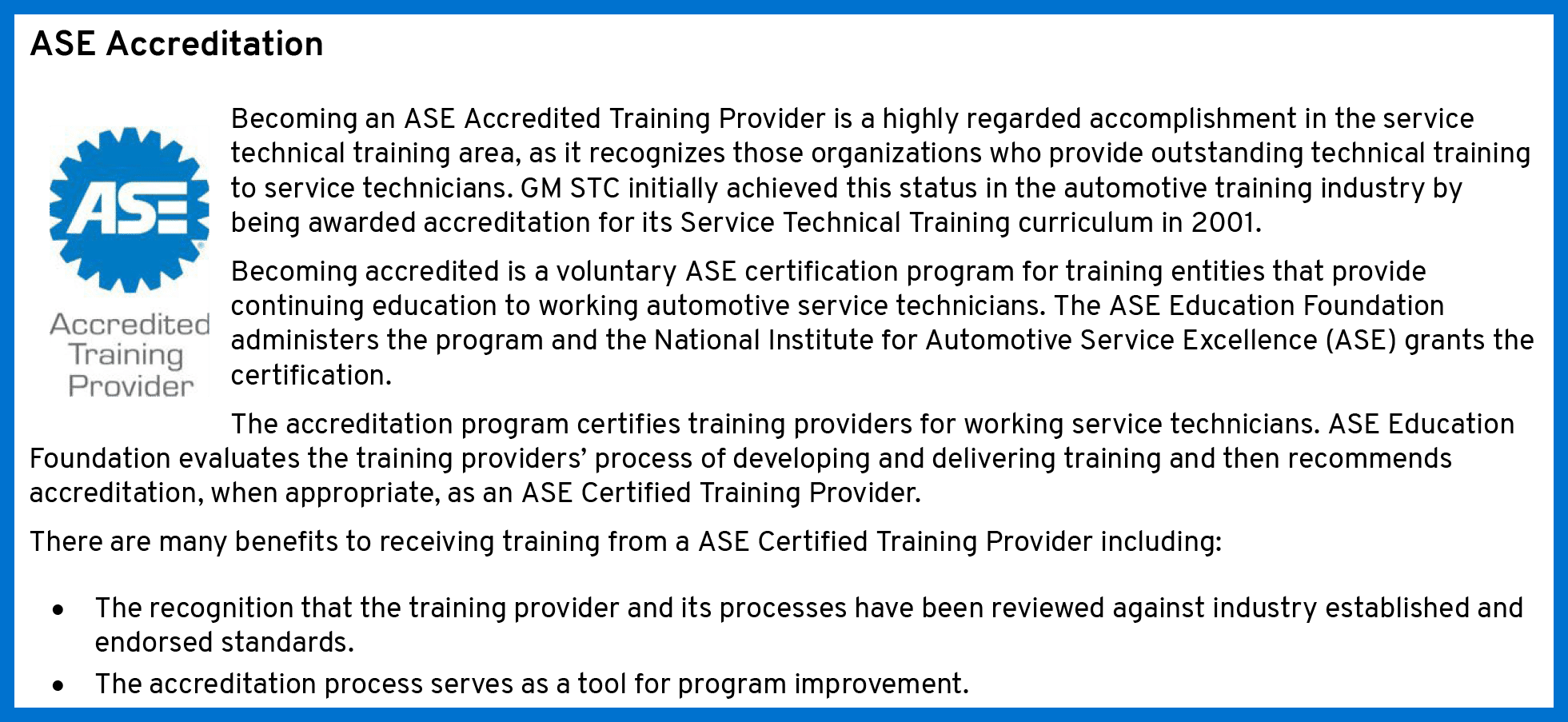
To attain MTC, the technician must be 100% STS in both Silver and Gold and complete all MTC components. GM MTC Assessment is a performance-based event in which each service technician must demonstrate knowledge and diagnostic skills. During the GM MTC event, each service technician is required to solve real vehicle faults by applying the accumulated learning from all courses in the Certification Area. The GM MTC Assessment Program covers 13 of the 15 service categories (it excludes Fundamentals and Emerging Issues.) MTC assessments are administered at training locations across the country.
The GM MTC Assessment contains a comprehension component and a practical evaluation to assess the service technician’s knowledge and diagnostic skills. Each Assessment consists of timed exercises that have been developed based upon the critical elements of the courses across the Certification Area and real-life concerns.
To achieve GM Master Technician Certification, a service technician must successfully pass the GM STC Certification Event and be ASE certified in that area.
GM STC recognizes a one-year certification with an annual renewal on Master Technician Certifications. The MTC program allows service technicians to retain their certification if they are at 100% on their STS training requirements.
Once a service technician successfully completes a MTC assessment, that service technician will remain Master Technician Certified as long as they continue to meet their STS requirements for the area(s) in which they are certified. The service technician must maintain their ASE Certification for that category as well.
The Service Technician Assessment Process is as follows:
Each exercise is designed to assess each service technician’s ability to diagnose and apply skills with a simulated real-life customer concern using cross-divisional vehicles.
To successfully complete a Certification Event, the service technician must obtain a total score of 80% or better across the performance-based exercises. During the assessment, a certifier who has received extensive training in conducting performance-based assessments evaluates the service technician’s skills. A service technician who receives GM MTC status receives the following items:

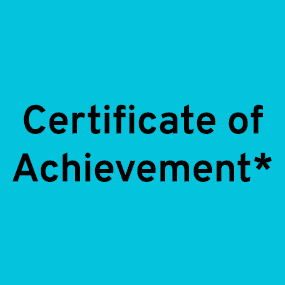

*Only the first certificate will be mailed. Additional Certificates are available for download online.
**Additional GM patches are available for purchase through the Center of Learning Help Desk.
If a service technician does not satisfy all of the assessment requirements, a letter indicating the areas for improvement is provided to the service technician.
The service technician’s Learning Path and the STS/MTC tables define the courses in an area that must be completed before the service technician may enroll for the Certification Event. Service technicians can enroll for a Certification Event in the same manner they would for a course component.
During the enrollment process, the service technician is given the option to download:
Additionally, on each of the ASE Certification pages on the Center of Learning, technicians can download an ASE Prep Guide to help them prepare for their needed ASE Certifications. Below is a table listing the required ASE Certifications for each Service Area MTC.
|
Mechanical |
|
|---|---|
|
Course |
ASE Requirement |
|
Electrical/Electronics |
A6 |
|
Engine Repair |
A1 |
|
Heating, Ventilation, and Air Conditioning |
A7 |
|
Brakes |
A5 |
|
Steering and Suspension |
A4 |
|
Manual Drivetrain and Axle |
A3 |
|
Automatic Transmission/Tranaxle |
A2 |
|
Engine Performance |
A8 and L1 |
|
or |
or |
|
Diesel Engine Performance |
A9 |
Cadillac franchised Dealers have the opportunity to select Cadillac-branded Master Technician Certification (MTC) and World Class Technician (WCT) patches for their technicians. Cadillac Certified Service, in partnership with the Cadillac Dealer Council, implemented this new, creative solution to help Cadillac Dealers recognize their highest achieving technicians. To further elevate the role of our Cadillac technicians, Cadillac franchised dealers can edit existing and new technician profiles to indicate their dealer’s patch preference.
Note: These Cadillac patches will not match the existing MTC or WCT patches. Cadillac Dealers can order additional patches their technicians’ are qualified for at an extra cost.
The decision to switch to Cadillac-branded patches is a dealer decision, NOT an individual technician decision. To change your preferences from GM-branded to Cadillac-branded patches, first coordinate with your Service Manager to approve that your dealer is making the switch.
For the step-by-step instruction on how to update your patch preference, refer to the Cadillac-branded Patches Job Aid on the Center of Learning through the Help/Support button.
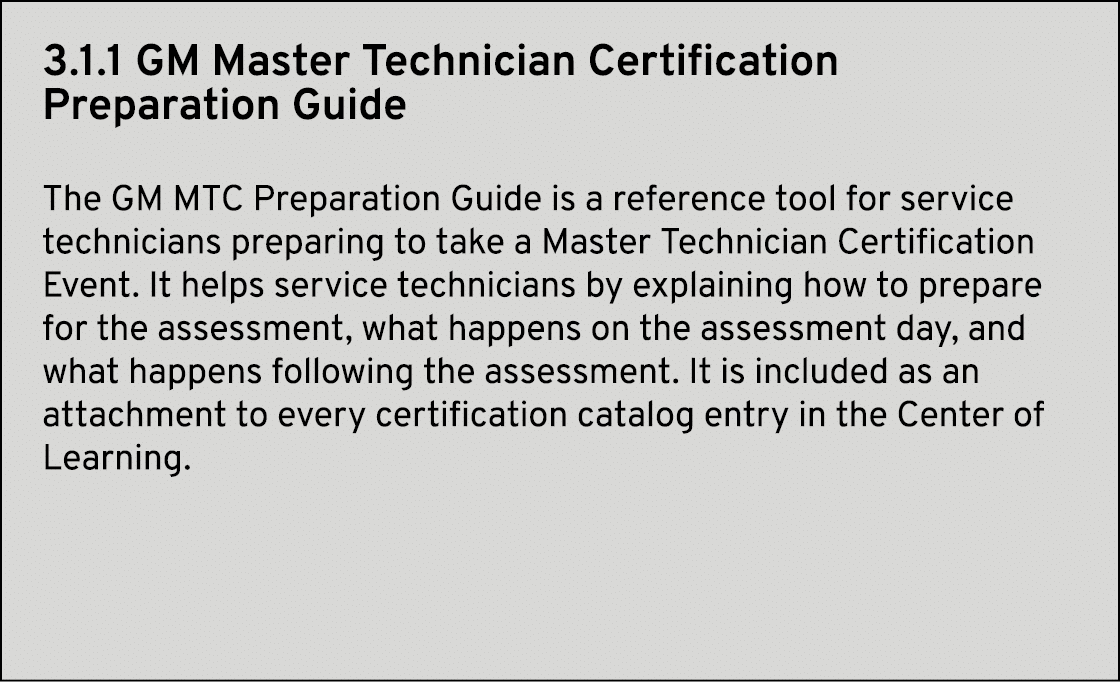
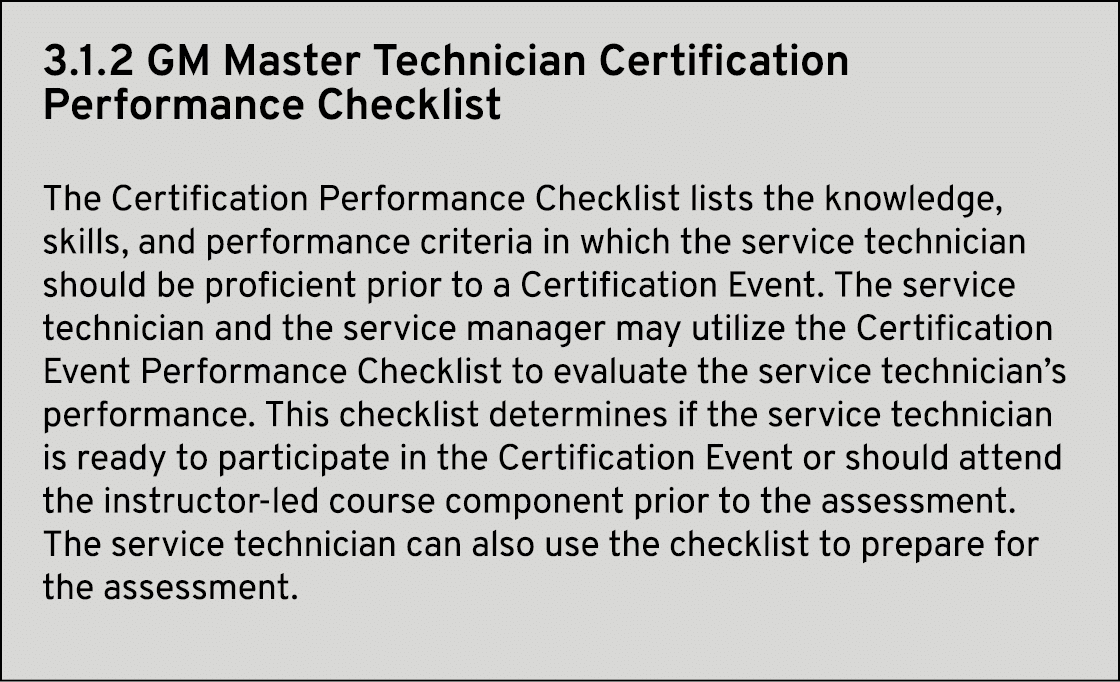
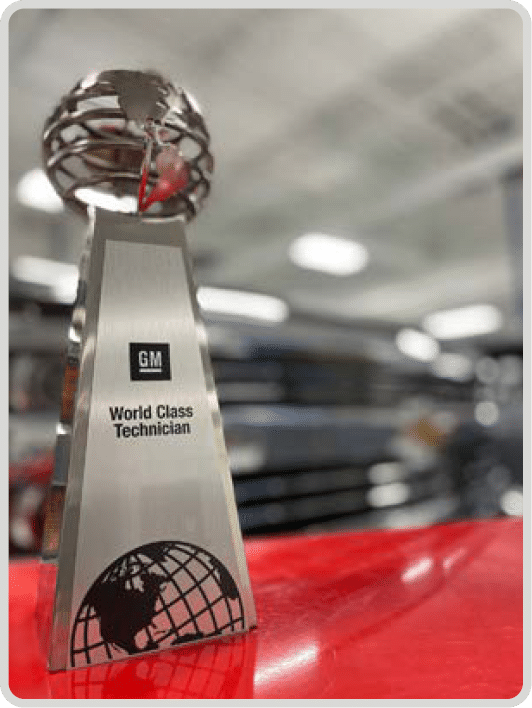
A technician can achieve GM World Class Technician status in the Mechanical area. It’s achieved when a technician successfully completes all related training and the appropriate Master Technician Certifications.
Service technicians can achieve WCT status in the Mechanical area when they successfully achieve eight of nine MTCs with their accompanying ASE Certifications. They have a choice of completing either Engine Performance or Diesel Engine Performance along with seven mechanical-related certifications: Engine Repair, Automatic Transmission/Transaxle, Manual Drivetrain and Axle, Steering and Suspension, Brakes, Electrical/Electronics, and HVAC.
Technicians who receive World Class Technician status receive a gift package that includes the following:
The GM STC program has an evaluation system in place to measure the effectiveness of the performance-based curriculum and the delivery media. GM STC evaluates the performance of the training program at four levels:
To attain MTC, the technician must be 100% STS in both Silver and Gold and complete all MTC components. GM MTC Assessment is a performance-based event in which each service technician must demonstrate knowledge and diagnostic skills. During the GM MTC event, each service technician is required to solve real vehicle faults by applying the accumulated learning from all courses in the Certification Area. The GM MTC Assessment Program covers 13 of the 15 service categories (it excludes Fundamentals and Emerging Issues.) MTC assessments are administered at training locations across the country.
The GM MTC Assessment contains a comprehension component and a practical evaluation to assess the service technician’s knowledge and diagnostic skills. Each Assessment consists of timed exercises that have been developed based upon the critical elements of the courses across the Certification Area and real-life concerns.
To achieve GM Master Technician Certification, a service technician must successfully pass the GM STC Certification Event and be ASE certified in that area.
GM STC recognizes a one-year certification with an annual renewal on Master Technician Certifications. The MTC program allows service technicians to retain their certification if they are at 100% on their STS training requirements.
Once a service technician successfully completes a MTC assessment, that service technician will remain Master Technician Certified as long as they continue to meet their STS requirements for the area(s) in which they are certified. The service technician must maintain their ASE Certification for that category as well.
The Service Technician Assessment Process is as follows:
Each exercise is designed to assess each service technician’s ability to diagnose and apply skills with a simulated real-life customer concern using cross-divisional vehicles.
To successfully complete a Certification Event, the service technician must obtain a total score of 80% or better across the performance-based exercises. During the assessment, a certifier who has received extensive training in conducting performance-based assessments evaluates the service technician’s skills. A service technician who receives GM MTC status receives the following items:

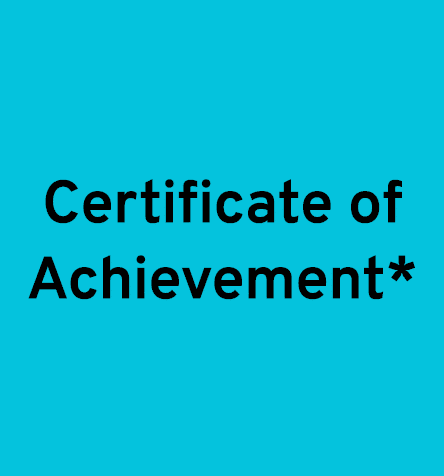

*Only the first certificate will be mailed. Additional Certificates are available for download online.
**Additional GM patches are available for purchase through the Center of Learning Help Desk.
If a service technician does not satisfy all of the assessment requirements, a letter indicating the areas for improvement is provided to the service technician.
The service technician’s Learning Path and the STS/MTC tables define the courses in an area that must be completed before the service technician may enroll for the Certification Event. Service technicians can enroll for a Certification Event in the same manner they would for a course component. During the enrollment process, the service technician is given the option to download:
Additionally, on each of the ASE Certification pages on the Center of Learning, technicians can download an ASE Prep Guide to help them prepare for their needed ASE Certifications. Below is a table listing the required ASE Certifications for each Service Area MTC.
|
Mechanical |
|
|---|---|
|
Course |
ASE Requirement |
|
Electrical/Electronics |
A6 |
|
Engine Repair |
A1 |
|
Heating, Ventilation, and Air Conditioning |
A7 |
|
Brakes |
A5 |
|
Steering and Suspension |
A4 |
|
Manual Drivetrain and Axle |
A3 |
|
Automatic Transmission/Tranaxle |
A2 |
|
Engine Performance |
A8 and L1 |
|
or |
or |
|
Diesel Engine Performance |
A9 |
Cadillac franchised Dealers have the opportunity to select Cadillac-branded Master Technician Certification (MTC) and World Class Technician (WCT) patches for their technicians. Cadillac Certified Service, in partnership with the Cadillac Dealer Council, implemented this new, creative solution to help Cadillac Dealers recognize their highest achieving technicians. To further elevate the role of our Cadillac technicians, Cadillac franchised dealers can edit existing and new technician profiles to indicate their dealer’s patch preference.
Note: These Cadillac patches will not match the existing MTC or WCT patches. Cadillac Dealers can order additional patches their technicians’ are qualified for at an extra cost.
The decision to switch to Cadillac-branded patches is a dealer decision, NOT an individual technician decision. To change your preferences from GM-branded to Cadillac-branded patches, first coordinate with your Service Manager to approve that your dealer is making the switch.
For the step-by-step instruction on how to update your patch preference, refer to the Cadillac-branded Patches Job Aid on the Center of Learning through the Help/Support button.
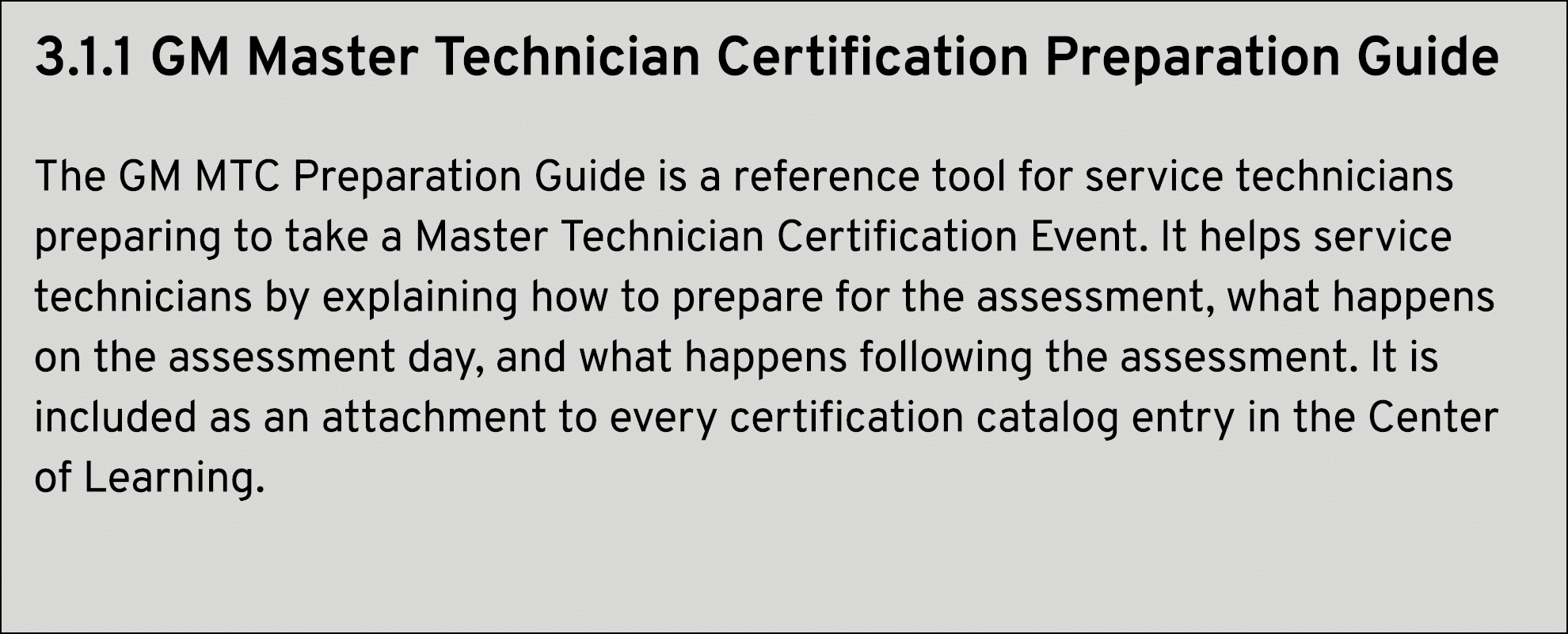
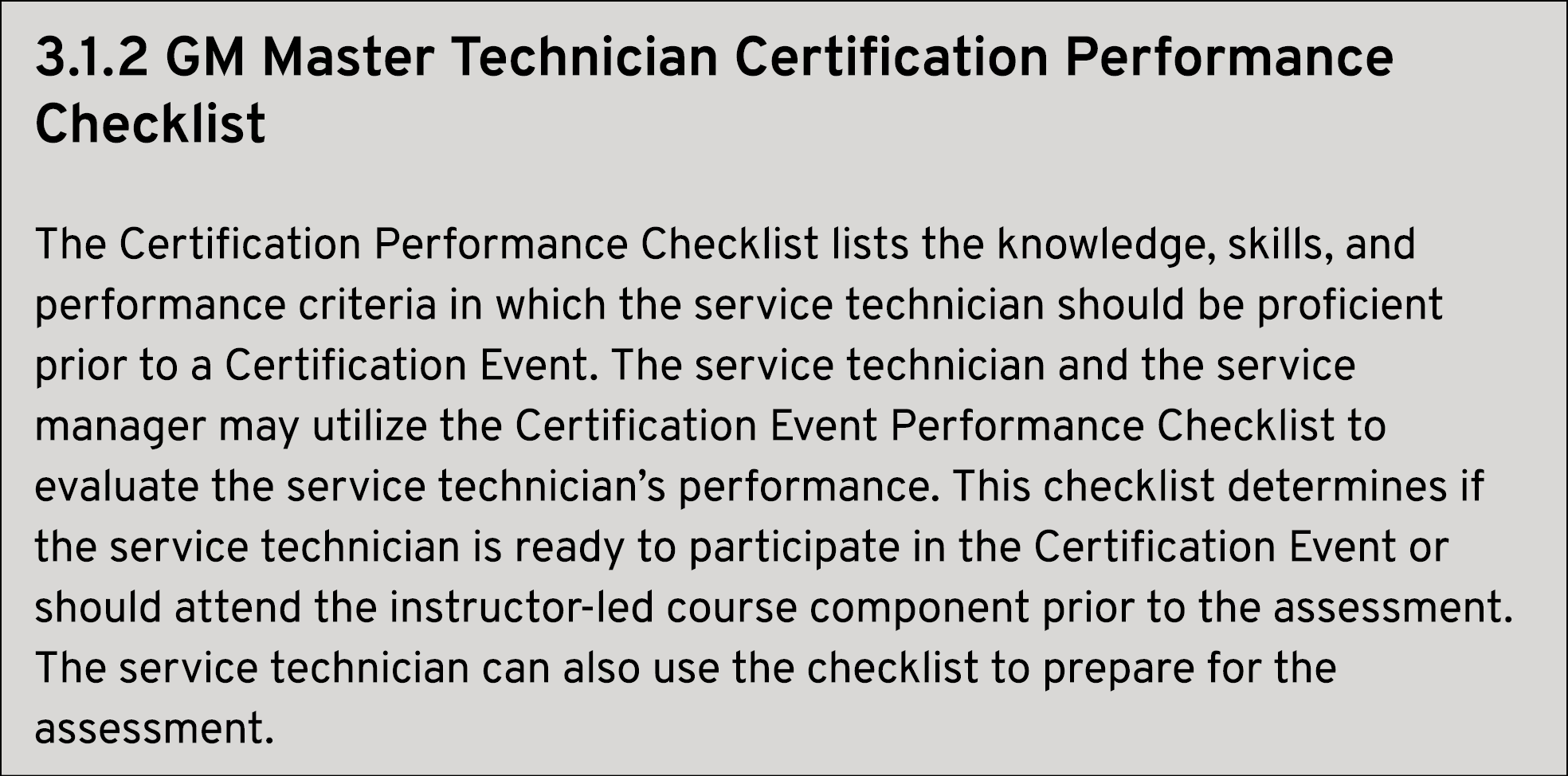
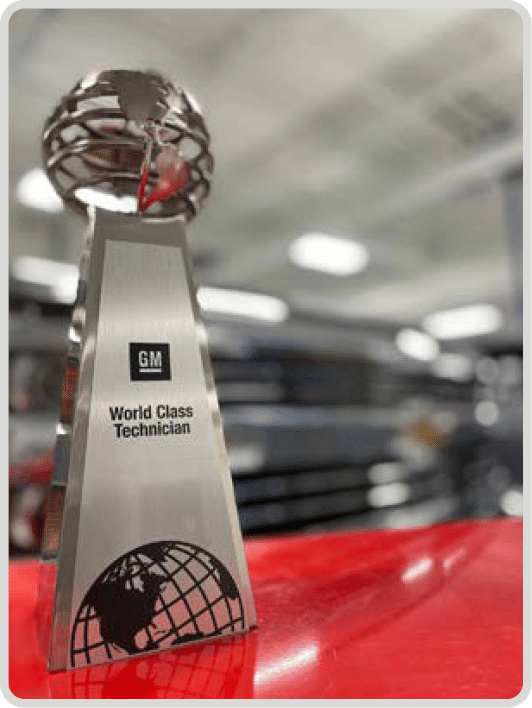
A technician can achieve GM World Class Technician status in the Mechanical area. It’s achieved when a technician successfully completes all related training and the appropriate Master Technician Certifications.
Service technicians can achieve WCT status in the Mechanical area when they successfully achieve eight of nine MTCs with their accompanying ASE Certifications. They have a choice of completing either Engine Performance or Diesel Engine Performance along with seven mechanical-related certifications: Engine Repair, Automatic Transmission/Transaxle, Manual Drivetrain and Axle, Steering and Suspension, Brakes, Electrical/Electronics, and HVAC.
Technicians who receive World Class Technician status receive a gift package that includes the following:
The GM STC program has an evaluation system in place to measure the effectiveness of the performance-based curriculum and the delivery media. GM STC evaluates the performance of the training program at four levels:

3.3.1 Other Feedback Mechanisms
GM’s Customer Care and Aftersales division provides Dealer Satisfaction Survey results to GM STC to gauge service managers’ opinions of GM STC training products. The survey results provide valuable input for short-term and long-term improvement initiatives, ensuring continuous improvement to the GM STC program.
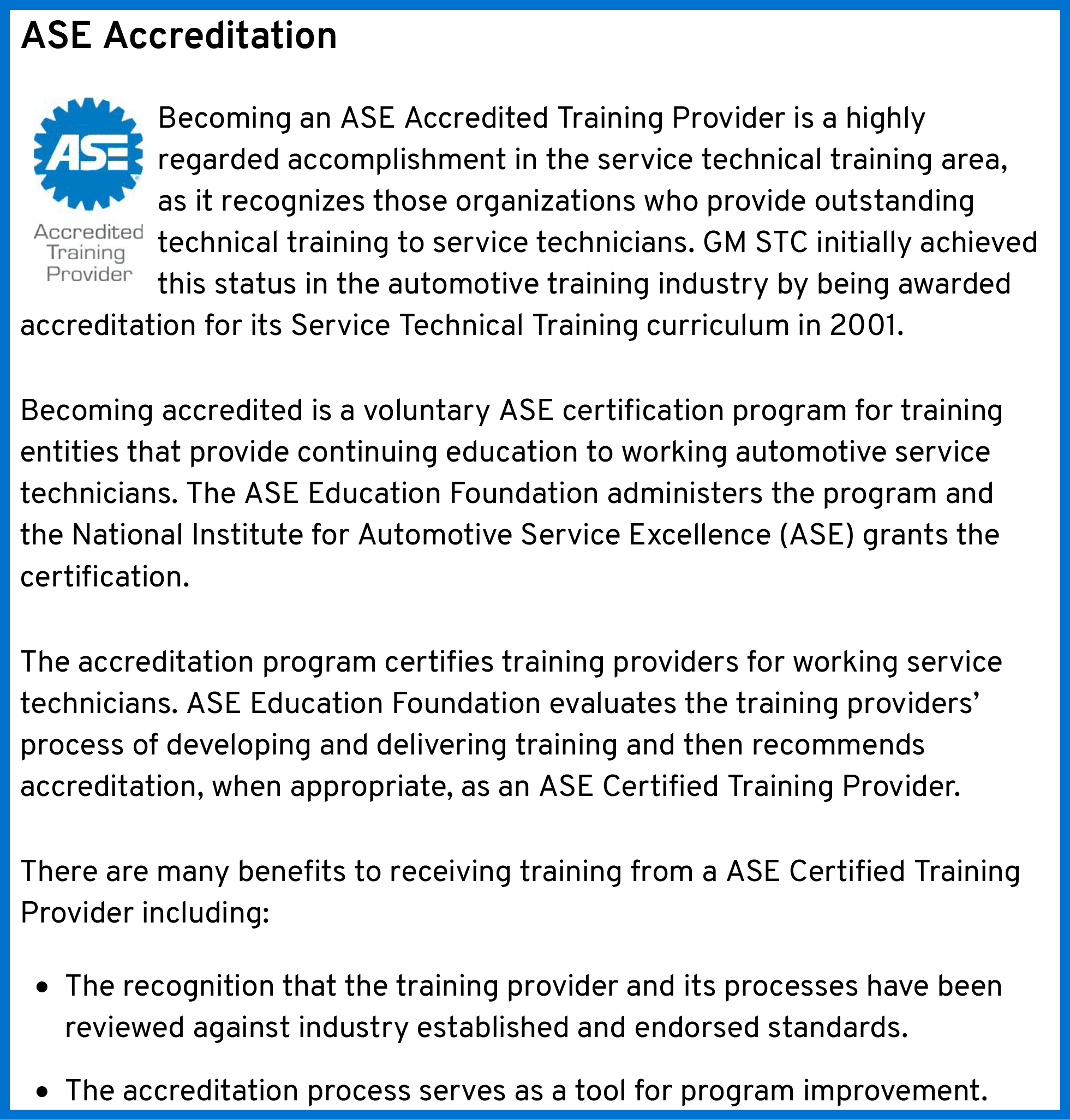

GM STC curriculum is designed to meet two requirements: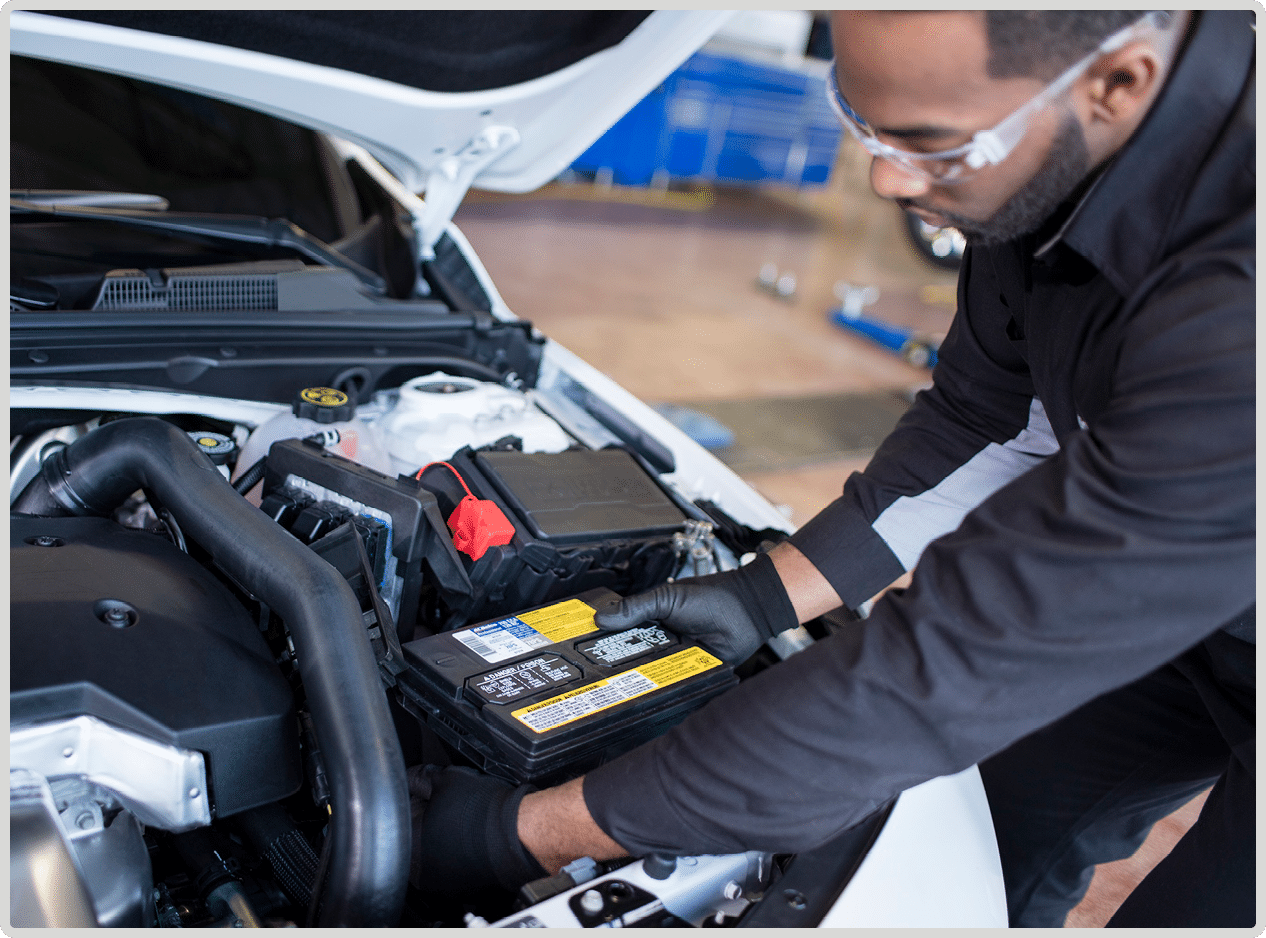
This dual nature of the GM STC curriculum is represented within the training categories defined in each training path: Bronze, Silver, Gold, and Master Technician Certification (MTC).
Any course in the GM STC program is available to an active GM service technician provided prerequisites have been met.
The Fundamentals Learning Path contains all the Bronze level requirements, and every technician must complete them in order to achieve 100% STS. The Silver, Gold, and MTC level requirements are found within the other Learning Paths. All Silver level requirements can be completed in dealership. Gold level requirements have an in-person component which must be completed at a training center. MTC level requirements include the ASE Certification and the Master Technician Certification Assessment for that Learning Path.
On the STS Report (available to dealer service managers), empty cells to the right of the service technician’s name in a Certification Area indicate that the course is required for the dealership. In many cases, the STS and MTC requirements are the same. Please refer to the STS Report, Learning Path, and the Technician Training Gap Report for a complete list of training needs. When a service technician successfully completes a course that is listed on both the Learning Path and the STS Report, credit is given for both.
4.1.1 Learning Paths for GM Master Technician Certification
Every GM service technician can choose a Learning Path that includes the requirements for the GM MTC. This Learning Path assists the service technician in identifying the courses to take for a specific Certification Area. A service technician’s Learning Path will carry over from year to year; however, it should be checked at the beginning of each year for changed requirements.
It is important to note on the Learning Path that a course may consist of two, three, or four component delivery media. For example, the GM Global Electrical Systems course (18044.22) is actually delivered as four different components, using different media: Web-Based Training (W1 and W2), and Virtual Classroom Training (D1 and D2). This is shown on the Learning Path as four separate numbers, each with the same 7-digit core course number and a suffix letter/number to denote the delivery medium and, if appropriate, the release number.
In response to dealer feedback, we changed how the dealer size is calculated and the impact on Service Training Standards (STS) for all dealers. GM STC worked with the Dealer Fixed Operations Advisory Board (DFOAB) to develop a methodology that aligns service training with overall technical training goals to deliver a truly exceptional service experience for our customers.
Individual dealer STS requirements are determined by a dealer’s Repair Order (RO) count rather than VINs sold. The RO data includes both warranty and customer pay. This data excludes claims that would normally happen before the sale (for example, Pre Delivery Inspection and transportation claims) and stand-alone internal ROs.
The benefits of this change include:
A business rule prevents dealers from changing more than one size per year.
4.2.1 Additional Information
|
Date |
Details |
|---|---|
|
September, current year |
Dealer notified of pending changes via GlobalConnect message. |
|
October, current year |
District Service Manager (DVM) notifies dealers if their group will change for STS requirements. |
|
January, new year |
STS requirements based on Repair Order (RO) count become effective. |
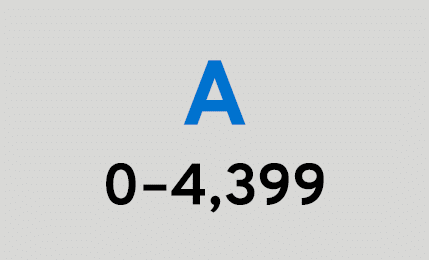
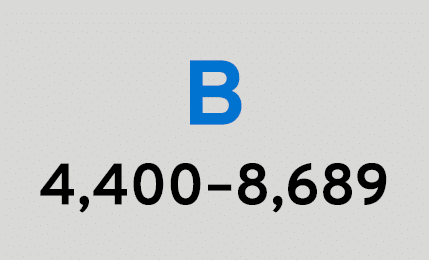
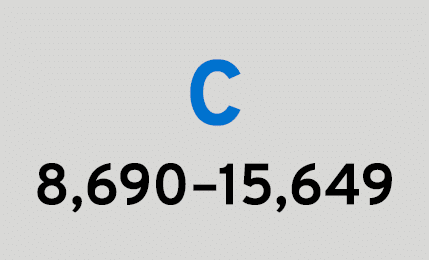
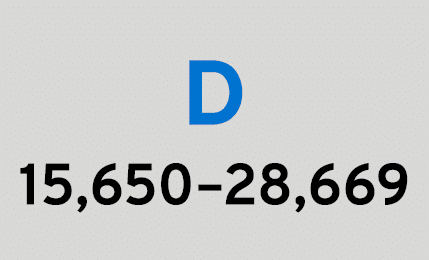
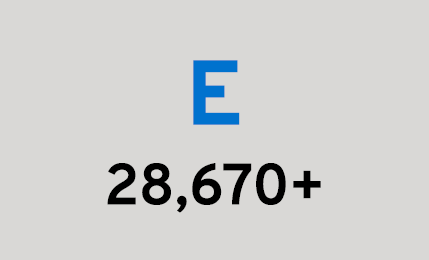
This chart identifies the minimum number of technicians required to meet STS.
|
Service Category |
A |
B |
C |
D |
E |
|
|---|---|---|---|---|---|---|
|
1 |
Fundamentals |
All |
All |
All |
All |
All |
|
2 |
Emerging Issues |
2 |
2 |
2 |
2 |
2 |
|
3 |
Engine Repair |
2 |
2 |
3 |
2 |
3 |
|
4 |
Automatic Transmission/Transaxle |
2 |
2 |
2 |
2 |
3 |
|
5 |
Steering and Suspension |
2 |
2 |
3 |
3 |
4 |
|
6 |
Electrical/Electronics |
2 |
2 |
4 |
5 |
6 |
|
7 |
Heating, Ventilation, and Air Conditioning (HVAC) |
2 |
2 |
3 |
3 |
4 |
|
8 |
Brakes |
2 |
2 |
3 |
3 |
4 |
|
9 |
Engine Performance |
2 |
2 |
3 |
4 |
5 |
|
10 |
Manual Drivetrain and Axle |
2 |
2 |
2 |
2 |
3 |
|
11 |
Diesel Engine Performance |
2 |
2 |
3 |
2 |
2 |
|
12 |
Mechanical/Electrical Body Repair |
2 |
2 |
2 |
2 |
2 |
|
13 |
EV Expert |
2 |
2 |
3 |
4 |
4 |
|
14 |
EV Master |
1 |
1 |
2 |
2 |
3 |
|
15 |
Body Structural Repair (I-CAR) |
1 |
1 |
1 |
1 |
1 |
|
16 |
Paint and Refinish |
1 |
1 |
1 |
1 |
1 |
|
17 |
Medium Duty |
1 |
1 |
1 |
1 |
1 |
Whether the service technician is trying to meet the STS requirements for training or to achieve MTC, the Learning Path provides the recommended sequence for taking course components in a Certification Area. The order for taking the course components is from the top to the bottom of the Learning Path. Please note that the course is in the recommended learning sequence, but the components are not in the correct completion order.
GM STC training course numbers use the following system:
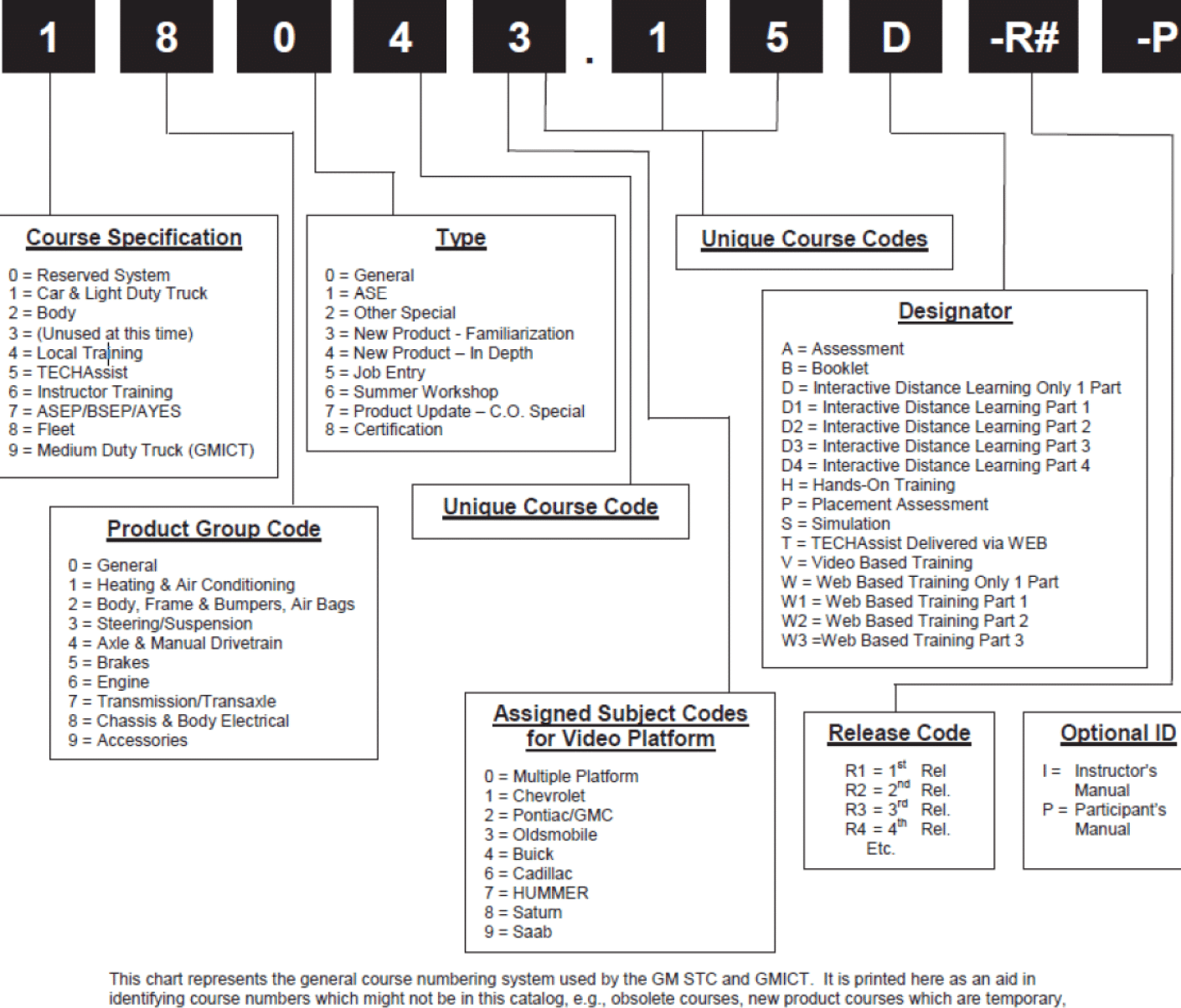
The Path to 100% STS button on the Center of Learning home page improves the ease of navigating the LMS and provides convenient access for enrolling and measuring progress toward achieving 100% STS.

4.3.1 Capabilities and Benefits
Click on Path to 100% to view the STC Service Area, STS percentages, and Bronze, Silver, Gold, and Master Technician Certification status for each STS category you’ve built a Learning Path for. To view the Learning Path, click on the STC Service Area category.
Example Learning Paths on Center of Learning
|
STS |
Bronze |
Silver |
Gold |
MTC |
|
|---|---|---|---|---|---|
|
Fundamentals |
0% |
N |
NA |
NA |
N |
|
Fundamentals - Tech Apprentice (Display Only) |
0% |
N |
NA |
NA |
N |
|
Emerging Issues |
0% |
NA |
N |
N |
N |
|
Engine Performance |
0% |
NA |
N |
N |
N |
|
Diesel Engine Performance |
0% |
NA |
N |
N |
N |
|
Engine Repair |
0% |
NA |
N |
N |
N |
|
Electrical/ Electronics |
0% |
NA |
N |
N |
N |
|
Manual Drivetrain & Axle |
0% |
NA |
N |
N |
N |
|
Automatic Transaxle/Transmission |
0% |
NA |
N |
N |
N |
4.3.2 Reserve a Seat
Service technicians are required to complete each prerequisite prior to enrolling in VCT or V/P-ILTs. We’ve introduced the Reserve a Seat functionality for technical training in the Center of Learning. This function allows the proactive scheduling of training prior to completing prerequisites.
Benefits of this function include:
The Service Training Planner builds on the Path to 100% STS button and gives Service Managers unprecedented ability to customize how they manage service training by helping them create a training plan for the year. For instance, Service Managers can train just for STS requirements or for Depth in one or more areas. They can even identify the specific technician to be trained for STS and Depth for each service area. And to help keep the training plan on track, the Center of Learning website auto generates reminder emails once per week until the Service Training Planner is complete.

4.4.1 Service Manager Capabilities and Benefits
GM STC requires all new service technicians to provide ASE with their Person ID to allow certification status from the ASE website (www.ase.com) to transfer into GM’s training website (www.centerlearning.com).
Follow directions below to verify that you’ve allowed your status to be released to GM.
To create an ASE profile, click on the “Create myASE Account” link on the page after selecting myASE in the upper right corner of the ASE portal home page (www.ase.com); provide ASE with your Person ID (not 9-digit GMIN).
The Learner ID is displayed and found on your personal Profile page:
To allow your “Certified” status to be released to GM, you must:
This process enables ASE to properly identify the service technician as GM affiliated and supply the appropriate ASE certification information to GM STC. Once this change is made, allow 1-2 weeks for your ASE certification status to be visible within the Center of Learning training website. If up-to-date ASE certification records are not showing in www.centerlearning.com four weeks after the most recent testing, the service technician should contact ASE at www.ase.com and update ASE’s records with their Person ID. Contact ASE Customer Service at (800) 390-6789 between 8 a.m. and 5 p.m. Eastern time, Monday through Friday, with questions.
Please note that ASE certified technicians receive a 7-month grace period from when their certification expires to when the expiration is reflected in the Center of Learning. Additionally, located on each of the ASE Certification pages on the Center of Learning, technicians can download an ASE Prep Guide help them prepare them for their needed ASE Certifications. For further information on ASE visit www.ase.com/gm.
Service Managers can view changes to STS requirements for 2024 and many other useful Dealer Reports. Select Reports from the home page of www.centerlearning.com and choose from:
4.6.1 Predictive STS
As an update to the Dealer STS Report, GM STC has introduced Predictive STS. Predictive STS allows Service Managers to use a drop down menu to select the last day of the current month, or a future month and see what their predicted STS percentages will be at those times. This prediction is calculated based on technicians’ current enrollments in Hands-On or VCT courses, and whether technicians have started VOD or WBT courses. The patterns that appear show current STS (green, forward slash pattern), predicted STS (blue, back slash pattern), and remaining percentage (gray, polka dot pattern). These three different patterns will always add up to 100%. Any categories that are trained for depth will show a percentage of over 100%.
A more detailed view can be explored by selecting the individual Learning Path. Once the Learning Path is selected, the view changes to show individual technicians assigned to that specific path, shows the courses they’ve completed and now includes an additional column that shows their Projected percentage for that Learning Path.
4.7.1 GM Service Technical Automotive Readiness Training (GM START)
GM START offers dealers the opportunity to build upon their technician base, build their business, and enhance their customer satisfaction with more experienced and trained personnel. The GM START program helps aspiring technicians perform basic service repairs and maintenance on customer vehicles. GM START features over 90 technical and non-technical self-paced courses with testing and scoring features that provide tangible results.
To find GM START courses in the Center of Learning just type “GM START” into the search bar in the Catalog. The courses have been tagged to appear when searched for using that keyword.
GM START courses do not provide STS credit.
4.7.2 Maintenance Inspection Technician (MIT)
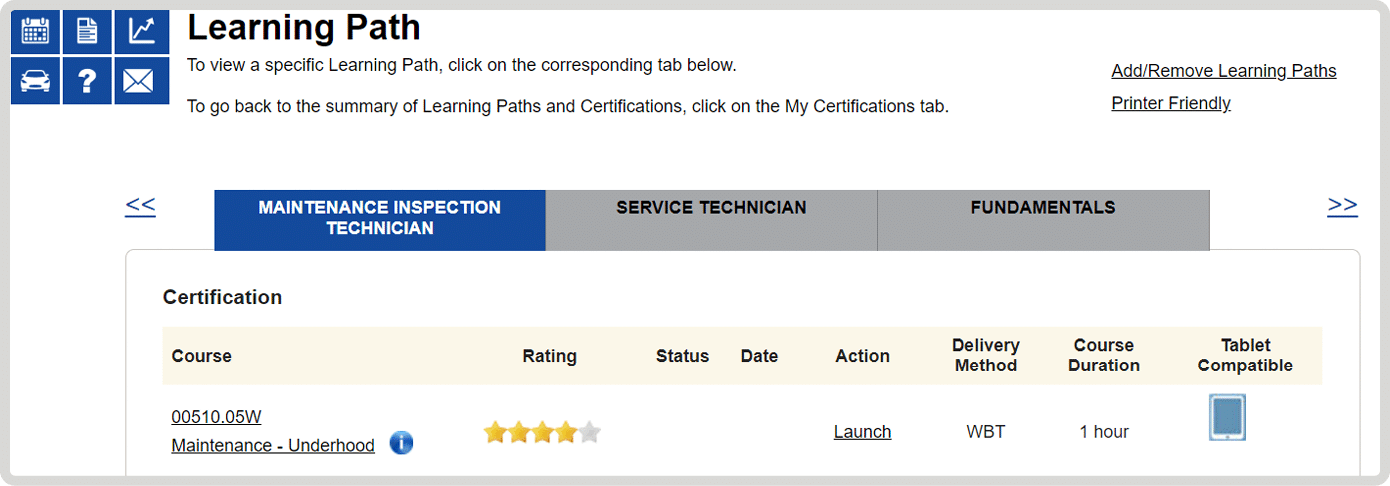 To support dealerships that want to develop their own technicians, GM STC offers a learning path for the Maintenance Inspection Technician (MIT).
To support dealerships that want to develop their own technicians, GM STC offers a learning path for the Maintenance Inspection Technician (MIT).
The MIT curriculum consists of 27.75 training hours: 19.75 of WBT + 8 hours of Hands-On. There is a Hands-On checklist for the 8 hours of ILT. Upon successful completion of the MIT curriculum, a technician will be familiar with safety and tools, be able to perform basic maintenance, and be able to conduct a Multi-Point Vehicle Inspection (MPVI).
This job role has no impact on STS.
Boot Camps are another means for supporting dealerships looking to develop their own technicians. Boot Camp curriculum is designed for the aspiring technician apprentice who may have vocational auto shop experience but has not pursued post-secondary education in automotive technology. Technicians who want to sharpen a specific skill set through instructor-led training will also benefit from Boot Camps.
A Boot Camp is an immersive Hands-On training experience that accelerates the learner’s progression toward completing GM’s performance-based curriculum and maximizes dealership return on training investment.


GM STC curriculum is designed to meet two requirements:
This dual nature of the GM STC curriculum is represented within the training categories defined in each training path: Bronze, Silver, Gold, and Master Technician Certification (MTC).
Any course in the GM STC program is available to an active GM service technician provided prerequisites have been met.
The Fundamentals Learning Path contains all the Bronze level requirements, and every technician must complete them in order to achieve 100% STS. The Silver, Gold, and MTC level requirements are found within the other Learning Paths. All Silver level requirements can be completed in dealership. Gold level requirements have an in-person component which must be completed at a training center. MTC level requirements include the ASE Certification and the Master Technician Certification Assessment for that Learning Path.
On the STS Report (available to dealer service managers), empty cells to the right of the service technician’s name in a Certification Area indicate that the course is required for the dealership. In many cases, the STS and MTC requirements are the same. Please refer to the STS Report, Learning Path, and the Technician Training Gap Report for a complete list of training needs. When a service technician successfully completes a course that is listed on both the Learning Path and the STS Report, credit is given for both.
4.1.1 Learning Paths for GM Master Technician Certification
Every GM service technician can choose a Learning Path that includes the requirements for the GM MTC. This Learning Path assists the service technician in identifying the courses to take for a specific Certification Area. A service technician’s Learning Path will carry over from year to year; however, it should be checked at the beginning of each year for changed requirements.
It is important to note on the Learning Path that a course may consist of two, three, or four component delivery media. For example, the GM Global Electrical Systems course (18044.22) is actually delivered as four different components, using different media: Web-Based Training (W1 and W2), and Virtual Classroom Training (D1 and D2). This is shown on the Learning Path as four separate numbers, each with the same 7-digit core course number and a suffix letter/number to denote the delivery medium and, if appropriate, the release number.
In response to dealer feedback, we changed how the dealer size is calculated and the impact on Service Training Standards (STS) for all dealers. GM STC worked with the Dealer Fixed Operations Advisory Board (DFOAB) to develop a methodology that aligns service training with overall technical training goals to deliver a truly exceptional service experience for our customers.
Individual dealer STS requirements are determined by a dealer’s Repair Order (RO) count rather than VINs sold. The RO data includes both warranty and customer pay. This data excludes claims that would normally happen before the sale (for example, Pre Delivery Inspection and transportation claims) and stand-alone internal ROs.
The benefits of this change include:
A business rule prevents dealers from changing more than one size per year.
4.2.1 Additional Information
|
Date |
Details |
|---|---|
|
September, current year |
Dealer notified of pending changes via GlobalConnect message. |
|
October, current year |
District Service Manager (DVM) notifies dealers if their group will change for STS requirements. |
|
January, new year |
STS requirements based on Repair Order (RO) count become effective. |
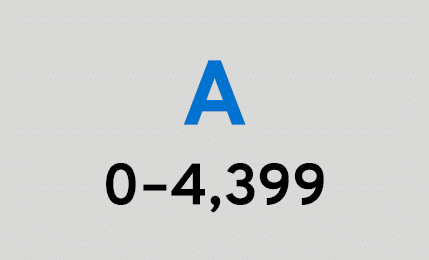
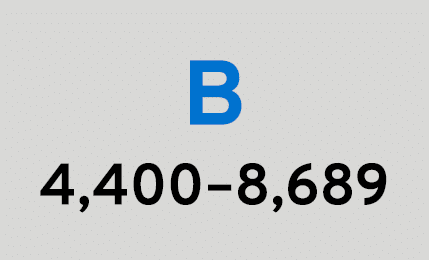
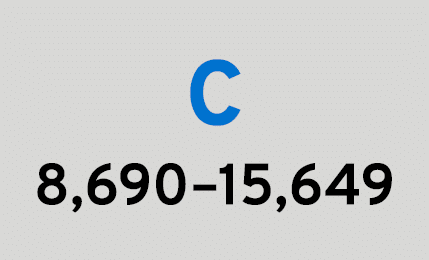
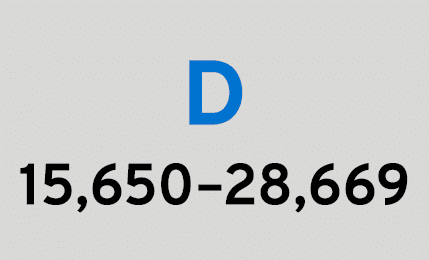
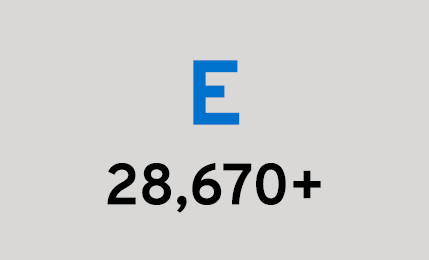
This chart identifies the minimum number of technicians required to meet STS.
|
Service Category |
A |
B |
C |
D |
E |
|
|---|---|---|---|---|---|---|
|
1 |
Fundamentals |
All |
All |
All |
All |
All |
|
2 |
Emerging Issues |
2 |
2 |
2 |
2 |
2 |
|
3 |
Engine Repair |
2 |
2 |
3 |
2 |
3 |
|
4 |
Automatic Transmission/Transaxle |
2 |
2 |
2 |
2 |
3 |
|
5 |
Sterring and Suspension |
2 |
2 |
3 |
3 |
4 |
|
6 |
Electrical/Electronics |
2 |
2 |
4 |
5 |
6 |
|
7 |
Heating, Ventilation, and Air Conditioning (HVAC) |
2 |
2 |
3 |
3 |
4 |
|
8 |
Brakes |
2 |
2 |
3 |
3 |
4 |
|
9 |
Engine Performance |
2 |
2 |
3 |
4 |
5 |
|
10 |
Manual Drivetrain and Axle |
2 |
2 |
2 |
2 |
3 |
|
11 |
Diesel Engine Performance |
2 |
2 |
3 |
2 |
2 |
|
12 |
Machanical/Electrical Body Repair |
2 |
2 |
2 |
2 |
2 |
|
13 |
EV Expert |
2 |
2 |
3 |
4 |
4 |
|
14 |
EV Master |
1 |
1 |
2 |
2 |
3 |
|
15 |
Body Structural Repair (I-CAR) |
1 |
1 |
1 |
1 |
1 |
|
16 |
Paint and Refinish |
1 |
1 |
1 |
1 |
1 |
|
17 |
Medium Duty |
1 |
1 |
1 |
1 |
1 |
Whether the service technician is trying to meet the STS requirements for training or to achieve MTC, the Learning Path provides the recommended sequence for taking course components in a Certification Area. The order for taking the course components is from the top to the bottom of the Learning Path. Please note that the course is in the recommended learning sequence, but the components are not in the correct completion order.
GM STC training course numbers use the following system:
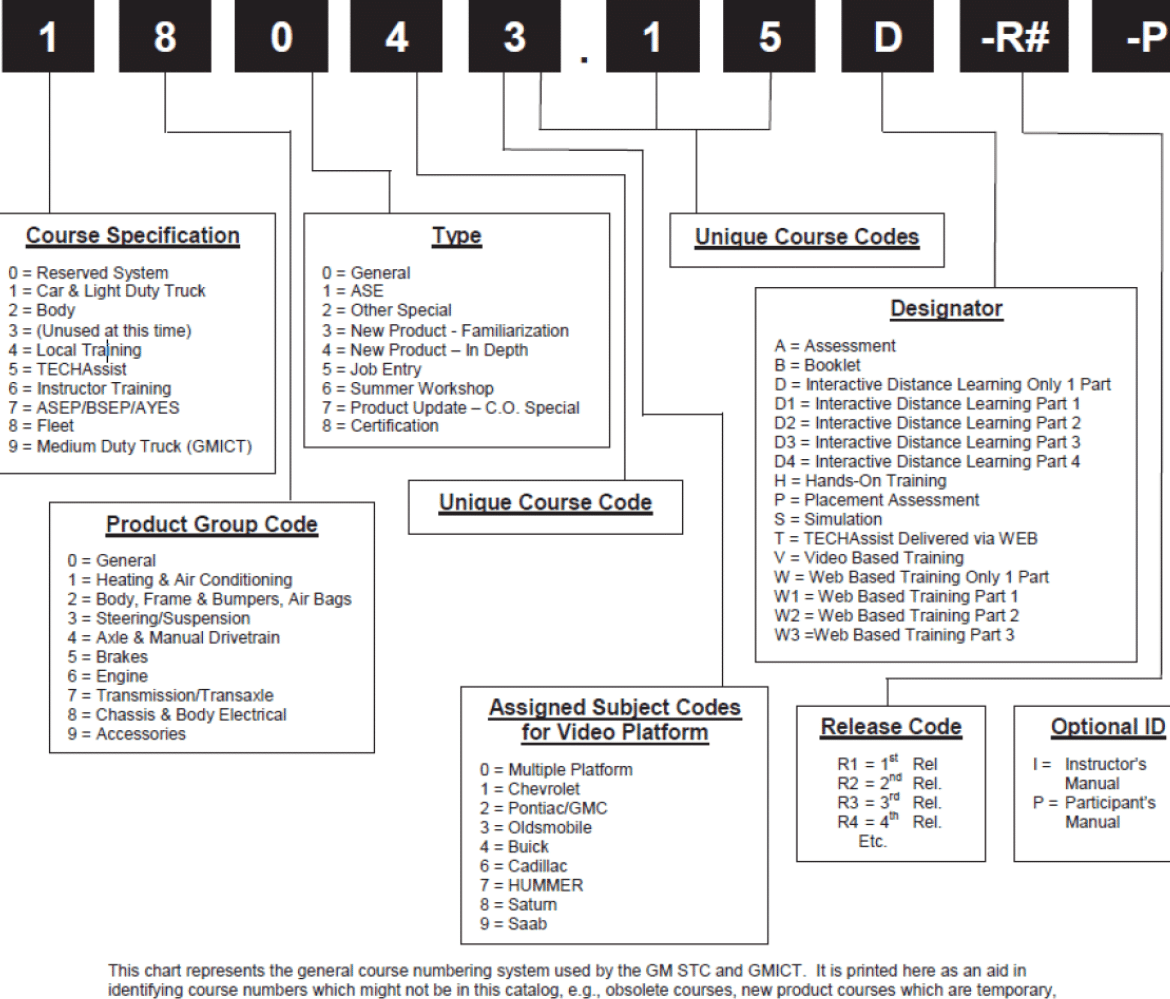
The Path to 100% STS button on the Center of Learning home page improves the ease of navigating the LMS and provides convenient access for enrolling and measuring progress toward achieving 100% STS.

4.3.1 Capabilities and Benefits
Click on Path to 100% to view the STC Service Area, STS percentages, and Bronze, Silver, Gold, and Master Technician Certification status for each STS category you’ve built a Learning Path for. To view the Learning Path, click on the STC Service Area category.
Example Learning Paths on Center of Learning
|
STS |
Bronze |
Silver |
Gold |
MTC |
|
|---|---|---|---|---|---|
|
Fundamentals |
0% |
N |
NA |
NA |
N |
|
Fundamentals - Tech Apprentice (Display Only) |
0% |
N |
NA |
NA |
N |
|
Emerging Issues |
0% |
NA |
N |
N |
N |
|
Engine Performance |
0% |
NA |
N |
N |
N |
|
Diesel Engine Performance |
0% |
NA |
N |
N |
N |
|
Engine Repair |
0% |
NA |
N |
N |
N |
|
Electrocal/ Electronics |
0% |
NA |
N |
N |
N |
|
Manual Drivetrain & Axle |
0% |
NA |
N |
N |
N |
|
Automatic Transaxle/Transmission |
0% |
NA |
N |
N |
N |
4.3.2 Reserve a Seat
Service technicians are required to complete each prerequisite prior to enrolling in VCT or V/P-ILTs. We’ve introduced the Reserve a Seat functionality for technical training in the Center of Learning. This function allows the proactive scheduling of training prior to completing prerequisites.
Benefits of this function include:
The Service Training Planner builds on the Path to 100% STS button and gives Service Managers unprecedented ability to customize how they manage service training by helping them create a training plan for the year. For instance, Service Managers can train just for STS requirements or for Depth in one or more areas. They can even identify the specific technician to be trained for STS and Depth for each service area. And to help keep the training plan on track, the Center of Learning website auto generates reminder emails once per week until the Service Training Planner is complete.

4.4.1 Service Manager Capabilities and Benefits
GM STC requires all new service technicians to provide ASE with their Person ID to allow certification status from the ASE website (www.ase.com) to transfer into GM’s training website (www.centerlearning.com).
Follow directions below to verify that you’ve allowed your status to be released to GM.
To create an ASE profile, click on the “Create myASE Account” link on the page after selecting myASE in the upper right corner of the ASE portal home page (www.ase.com); provide ASE with your Person ID (not 9-digit GMIN).
The Learner ID is displayed and found on your personal Profile page:
To allow your “Certified” status to be released to GM, you must:
This process enables ASE to properly identify the service technician as GM affiliated and supply the appropriate ASE certification information to GM STC. Once this change is made, allow 1-2 weeks for your ASE certification status to be visible within the Center of Learning training website. If up-to-date ASE certification records are not showing in www.centerlearning.com four weeks after the most recent testing, the service technician should contact ASE at www.ase.com and update ASE’s records with their Person ID. Contact ASE Customer Service at (800) 390-6789 between 8 a.m. and 5 p.m. Eastern time, Monday through Friday, with questions.
Please note that ASE certified technicians receive a 7-month grace period from when their certification expires to when the expiration is reflected in the Center of Learning. Additionally, located on each of the ASE Certification pages on the Center of Learning, technicians can download an ASE Prep Guide help them prepare them for their needed ASE Certifications. For further information on ASE visit www.ase.com/gm.
Service Managers can view changes to STS requirements for 2024 and many other useful Dealer Reports. Select Reports from the home page of www.centerlearning.com and choose from:
4.6.1 Predictive STS
As an update to the Dealer STS Report, GM STC has introduced Predictive STS. Predictive STS allows Service Managers to use a drop down menu to select the last day of the current month, or a future month and see what their predicted STS percentages will be at those times. This prediction is calculated based on technicians’ current enrollments in Hands-On or VCT courses, and whether technicians have started VOD or WBT courses. The patterns that appear show current STS (green, forward slash pattern), predicted STS (blue, back slash pattern), and remaining percentage (gray, polka dot pattern). These three different patterns will always add up to 100%. Any categories that are trained for depth will show a percentage of over 100%.
A more detailed view can be explored by selecting the individual Learning Path. Once the Learning Path is selected, the view changes to show individual technicians assigned to that specific path, shows the courses they’ve completed and now includes an additional column that shows their Projected percentage for that Learning Path.
4.7.1 GM Service Technical Automotive Readiness Training (GM START)
GM START offers dealers the opportunity to build upon their technician base, build their business, and enhance their customer satisfaction with more experienced and trained personnel. The GM START program helps aspiring technicians perform basic service repairs and maintenance on customer vehicles. GM START features over 90 technical and non-technical self-paced courses with testing and scoring features that provide tangible results.
To find GM START courses in the Center of Learning just type “GM START” into the search bar in the Catalog. The courses have been tagged to appear when searched for using that keyword.
GM START courses do not provide STS credit.
4.7.2 Maintenance Inspection Technician (MIT)
To support dealerships that want to develop their own technicians, GM STC offers a learning path for the Maintenance Inspection Technician (MIT).
The MIT curriculum consists of 27.75 training hours: 19.75 of WBT + 8 hours of Hands-On. There is a Hands-On checklist for the 8 hours of ILT. Upon successful completion of the MIT curriculum, a technician will be familiar with safety and tools, be able to perform basic maintenance, and be able to conduct a Multi-Point Vehicle Inspection (MPVI).
This job role has no impact on STS.
Boot Camps are another means for supporting dealerships looking to develop their own technicians. Boot Camp curriculum is designed for the aspiring technician apprentice who may have vocational auto shop experience but has not pursued post-secondary education in automotive technology. Technicians who want to sharpen a specific skill set through instructor-led training will also benefit from Boot Camps.
A Boot Camp is an immersive Hands-On training experience that accelerates the learner’s progression toward completing GM’s performance-based curriculum and maximizes dealership return on training investment.
STS requirements for each of the service categories and Medium Duty are listed on the following pages.
Each service category section indicates the course requirements for 2024 Dealer Divisional STS as indicated by the courses that appear under the Bronze, Silver, and Gold categories. The courses required to reach GM MTC in that service area include all of the courses in Bronze, Silver, and Gold and the courses under the MTC category. Required courses are needed to meet the Dealer Divisional STS and for certification. Supplemental courses provide additional content to enhance the curriculum and improve the service technician’s performance but are not part of the Dealer Divisional STS requirements or certification.
5.1.1 Dealer Divisional Service Training Standards
Service technicians who successfully complete all of the STS requirements within each category for a Division will earn Divisional Certification (Buick, GMC, etc.) for that Division.
5.1.2 GM Master Technician Certification
GM MTC, like ASE Certification, is common across all Divisions. Service technicians who successfully complete all GM MTC requirements within each category will earn GM MTC across all Divisions for that category. Since this certification is common, some courses required for GM MTC may not be found as part of the STS. Similarly, some courses required for the STS will not be part of the requirements for GM MTC.
5.1.3 Legend
Refer to the legend below for references contained on the following Learning Path pages.
A = Assessment
B = Buick
C = Chevrolet
C-EV = Chevrolet EV
D = VCT
G = GMC
G-EV = GMC EV
H = Hands-On
K = Cadillac
P = Placement Assessment or Posttest
V = VOD
W = WBT
The following pages define requirements and learning paths (excluding Emerging Issues) for each of the service categories.
Note: please make note of those learning paths and courses that are required to achieve STS and maintain MTC/WCT status.
5.1.4 Emerging Issues
These monthly GM Service Know-How Seminars provide service/technical information on current issues and GM certified repairs. In many cases, an Emerging Issues seminar may provide notification to technicians of a concern and the current attempts to address the related issues.
The GM Service Know-How Emerging Issues seminars feature guest Subject Matter Experts who discuss, and/or demonstrate, a service-related topic. Email questions from the technician audience may be addressed as well.

Topics that may be of interest to Service Consultants are identified by an “SC” icon in the lower right corner of the screen. By calling out these topics, Emerging Issues hopes to help Service Consultants identify customer concerns that may not require a trip to the service bay.
Emerging Issues is only available as a streaming video on GM’s www.centerlearning.com.
Emerging Issues seminars, and a great deal of other technical video content, can be accessed by logging on to www.gmglobalconnect.com and selecting the Center of Learning website.
The intent of the program is to ensure that the technician takes the training this year in order to be STS complete the following year. To receive credit for completion, the technician must:

STS requirements for each of the service categories and Medium Duty are listed on the following pages.
Each service category section indicates the course requirements for 2024 Dealer Divisional STS as indicated by the courses that appear under the Bronze, Silver, and Gold categories. The courses required to reach GM MTC in that service area include all of the courses in Bronze, Silver, and Gold and the courses under the MTC category. Required courses are needed to meet the Dealer Divisional STS and for certification. Supplemental courses provide additional content to enhance the curriculum and improve the service technician’s performance but are not part of the Dealer Divisional STS requirements or certification.
5.1.1 Dealer Divisional Service Training Standards
Service technicians who successfully complete all of the STS requirements within each category for a Division will earn Divisional Certification (Buick, GMC, etc.) for that Division.
5.1.2 GM Master Technician Certification
GM MTC, like ASE Certification, is common across all Divisions. Service technicians who successfully complete all GM MTC requirements within each category will earn GM MTC across all Divisions for that category. Since this certification is common, some courses required for GM MTC may not be found as part of the STS. Similarly, some courses required for the STS will not be part of the requirements for GM MTC.
5.1.3 Legend
Refer to the legend below for references contained on the following Learning Path pages.
A = Assessment
B = Buick
C = Chevrolet
C-EV = Chevrolet EV
D = VCT
G = GMC
G-EV = GMC EV
H = Hands-On
K = Cadillac
P = Placement Assessment or Posttest
V = VOD
W = WBT
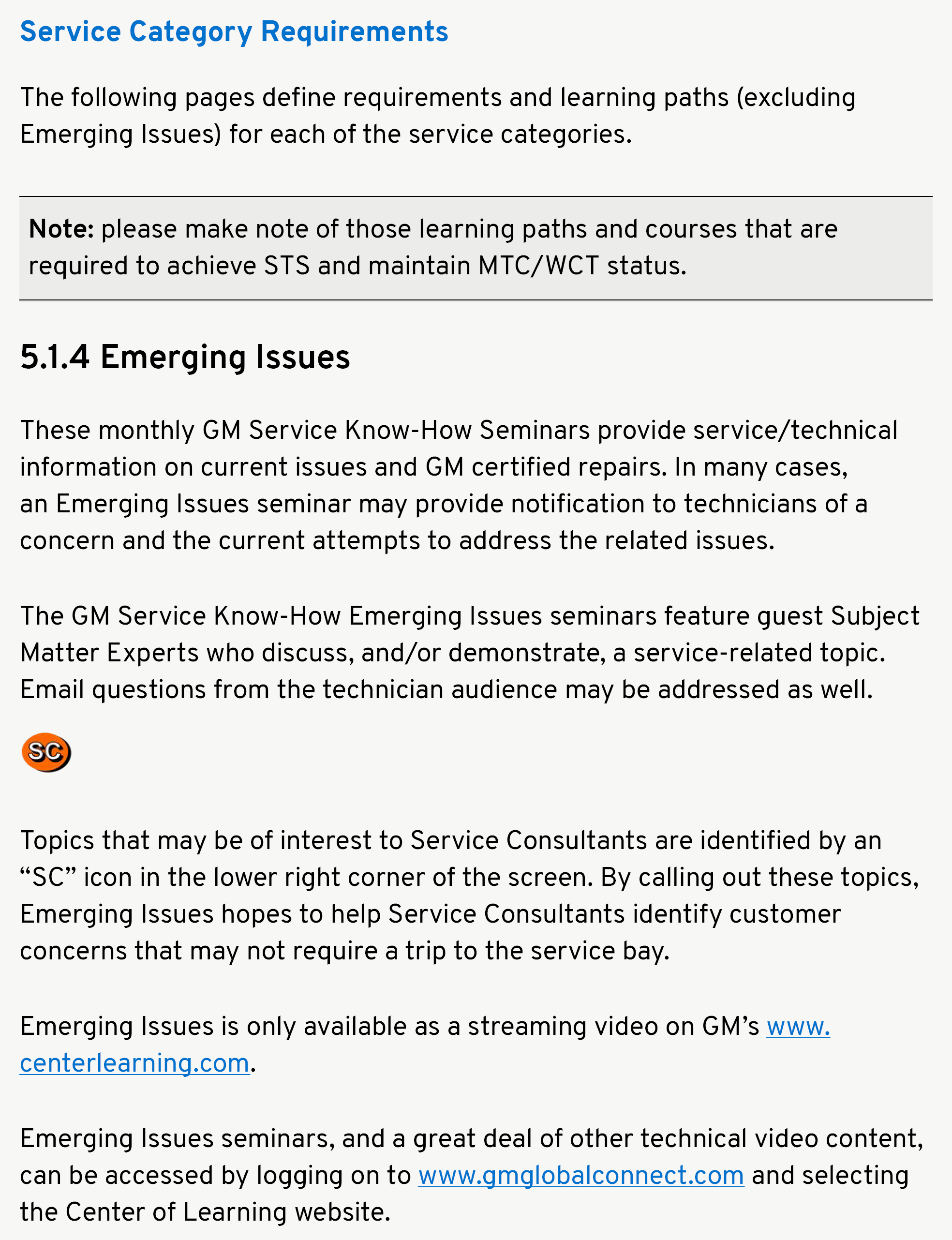
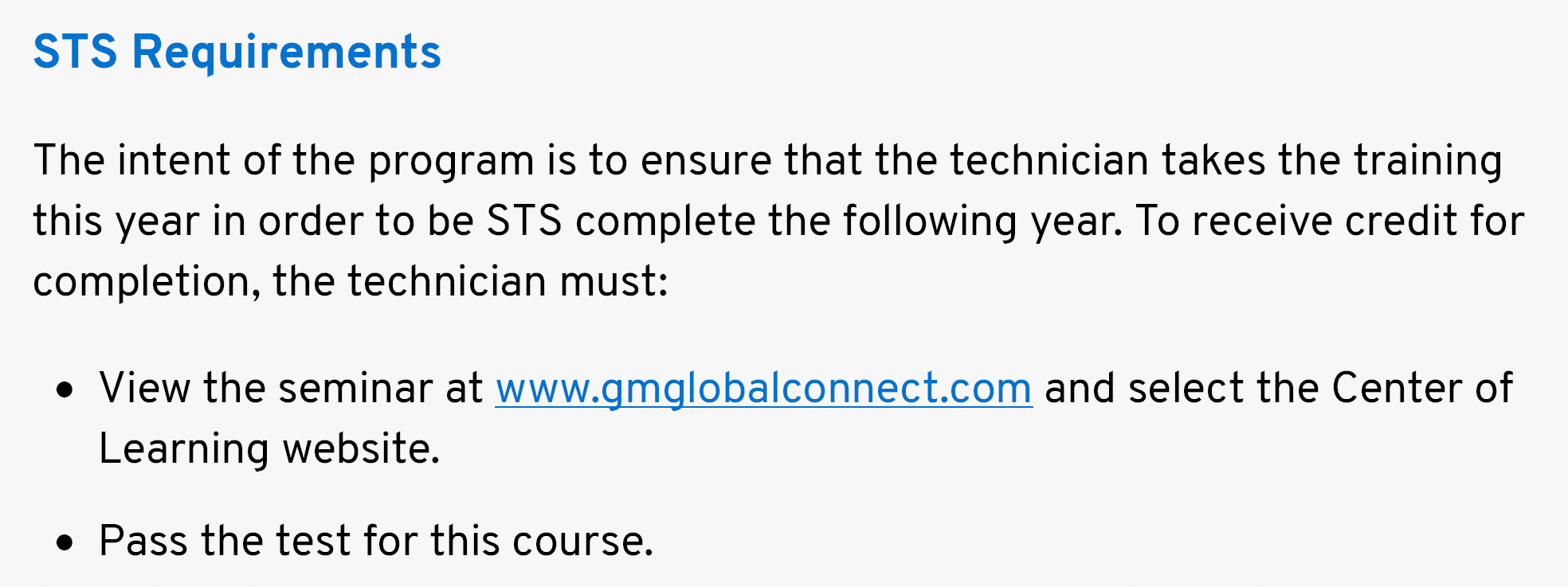

GM STC imports the list of certified painters into www.centerlearning.com. Credit shows in training records immediately and on the STS Report within one week.
Note: This step is required only if a trainee passes the online evaluation.
A paint supplier representative performs an in-shop evaluation.
Note: If a technician fails the in-shop evaluation, the recommended action is to complete the OE course.
Note: This step is required only if a trainee does not pass the online evaluation tests.
Upon completing an online evaluation test, the trainee receives immediate feedback from www.centerlearning.com, including a note on which course(s) they need to enroll in.
See the GM Paint Manufacturer Course and Contact Information section of the catalog (Section 2) for course names based on supplier used.
For more information pertaining to specific OE courses, call the paint supplier at the number listed in the catalog.
Note: This step is required only if a trainee passes the online evaluation.
Upon successful completion of both online evaluation tests, the trainee should contact either his/her local paint supplier representative or the paint supplier CTO to schedule an in-shop evaluation.
Once a technician pre-qualifies, he/she must complete the online evaluation by logging on to www.centerlearning.com. Trainees who do not have a log on ID and password may obtain one either by contacting their GM service manager or by calling the GM Center of Learning Help Desk at (888) 748-2687; press 2 then 8. Technicians can locate the online evaluation by clicking Testing > Service Technical > Paint Placement Assessment. The evaluation includes two tests:
Step #2: Observed Performance Evaluations
Test 2
As appropriate, GM STC incorporates supplier training into its curriculum. These suppliers develop training that meets the high standards GM requires for dealer service technicians. Currently, training in the Body Structural Repair and Paint and Refinish categories is provided by GM-approved suppliers.
5.2.1 Body Structural Repair
GM STC includes I-CAR training as required for a minimum of one technician per repair facility and optional training within the Body Structural Repair portion of STS to ensure that technicians have the skills and knowledge to fix vehicles right the first time and thereby deliver an exceptional customer experience.
Visit https://info.i-car.com/network-programs/oem/GM for Body Structural Repair courses offered by I-CAR.
How do I know if my Welding Certification is current?
I-CAR Welding Training & Certification is valid for five years. I-CAR recommends beginning the registration process to regain the certification at least two months prior to a technician’s expiration date. This provides ample time to ensure that the technician’s certification does not lapse.
To check your I-CAR certification status, please visit: https://www.i-car.com/Home/MyICAR/Login

You must have an established Profile page in GlobalConnect with a Primary Email address per below to allow certification status from I-CAR to transfer into GM’s training website (www.centerlearning.com).
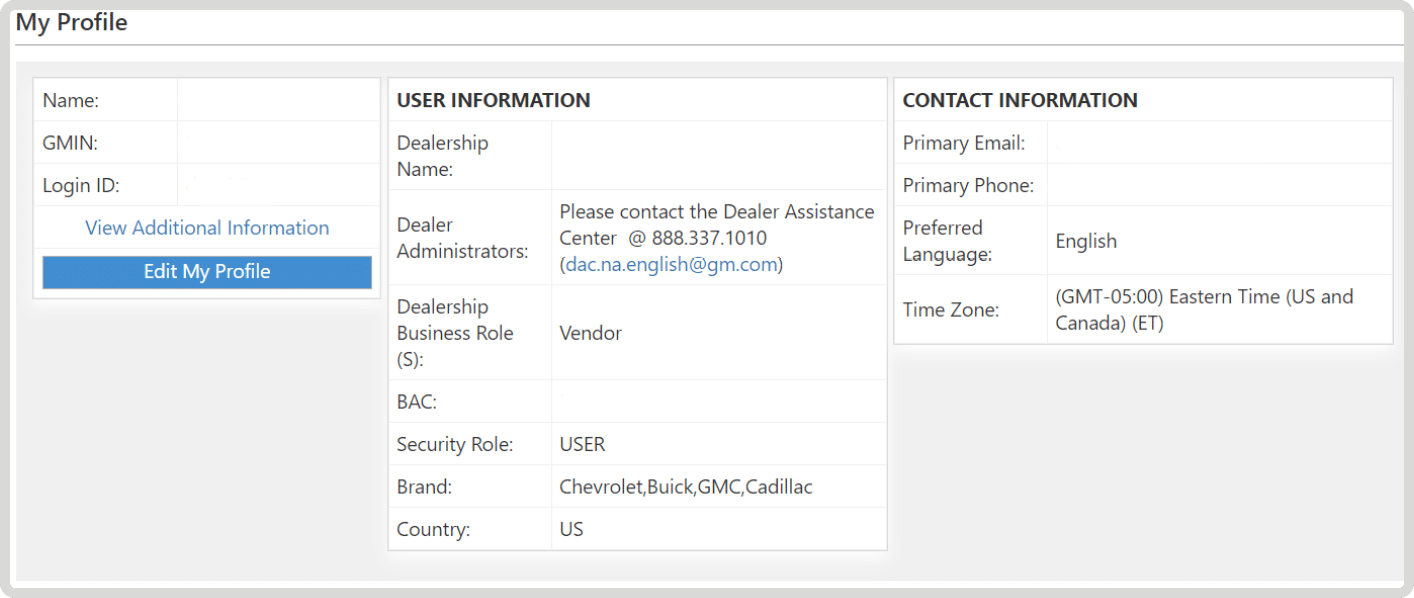
Each week, I-CAR provides GM STC a report of all applicable completed training. GM STC then uploads the credit into body structural repair technicians’ training records, which display the credit immediately. Dealers’ STS Reports will also display the credit after their regular weekly update.
To manage your OEM Affiliation with I-CAR:
You can call your assigned I-CAR customer care representative or call the I-CAR Customer Care Desk at (800) 422-7872 for additional assistance.
Note: Body Structural Repair technicians and managers do not need to fax in proof of earned I-CAR credit. All applicable Body Structural Repair credit is submitted to GM STC directly from I-CAR.
The I-CAR website (www.i-car.com) provides an array of information about their training programs as well as important details regarding Gold Class points for their recognition programs. In addition, Body Structural Repair technicians and managers may contact the I-CAR Customer Care Desk at (800) 422-7872 or by email at CustomerCare@i-car.com.
5.2.2 Paint and Refinish
GM and our paint suppliers have developed a strong training relationship since joining forces. Our relationship enables us to implement the strict procedures necessary to consistently restore a vehicle’s appearance to pre-accident or showroom condition after a paint repair. Our process ensures that painters are knowledgeable and skilled, and we work together to establish performance testing standards to ensure competency certification. Paint suppliers train the technicians while GM monitors adherence to the curriculum and performance standards.
Our process offers several benefits to learners:
The graphic below depicts our Paint and Refinish Training Process. A painter who successfully completes this process will earn credit for GM Certified Paint/Refinish course number 22041.00 on their training record and dealership’s STS Report. Please allow up to four weeks for the credit to appear in the Center of Learning.

*Basic Paint Assessment 22042.00A plus the appropriate Product-Specific Paint Assessment 22044.
Trainees must complete the Paint and Refinish training process within a six-month period once they begin.
5.2.3 GM Paint Manufacturer Course and Contact Information
The following table shows the GM paint suppliers and their contact information. To determine the training requirements for certification, GM body service technicians can discuss them with their paint supplier representative or contact the appropriate GM-approved paint supplier at the number(s) listed below:
|
Paint Suppliers |
Phone Numbers |
Website |
|---|---|---|
|
Azalta/Spies Hecker/Standox/Cromax |
(610) 358-5354 |
|
|
AkzoNobel/Sikkens |
(800) 656-2332 |
|
|
BASF |
(800) 201-1605 |
|
|
PPG/Nexa |
(800) 647-6050 |
|
|
Sherwin-Williams/Martin-Senour |
(630) 887-7516 |
|
|
Valspare/DeBeer |
(972) 595-8910 |
A technician must accomplish at least one of the following:
The paint supplier representative sends the completed Observed Performance Evaluation sheets to their training administrator.
The paint supplier CTO compiles a list of certified painters and forwards it to GM STC.
Upon completing an online evaluation test at www.centerlearning.com, trainees receive immediate feedback on how they scored. A score of 80% or higher is required to pass Test 1 and sections A and B of Test 2. This information is sent to the paint supplier Central Training Office (CTO).
If a trainee receives a score of 79% or less on any part of the online evaluation (e.g., Test 1 or either section of Test 2), the trainee should contact their paint supplier representative to enroll in the applicable OE Training course(s). For example, if a trainee scores 80% on the Basic Training test and 80% on the OE Product test section and 79% on the OE Color test section, the trainee should enroll in OE Color test.
Test 1
Step #1: OE Approved paint systems information review
As appropriate, GM STC incorporates supplier training into its curriculum. These suppliers develop training that meets the high standards GM requires for dealer service technicians. Currently, training in the Body Structural Repair and Paint and Refinish categories is provided by GM-approved suppliers.
5.2.1 Body Structural Repair
GM STC includes I-CAR training as required for a minimum of one technician per repair facility and optional training within the Body Structural Repair portion of STS to ensure that technicians have the skills and knowledge to fix vehicles right the first time and thereby deliver an exceptional customer experience.
Visit https://info.i-car.com/network-programs/oem/GM for Body Structural Repair courses offered by I-CAR.
How do I know if my Welding Certification is current?
I-CAR Welding Training & Certification is valid for five years. I-CAR recommends beginning the registration process to regain the certification at least two months prior to a technician’s expiration date. This provides ample time to ensure that the technician’s certification does not lapse.
To check your I-CAR certification status, please visit: https://www.i-car.com/Home/MyICAR/Login

You must have an established Profile page in GlobalConnect with a Primary Email address per below to allow certification status from I-CAR to transfer into GM’s training website (www.centerlearning.com).
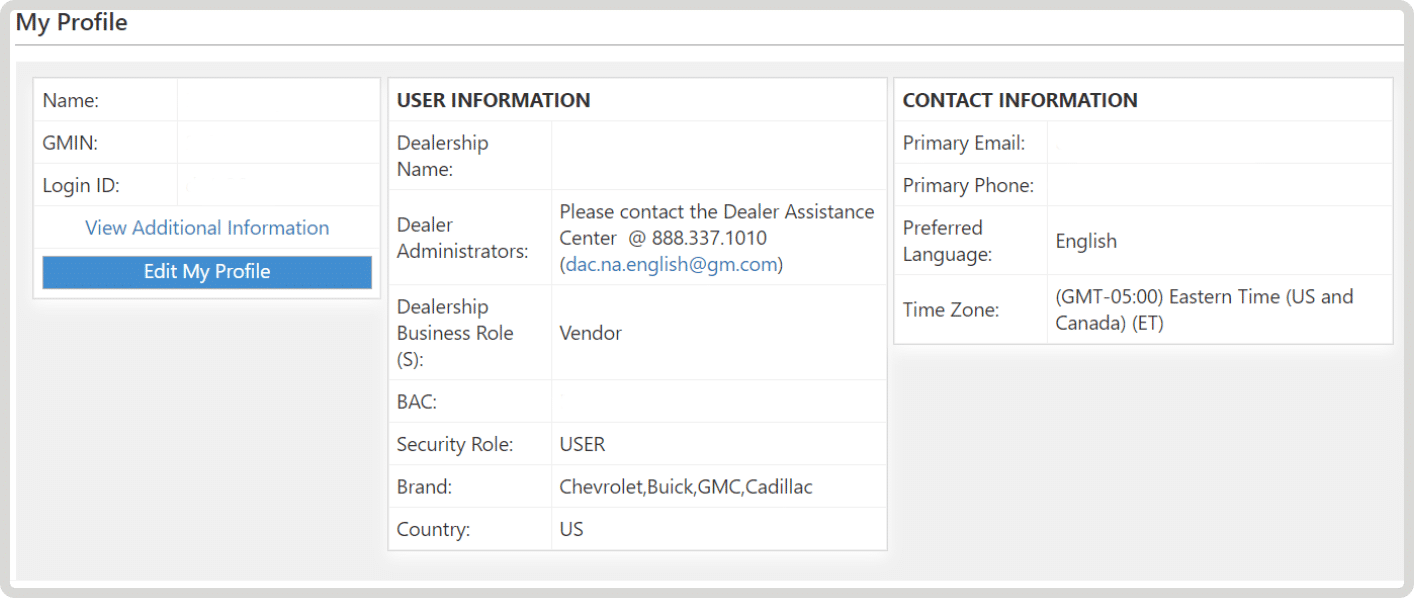
Each week, I-CAR provides GM STC a report of all applicable completed training. GM STC then uploads the credit into body structural repair technicians’ training records, which display the credit immediately. Dealers’ STS Reports will also display the credit after their regular weekly update.
To manage your OEM Affiliation with I-CAR:
You can call your assigned I-CAR customer care representative or call the I-CAR Customer Care Desk at (800) 422-7872 for additional assistance.
Note: Body Structural Repair technicians and managers do not need to fax in proof of earned I-CAR credit. All applicable Body Structural Repair credit is submitted to GM STC directly from I-CAR.
The I-CAR website (www.i-car.com) provides an array of information about their training programs as well as important details regarding Gold Class points for their recognition programs. In addition, Body Structural Repair technicians and managers may contact the I-CAR Customer Care Desk at (800) 422-7872 or by email at CustomerCare@i-car.com.
5.2.2 Paint and Refinish
GM and our paint suppliers have developed a strong training relationship since joining forces. Our relationship enables us to implement the strict procedures necessary to consistently restore a vehicle’s appearance to pre-accident or showroom condition after a paint repair. Our process ensures that painters are knowledgeable and skilled, and we work together to establish performance testing standards to ensure competency certification. Paint suppliers train the technicians while GM monitors adherence to the curriculum and performance standards.
Our process offers several benefits to learners:
The graphic below depicts our Paint and Refinish Training Process. A painter who successfully completes this process will earn credit for GM Certified Paint/Refinish course number 22041.00 on their training record and dealership’s STS Report. Please allow up to four weeks for the credit to appear in the Center of Learning.

*Basic Paint Assessment 22042.00A plus the appropriate Product-Specific Paint Assessment 22044.
A technician must accomplish at least one of the following:
Once a technician pre-qualifies, he/she must complete the online evaluation by logging on to www.centerlearning.com. Trainees who do not have a log on ID and password may obtain one either by contacting their GM service manager or by calling the GM Center of Learning Help Desk at (888) 748-2687; press 2 then 8. Technicians can locate the online evaluation by clicking Testing > Service Technical > Paint Placement Assessment. The evaluation includes two tests:
The paint supplier representative sends the completed Observed Performance Evaluation sheets to their training administrator.
The paint supplier CTO compiles a list of certified painters and forwards it to GM STC.
GM STC imports the list of certified painters into www.centerlearning.com. Credit shows in training records immediately and on the STS Report within one week.
Trainees must complete the Paint and Refinish training process within a six-month period once they begin.
5.2.3 GM Paint Manufacturer Course and Contact Information
The following table shows the GM paint suppliers and their contact information. To determine the training requirements for certification, GM body service technicians can discuss them with their paint supplier representative or contact the appropriate GM-approved paint supplier at the number(s) listed below:
|
Paint Suppliers |
Phone Numbers |
Website |
|---|---|---|
|
Azalta/Spies Hecker/Standox/Cromax |
(610) 358-5354 |
|
|
AkzoNobel/Sikkens |
(800) 656-2332 |
|
|
BASF |
(800) 201-1605 |
|
|
PPG/Nexa |
(800)647-6050 |
|
|
Sherwin-Williams/Martin-Senour |
(630) 887-7516 |
|
|
Valspare/DeBeer |
(972) 595-8910 |
Upon completing an online evaluation test at www.centerlearning.com, trainees receive immediate feedback on how they scored. A score of 80% or higher is required to pass Test 1 and sections A and B of Test 2. This information is sent to the paint supplier Central Training Office (CTO).
If a trainee receives a score of 79% or less on any part of the online evaluation (e.g., Test 1 or either section of Test 2), the trainee should contact their paint supplier representative to enroll in the applicable OE Training course(s). For example, if a trainee scores 80% on the Basic Training test and 80% on the OE Product test section and 79% on the OE Color test section, the trainee should enroll in OE Color test.
Note: This step is required only if a trainee does not pass the online evaluation tests.
Upon completing an online evaluation test, the trainee receives immediate feedback from www.centerlearning.com, including a note on which course(s) they need to enroll in.
See the GM Paint Manufacturer Course and Contact Information section of the catalog (Section 2) for course names based on supplier used.
For more information pertaining to specific OE courses, call the paint supplier at the number listed in the catalog.
Note: This step is required only if a trainee passes the online evaluation.
Upon successful completion of both online evaluation tests, the trainee should contact either his/her local paint supplier representative or the paint supplier CTO to schedule an in-shop evaluation.
Note: This step is required only if a trainee passes the online evaluation.
A paint supplier representative performs an in-shop evaluation.
Note: If a technician fails the in-shop evaluation, the recommended action is to complete the OE course.
Step #1: OE Approved paint systems information review
Step #2: Observed Performance Evaluations
Test 2
Test 1
The GM STC portal site provides an overview of the GM STC program. Here, users can find information on the curriculum, training locations, and other details that impact service technical training. This site also provides information about other related programs, as well as the latest news and information regarding GM STC. Please visit this publicly accessible site at www.gmstc.com for more information.
6.1.1 First Responder Guides, Rescue Sheets, and Quick Reference Sheets
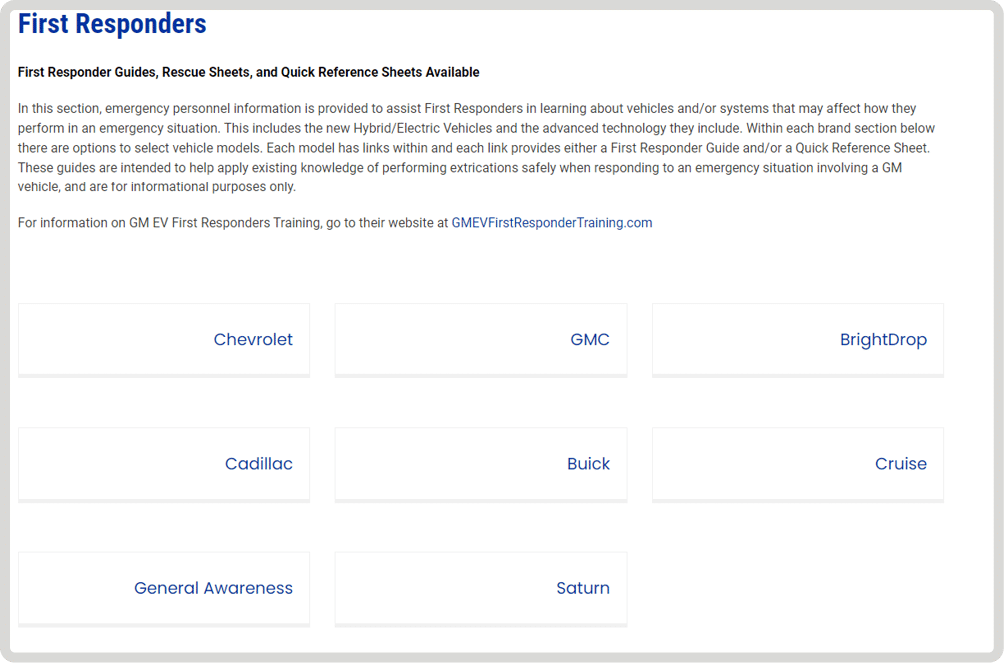 As an auto industry technology leader, the GM vehicles being developed and driven on our roads necessitate information sharing with the first responder community: firefighters, police officers, and Emergency Medical Technicians (EMTs). Technology affects vehicle components such as supplemental restraints and the materials used to build vehicles.
As an auto industry technology leader, the GM vehicles being developed and driven on our roads necessitate information sharing with the first responder community: firefighters, police officers, and Emergency Medical Technicians (EMTs). Technology affects vehicle components such as supplemental restraints and the materials used to build vehicles.
While some systems and components are common to traditional GM vehicles, there are now Hybrid/Electric Vehicles systems and components that differ and may affect how a rescue procedure is performed.
GM STC develops First Responder Guides (FRG), Rescue Sheets (RS), and Quick Reference Sheets (QRS) for the new technology vehicles and posts them to www.gmstc.com.
An FRG offers information on vehicle systems and components; both RS and QRS provide the “on-scene” information that first responders need. All of these items feature high quality graphics to support the information.
The FRG provides an overview on how the advance technology vehicle operates and how to identify the vehicle from conventional vehicles, in addition to identifying key hybrid components and how to safely disable the high voltage system. The “No Cut Zones” are provided to ensure the occupant and First Responder are safe during extrication procedures. RS and QRS provide vehicle identification, hybrid components and how to disable the electrical/fuel cell systems.
GM STC provides FRG, RS, and QRS free of charge to First Responders. All can be displayed as long as they are represented as GM information and are not modified in any way.
Note: Guides can be downloaded from www.gmstc.com > First Responders in PDF format onto desktops and mobile devices or printed and saved in vehicles. They can also be accessed using a QR code reader on a smart device (see photo).
The Center of Learning website was implemented to respond to the GM Dealer Council’s requests that dealers have greater ownership of dealership employee training. This website enables dealers to track and organize their dealership employee training and to stay current on their training requirements and needs. It enables users to access a variety of training information at their convenience, providing details on items such as course descriptions, schedules, enrollments, training histories, resource management, and reporting.
The Center of Learning website is now accessible via GM GlobalConnect (www.gmglobalconnect.com) using Single Sign-On (SSO) technology. Once logged into GlobalConnect, simply click on the Center of Learning link to reach the home page. Be sure to use your own GM GlobalConnect ID to ensure you receive credit for any web classes completed.
The website displays your specific training records and requirements. Please contact your dealership’s Partner Security Coordinator if you have questions about your access levels within GlobalConnect.
To ensure a pleasant experience when using the Center of Learning website, be sure to check out the available job aids under Help/Support link located at the top of the page.
6.2.1 The Importance of Email
There are many Center of Learning website features that rely on technicians and service managers having accurate email addresses in GM GlobalConnect. Accordingly, technicians and service managers must fill out the My Profile page complete with a Primary Email (and/or Secondary Email) to receive important notifications from www.centerlearning.com.
6.2.2 Center of Learning Functionality and Features
The Center of Learning website is updated periodically based on feedback from the dealer council, GM management, and other stakeholders. Functionality and features are designed to make managing training needs even easier.
Courses are grouped by Bronze, Silver, and Gold certification areas
The GM STS Report divides courses and technician certification into three levels: Bronze, Silver, and Gold.
The following STS areas have Silver and Gold Certification levels:

Participants have the ability to enable course registrations and enrollment reminders to be sent to their mobile phones via a text message. This function can be enabled from the participant’s profile page in the Center of Learning.
The Path to 100% STS button to the Dealer and Technician Learning Paths on the LMS home page improves the ease of navigating within the LMS and provides convenient access for enrolling and measuring progress toward achieving 100% STS.
Many of GM STC’s WBT courses are available in Spanish. For those technicians that would prefer to take their WBT courses in Spanish, they can change the Center of Learning’s language by selecting Language in the top menu bar and then selecting Español. The Center of Learning’s language will change to Spanish. Using the Catalog or your Learning Paths, look for any course title and description that appears in Spanish. Those courses have been translated and are available in Spanish. Any course that still appears in English has not been translated.
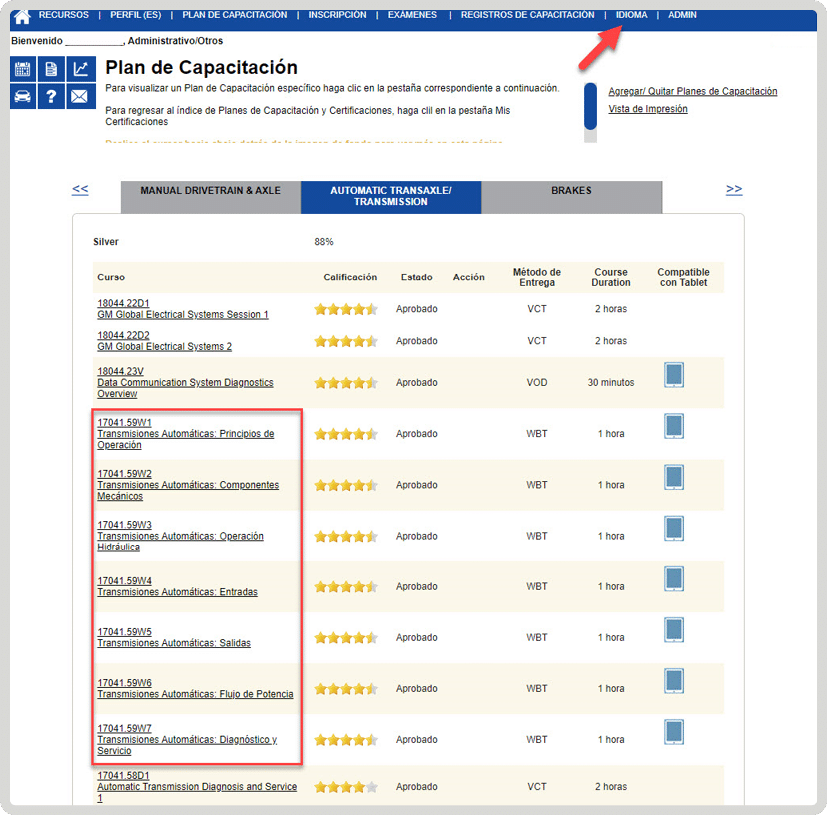
You can receive an email notification when new courses are released. You will only receive notifications for courses that are relevant to you, based on the selected Person Type in your profile. To receive New Course email notifications, set “Send New Course Announcements” to Yes on your Profile Page.

Upon logging in, service technicians’ learning paths displays the Bronze, Silver, and Gold certification status. Courses on the STS learning paths are divided into Bronze, Silver, and Gold certification areas. Learning paths that don’t have a Bronze, Silver, or Gold certification level – such as Body Structural Repair – will remain unchanged and will continue to list all courses in a single STS group.
Bronze, Silver, and Gold certificates are available for technicians to download and print from the LMS.
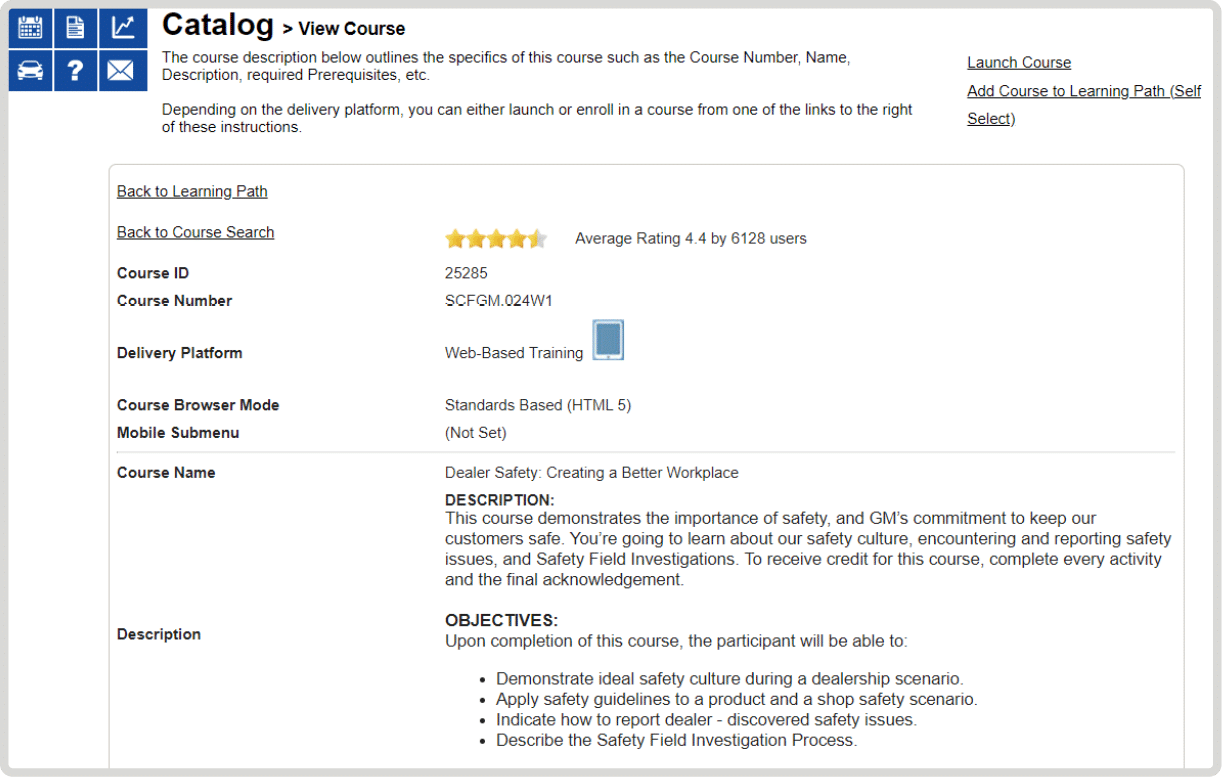 The following course information is viewable on the View Course Page:
The following course information is viewable on the View Course Page:
The following course information is viewable on the Scheduled Sessions Page:
The GM STC portal site provides an overview of the GM STC program. Here, users can find information on the curriculum, training locations, and other details that impact service technical training. This site also provides information about other related programs, as well as the latest news and information regarding GM STC. Please visit this publicly accessible site at www.gmstc.com for more information.
6.1.1 First Responder Guides, Rescue Sheets, and Quick Reference Sheets
As an auto industry technology leader, the GM vehicles being developed and driven on our roads necessitate information sharing with the first responder community: firefighters, police officers, and Emergency Medical Technicians (EMTs). Technology affects vehicle components such as supplemental restraints and the materials used to build vehicles.
While some systems and components are common to traditional GM vehicles, there are now Hybrid/Electric Vehicles systems and components that differ and may affect how a rescue procedure is performed.
GM STC develops First Responder Guides (FRG), Rescue Sheets (RS), and Quick Reference Sheets (QRS) for the new technology vehicles and posts them to www.gmstc.com.
An FRG offers information on vehicle systems and components; both RS and QRS provide the “on-scene” information that first responders need. All of these items feature high quality graphics to support the information.
The FRG provides an overview on how the advance technology vehicle operates and how to identify the vehicle from conventional vehicles, in addition to identifying key hybrid components and how to safely disable the high voltage system. The “No Cut Zones” are provided to ensure the occupant and First Responder are safe during extrication procedures. RS and QRS provide vehicle identification, hybrid components and how to disable the electrical/fuel cell systems.
GM STC provides FRG, RS, and QRS free of charge to First Responders. All can be displayed as long as they are represented as GM information and are not modified in any way.
Note: Guides can be downloaded from www.gmstc.com > First Responders in PDF format onto desktops and mobile devices or printed and saved in vehicles. They can also be accessed using a QR code reader on a smart device (see photo).
The Center of Learning website was implemented to respond to the GM Dealer Council’s requests that dealers have greater ownership of dealership employee training. This website enables dealers to track and organize their dealership employee training and to stay current on their training requirements and needs. It enables users to access a variety of training information at their convenience, providing details on items such as course descriptions, schedules, enrollments, training histories, resource management, and reporting.
The Center of Learning website is now accessible via GM GlobalConnect (www.gmglobalconnect.com) using Single Sign-On (SSO) technology. Once logged into GlobalConnect, simply click on the Center of Learning link to reach the home page. Be sure to use your own GM GlobalConnect ID to ensure you receive credit for any web classes completed.
The website displays your specific training records and requirements. Please contact your dealership’s Partner Security Coordinator if you have questions about your access levels within GlobalConnect.
To ensure a pleasant experience when using the Center of Learning website, be sure to check out the available job aids under Help/Support link located at the top of the page.
6.2.1 The Importance of Email
There are many Center of Learning website features that rely on technicians and service managers having accurate email addresses in GM GlobalConnect. Accordingly, technicians and service managers must fill out the My Profile page complete with a Primary Email (and/or Secondary Email) to receive important notifications from www.centerlearning.com.
6.2.2 Center of Learning Functionality and Features
The Center of Learning website is updated periodically based on feedback from the dealer council, GM management, and other stakeholders. Functionality and features are designed to make managing training needs even easier.
Courses are grouped by Bronze, Silver, and Gold certification areas
The GM STS Report divides courses and technician certification into three levels: Bronze, Silver, and Gold.
The following STS areas have Silver and Gold Certification levels:
Upon logging in, service technicians’ learning paths displays the Bronze, Silver, and Gold certification status. Courses on the STS learning paths are divided into Bronze, Silver, and Gold certification areas. Learning paths that don’t have a Bronze, Silver, or Gold certification level – such as Body Structural Repair – will remain unchanged and will continue to list all courses in a single STS group.
Bronze, Silver, and Gold certificates are available for technicians to download and print from the LMS.
The following course information is viewable on the View Course Page:
The following course information is viewable on the Scheduled Sessions Page:
Participants have the ability to enable course registrations and enrollment reminders to be sent to their mobile phones via a text message. This function can be enabled from the participant’s profile page in the Center of Learning.
The Path to 100% STS button to the Dealer and Technician Learning Paths on the LMS home page improves the ease of navigating within the LMS and provides convenient access for enrolling and measuring progress toward achieving 100% STS.
Many of GM STC’s WBT courses are available in Spanish. For those technicians that would prefer to take their WBT courses in Spanish, they can change the Center of Learning’s language by selecting Language in the top menu bar and then selecting Español. The Center of Learning’s language will change to Spanish. Using the Catalog or your Learning Paths, look for any course title and description that appears in Spanish. Those courses have been translated and are available in Spanish. Any course that still appears in English has not been translated.
You can receive an email notification when new courses are released. You will only receive notifications for courses that are relevant to you, based on the selected Person Type in your profile. To receive New Course email notifications, set “Send New Course Announcements” to Yes on your Profile Page.


Through its blended media approach (e.g., VCT, VOD, WBT, and V/P-ILT) along with highly qualified instructional design, GM STC helps to extend the service technician’s knowledge. The program also reduces the time that service technicians spend away from dealerships.
Various reports are accessible through the Center of Learning website. These reports help dealership managers determine their employees’ training needs and accomplishments.
The Center of Learning website recommends the next two full courses a service technician needs to complete to achieve MTC in a selected work area. A full course consists of all course components (WBT, online instructor-led, Hands-On). The system provides the additional recommendations to allow for long-term planning of training. For example, a service technician can complete the online instructor-led components of the next two courses and then enroll for the Hands-On course component as soon as prerequisites are satisfied.
Note: The system recommends MTC courses only for service technicians who have selected a Learning Path.
To start, the dealer service manager registers the dealer technicians into specific Learning Paths with the Center of Learning. These Learning paths have percentages that correspond to STS requirements and display their percentage of completion on the homepage. Once a technician is registered to a Learning Path, the Center of Learning website recommends the next two full courses a service technician needs to complete to achieve the dealership’s division-required training in each work area. A full course consists of all components of a course (WBT, online instructor-led, Hands-On). The system provides the additional recommendations to allow for long-term planning of training. For example, a service technician can complete the online instructor-led components of the next two courses, and then enroll for the Hands-On component as soon as prerequisites are satisfied. To meet STS, the system recommends the “best case” service technician, the one closest to fulfilling the training requirements in each work area. As soon as the dealership is 100% in a given work area, the system does not recommend additional training for that area, even though others may need additional training.
Note: The system recommends training only for employees who have specified a Learning Path.
6.7.1 Learning Path
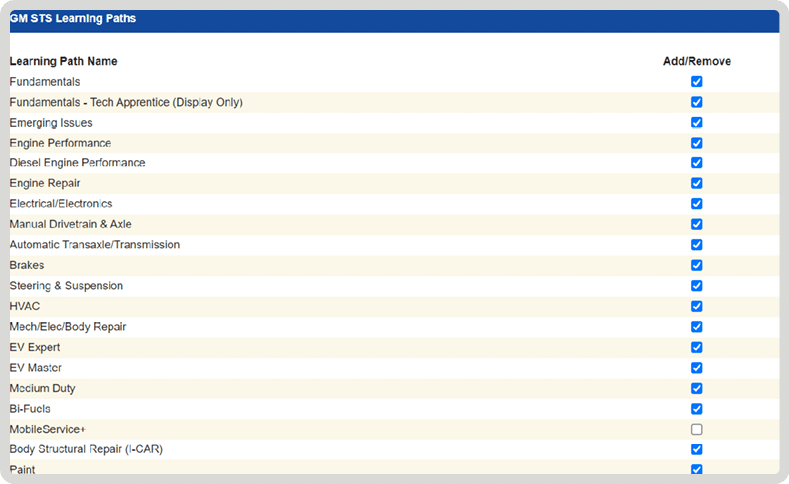 The Learning Path is an online feature developed to help dealership managers and employees plan their training. The Learning Path outlines training plans, recommends courses, and summarizes training activity to promote achieving dealership training standards and obtaining individual certifications.
The Learning Path is an online feature developed to help dealership managers and employees plan their training. The Learning Path outlines training plans, recommends courses, and summarizes training activity to promote achieving dealership training standards and obtaining individual certifications.
Service managers have the ability to quickly and easily build the Learning Paths for all of the service technicians at the dealership by selecting the following path: Profile > Profile Manager. When service managers click on this link, they get a list of all technicians at their dealer. From there, they can select View Learning Path > Add/Remove Learning Path to get to the page where they can add/remove learning paths for the Service Technical Certification Areas.
6.7.2 ILT Waitlist & Unscheduled ILT Course Request a Class Capability
If you want to enroll in a Hands-On class that is currently full, you can join the waitlist to be placed in a future class at the same training location. If there are openings for a class you want to take, but none of the times or locations work for you, you can utilize the Request Unscheduled Course function. By selecting the Request Unscheduled Course link, you can specify what course and where you want the potential offering to take place. These submissions are taken into account when the class organizers get ready to schedule a new offering.
Note: Certain ILT courses are only offered at the Regional Training Centers. Please check your learning path for any restrictions before requesting an unscheduled course.
6.7.3 Online Testing
The Center of Learning website provides users with the ability to take a variety of online tests. These service technical and Sales, Service, and Parts tests include online instructor-led seminar tests and Placement Assessment tests, which allow users to test out of classes. Upon completing the test, users receive immediate feedback on their score. The system immediately updates their training record.
6.7.4 Technician Guides (TGs) for VCTs and V-ILTs
VCT and V-ILT Technician Guides can be downloaded from the Center of Learning website from the View Course page. To download a guide, access the site and find the course, either through your Learning Paths or through the Catalog and select its name. This will bring you to the View Course page where you can download the Technician Guide.
The GM technical training centers have now gone paperless and will provide tablets and tablet friendly TGs for participants to annotate and mark up. Participants can then save their digital TGs to a flash drive and take it with them, with their notes, back to their dealership to reference later.
6.7.5 Training Expiration Email Notification
Before the expiration of a training event (ASE certifications, Certification Events), the Center of Learning website automatically sends an email notification to the employee (provided an email address has been entered into the system). This allows employees to ensure they stay compliant with any and all training requirements.
6.7.6 Search Functionality
The Center of Learning website offers a search functionality. The search engine uses course long names, short names, abstract, notes, and key words to try to find a match.
VCT courses bring classroom training directly to your computer. This delivery method improves instructor and participant interaction through a rich media interface and provides an enhanced learning experience for the technician.
Technicians select their desired course and hit Enroll.
Technicians can see a schedule of their course enrollments by viewing “My Enrollments” or “My VCT” on the home page.
Note: To find the Technician Guide (TG), formally called Participant Guides, for VCT you are enrolled in to go to the View Course page by selecting the course’s name. Find the TG on this page and download it before the start of your course per below.
V-ILT courses bring part of the hands-on training experience into your dealership. They are the first part in series of course components that once completed provide credit for hands-on training requirements that would traditionally require multiple days in the training center. To enroll, technicians follow the same procedure as VCTs. Find the desired course on the Center of Learning, and select Enroll.
Just like with VCTs, technicians can see a schedule of their course enrollments by viewing “My Enrollments” or “My VCTs” on the home page.
The Technician Guides for V-ILTs are also found the same ways as VCTs. Go to the View Course page for whatever course you wish to view the Participant Guide for and download it using the link found on that page.
Many prerecorded STC courses are available through Video On Demand (VOD). Emerging Issues courses are released directly to VOD on the second Thursday of each month. Through the combined use of text, 2D and 3D animation, photos, and video, technicians are able to review these training modules on-demand any time of day or night, reducing time away from the service bay. VOD post tests are available directly from the VOD page upon completion of the course.
WBT is knowledge-based training delivered over the internet. Service technicians can access WBT at their convenience. To launch a WBT course component, technicians identify the course using the Catalog Search, Learning Path, or Path to 100% STS link and select Launch.


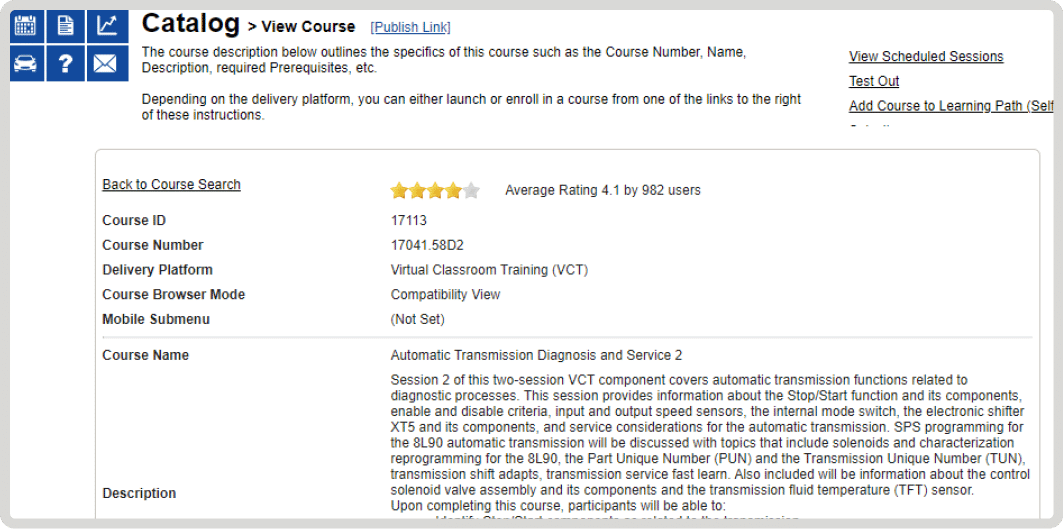
Through its blended media approach (e.g., VCT, VOD, WBT, and V/P-ILT) along with highly qualified instructional design, GM STC helps to extend the service technician’s knowledge. The program also reduces the time that service technicians spend away from dealerships.
VCT courses bring classroom training directly to your computer. This delivery method improves instructor and participant interaction through a rich media interface and provides an enhanced learning experience for the technician.
Technicians select their desired course and hit Enroll.
Technicians can see a schedule of their course enrollments by viewing “My Enrollments” or “My VCT” on the home page.
Note: To find the Technician Guide (TG), formally called Participant Guides, for VCT you are enrolled in to go to the View Course page by selecting the course’s name. Find the TG on this page and download it before the start of your course per below.
V-ILT courses bring part of the hands-on training experience into your dealership. They are the first part in series of course components that once completed provide credit for hands-on training requirements that would traditionally require multiple days in the training center. To enroll, technicians follow the same procedure as VCTs. Find the desired course on the Center of Learning, and select Enroll.
Just like with VCTs, technicians can see a schedule of their course enrollments by viewing “My Enrollments” or “My VCTs” on the home page.
The Technician Guides for V-ILTs are also found the same ways as VCTs. Go to the View Course page for whatever course you wish to view the Participant Guide for and download it using the link found on that page.
Many prerecorded STC courses are available through Video On Demand (VOD). Emerging Issues courses are released directly to VOD on the second Thursday of each month. Through the combined use of text, 2D and 3D animation, photos, and video, technicians are able to review these training modules on-demand any time of day or night, reducing time away from the service bay. VOD post tests are available directly from the VOD page upon completion of the course.
WBT is knowledge-based training delivered over the internet. Service technicians can access WBT at their convenience. To launch a WBT course component, technicians identify the course using the Catalog Search, Learning Path, or Path to 100% STS link and select Launch.
Various reports are accessible through the Center of Learning website. These reports help dealership managers determine their employees’ training needs and accomplishments.
The Center of Learning website recommends the next two full courses a service technician needs to complete to achieve MTC in a selected work area. A full course consists of all course components (WBT, online instructor-led, Hands-On). The system provides the additional recommendations to allow for long-term planning of training. For example, a service technician can complete the online instructor-led components of the next two courses and then enroll for the Hands-On course component as soon as prerequisites are satisfied.
Note: The system recommends MTC courses only for service technicians who have selected a Learning Path.
To start, the dealer service manager registers the dealer technicians into specific Learning Paths with the Center of Learning. These Learning paths have percentages that correspond to STS requirements and display their percentage of completion on the homepage. Once a technician is registered to a Learning Path, the Center of Learning website recommends the next two full courses a service technician needs to complete to achieve the dealership’s division-required training in each work area. A full course consists of all components of a course (WBT, online instructor-led, Hands-On). The system provides the additional recommendations to allow for long-term planning of training. For example, a service technician can complete the online instructor-led components of the next two courses, and then enroll for the Hands-On component as soon as prerequisites are satisfied. To meet STS, the system recommends the “best case” service technician, the one closest to fulfilling the training requirements in each work area. As soon as the dealership is 100% in a given work area, the system does not recommend additional training for that area, even though others may need additional training.
Note: The system recommends training only for employees who have specified a Learning Path.
Learning Path
The Learning Path is an online feature developed to help dealership managers and employees plan their training. The Learning Path outlines training plans, recommends courses, and summarizes training activity to promote achieving dealership training standards and obtaining individual certifications.
Service managers have the ability to quickly and easily build the Learning Paths for all of the service technicians at the dealership by selecting the following path: Profile > Profile Manager. When service managers click on this link, they get a list of all technicians at their dealer. From there, they can select View Learning Path > Add/Remove Learning Path to get to the page where they can add/remove learning paths for the Service Technical Certification Areas.
6.7.1 ILT Waitlist & Unscheduled ILT Course Request a Class Capability
If you want to enroll in a Hands-On class that is currently full, you can join the waitlist to be placed in a future class at the same training location. If there are openings for a class you want to take, but none of the times or locations work for you, you can utilize the Request Unscheduled Course function. By selecting the Request Unscheduled Course link, you can specify what course and where you want the potential offering to take place. These submissions are taken into account when the class organizers get ready to schedule a new offering.
Note: Certain ILT courses are only offered at the Regional Training Centers. Please check your learning path for any restrictions before requesting an unscheduled course.
6.7.2 Online Testing
The Center of Learning website provides users with the ability to take a variety of online tests. These service technical and Sales, Service, and Parts tests include online instructor-led seminar tests and Placement Assessment tests, which allow users to test out of classes. Upon completing the test, users receive immediate feedback on their score. The system immediately updates their training record.
6.7.3 Technician Guides (TGs) for VCTs and V-ILTs
VCT and V-ILT Technician Guides can be downloaded from the Center of Learning website from the View Course page. To download a guide, access the site and find the course, either through your Learning Paths or through the Catalog and select its name. This will bring you to the View Course page where you can download the Technician Guide.
The GM technical training centers have now gone paperless and will provide tablets and tablet friendly TGs for participants to annotate and mark up. Participants can then save their digital TGs to a flash drive and take it with them, with their notes, back to their dealership to reference later.
6.7.4 Training Expiration Email Notification
Before the expiration of a training event (ASE certifications, Certification Events), the Center of Learning website automatically sends an email notification to the employee (provided an email address has been entered into the system). This allows employees to ensure they stay compliant with any and all training requirements.
6.7.5 Search Functionality
The Center of Learning website offers a search functionality. The search engine uses course long names, short names, abstract, notes, and key words to try to find a match.
Center of Learning provides a common entry point to the GM STC program on the internet at www.gmstc.com. Here individuals can find information on the program including:
The “Contact Us” area of the site allows individuals to share their comments, ask questions, and provide general feedback.

7.1.1 Help/Support
Center of Learning supplies a Live Chat feature to support dealerships and service technicians for technical training. The Help Desk can be reached by selecting the Help/Support box on the home page and then selecting the Chat option. The Help Desk supports the following areas:
The Help Desk is available Monday through Friday, 8 a.m. - 8 p.m. Eastern time (excluding holidays).
For GM GlobalConnect support, call the U.S. GM GlobalConnect Help Desk at (888) 337-1010.
7.2.1 GM Regional Map
Below is a picture of the GM STC Training Centers and satellite locations by region. For the most current information, go to https://www.gmstc.com/index.php/training-locations.
The following is a list of addresses, phone numbers, and corresponding maps for the GM Regional Training Centers. The address and maps for the satellite training centers are arranged by region to help you determine which training center is most convenient to your location. Contact the Regional Training Center for detailed driving instructions and maps.
7.3.1 Computer System Standards/Specifications
For the current recommended and minimum training system requirements for all GM STC training applications, please visit gmdesolutions.com > Home > Techline IT Solutions > Click on “GM IT Standards” to open the .pdf document. This downloadable PDF will help to ensure the proper performance of the GM Center of Learning website and online courseware. As GM dealerships become more dependent on technology to service vehicles, multiple PCs in the service department is a necessity.
7.3.2 Computer System Parameters Affecting Courseware Performance
Generally speaking, three factors affect the performance of the training software on a computer system:
7.4.1 For Participants
Many GM STC courses components are offered via the online system. This live, internet-based training requires no special software. A headset equipped with a microphone must be used in order to participate in the training. This provides live access for “on the spot” question and answer opportunities. Participants must complete the prerequisite courses prior to enrolling in any online instructor-led courses.
It’s easy to set up your computer for this training. In fact, most participants have the basics before they start.
Step 1:
To participate in a session, your computer should meet the following requirements:
Step 2:
Your computer’s built-in microphone and speakers won’t do a quality job. The built-in microphone can pick up the audio output from your speaker. This causes an echo, which will be heard by all participants. Using a PC headset, earphones, or earbuds with attached microphone helps prevent echoing. For best audio quality, a USB-type PC headset with attached microphone is recommended.
General Motors Company and GM STC provide technical training to thousands of employees, dealers, and other GM customers. Various publications and training courses have been developed providing the latest in technical information, along with numerous service procedures and systems operations for GM vehicles.
This specialized training and latest technical information is now available through the GM Training Materials Headquarters. The training material GM STC provides to each GM dealer service technician is available in the following formats:
For those who successfully complete GM Master Technician Certification, additional GM patches are available for purchase.
To find out more, contact:
Center of Learning Help Desk using the Live Chat feature within Help/Support
Additional training courses and/or training materials are available for purchase by visiting either of these two sites below:

Center of Learning provides a common entry point to the GM STC program on the internet at www.gmstc.com. Here individuals can find information on the program including:
The “Contact Us” area of the site allows individuals to share their comments, ask questions, and provide general feedback.

7.1.1 Help/Support
Center of Learning supplies a Live Chat feature to support dealerships and service technicians for technical training. The Help Desk can be reached by selecting the Help/Support box on the home page and then selecting the Chat option. The Help Desk supports the following areas:
The Help Desk is available Monday through Friday, 8 a.m. - 8 p.m. Eastern time (excluding holidays).
For GM GlobalConnect support, call the U.S. GM GlobalConnect Help Desk at (888) 337-1010.
7.2.1 GM Regional Map
Below is a picture of the GM STC Training Centers and satellite locations by region. For the most current information, go to https://www.gmstc.com/index.php/training-locations.
The following is a list of addresses, phone numbers, and corresponding maps for the GM Regional Training Centers. The address and maps for the satellite training centers are arranged by region to help you determine which training center is most convenient to your location. Contact the Regional Training Center for detailed driving instructions and maps.
7.3.1 Computer System Standards/Specifications
For the current recommended and minimum training system requirements for all GM STC training applications, please visit gmdesolutions.com > Home > Techline IT Solutions > Click on “GM IT Standards” to open the .pdf document. This downloadable PDF will help to ensure the proper performance of the GM Center of Learning website and online courseware. As GM dealerships become more dependent on technology to service vehicles, multiple PCs in the service department is a necessity.
7.3.2 Computer System Parameters Affecting Courseware Performance
Generally speaking, three factors affect the performance of the training software on a computer system:
7.4.1 For Participants
Many GM STC courses components are offered via the online system. This live, internet-based training requires no special software. A headset equipped with a microphone must be used in order to participate in the training. This provides live access for “on the spot” question and answer opportunities. Participants must complete the prerequisite courses prior to enrolling in any online instructor-led courses.
It’s easy to set up your computer for this training. In fact, most participants have the basics before they start.
Step 1:
To participate in a session, your computer should meet the following requirements:
Step 2:
Your computer’s built-in microphone and speakers won’t do a quality job. The built-in microphone can pick up the audio output from your speaker. This causes an echo, which will be heard by all participants. Using a PC headset, earphones, or earbuds with attached microphone helps prevent echoing. For best audio quality, a USB-type PC headset with attached microphone is recommended.
General Motors Company and GM STC provide technical training to thousands of employees, dealers, and other GM customers. Various publications and training courses have been developed providing the latest in technical information, along with numerous service procedures and systems operations for GM vehicles.
This specialized training and latest technical information is now available through the GM Training Materials Headquarters. The training material GM STC provides to each GM dealer service technician is available in the following formats:
For those who successfully complete GM Master Technician Certification, additional GM patches are available for purchase.
To find out more, contact:
Center of Learning Help Desk using the Live Chat feature within Help/Support
Additional training courses and/or training materials are available for purchase by visiting either of these two sites below:

General Motors is pleased to provide comprehensive training opportunities to help you maintain competent Fleet service personnel and achieve increased productivity. There are four curriculum sources available for service technical training to address your specific needs.
The goal of the GM STC Fleet technician training program is to provide the same high performance training that is available to GM dealership service technicians. The performance-based content is delivered through a blended learning curriculum.
GM STC utilizes the latest in training technology to effectively support the complex and emerging training requirements for service personnel with the objective to enhance the technician’s ability to “Fix it Right the First Time”.
GM STC uses a combination of delivery components to provide highly effective and inexpensive technician training. The different blended learning components available through the GM STC are:

8.1.1 GM Envolve Service Technical Training
This is classroom style training delivered by GM-certified Fleet instructors on-site at your Fleet’s location. Existing programs are tailored for specific Fleet vehicles and designed for Fleet technicians. Past and current models are featured based on the vehicles in your Fleet and training requested.
The GM Fleet Technician Training Program offers:
For more information, scheduling, and to ensure the accuracy of response, email all questions to Jeff Holmes at jeffry.holmes@gov2x.com or call (248) 837-6665.
ACDelco Technical Training is the service technician training arm for ACDelco and GM Customer Care and Aftersales. The ACDelco Technical Training program’s objective is to train the aftermarket independent service center technician population across the United States.
ACDelco’s mission is to utilize engaging education methods in an industry-leading training portfolio to ensure aftermarket service professionals have the skills necessary to safely and effectively diagnose and repair customer vehicles.
The ACDelco blended learning approach offers courses at a variety of instructional levels and training methods to suit virtually every person’s needs. The following delivery media are currently provided to ACDelco service technicians:
The blended learning training techniques provide performance-based, flexible delivery methods that facilitate training deeper into the shop and enhance the ACDelco service technician’s ability to “Fix it Right the First Time.”
For more information regarding the ACDelco Technical Training program, please visit www.acdelcotraining.com and click on the Training tab.
G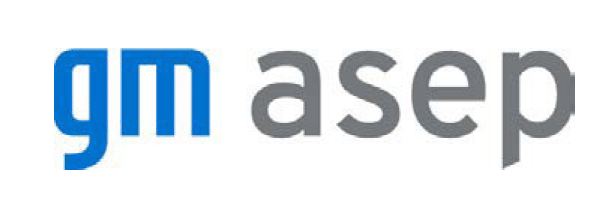 M has specific technician training initiatives to assist dealers in developing their next generation of technicians. The GM technician training strategy is a three-tiered approach enabling dealers to train technicians at every level — from high school/GM ASE Education Foundation to college/GM ASEP and beyond. For instance, GM ASEP offers training for technically inclined students pursuing a career in servicing and maintaining GM vehicles. The program is a joint effort between GM, its dealers, and select colleges and universities across the United States, Canada, China, and Ecuador. GM ASEP teaches exclusively on current GM products. GM ASEP allows students to alternate between attending college and working at a sponsoring GM dealership for over the course of two years. Upon graduation, students receive an Associate Degree in Automotive Technology (or similar).
M has specific technician training initiatives to assist dealers in developing their next generation of technicians. The GM technician training strategy is a three-tiered approach enabling dealers to train technicians at every level — from high school/GM ASE Education Foundation to college/GM ASEP and beyond. For instance, GM ASEP offers training for technically inclined students pursuing a career in servicing and maintaining GM vehicles. The program is a joint effort between GM, its dealers, and select colleges and universities across the United States, Canada, China, and Ecuador. GM ASEP teaches exclusively on current GM products. GM ASEP allows students to alternate between attending college and working at a sponsoring GM dealership for over the course of two years. Upon graduation, students receive an Associate Degree in Automotive Technology (or similar).
GM ASEP incorporates advanced automotive technical training with a strong academic foundation of math, reading, and electronics, and both analytical and technical skills.
Students earn an Associate Degree while working and learning on the job, resulting in a solid education combined with invaluable work experience. Since 1979, GM’s continued commitment to identify and support GM ASEP colleges and universities has produced over 16,000 service technicians.
Any Chevrolet, Buick, GMC, and Cadillac dealer and ACDelco Professional Service Centers (PSC) are eligible to sponsor GM ASEP students.
General Contact Information
Visit www.gmasep.org for locations and additional program information.
GM STEP is an additional technician training initiative to assist dealers in developing the next generation of technicians. GM STEP provides a way for dealerships to connect to local schools and support youth automotive education programs. Dealers will provide mentoring to help build relationships with students, and encourage them to continue their career path in the automotive field.
The dealer is the conduit to connect a high school or non-ASEP college to GM Service Technical College’s (STC) Learning Management System (LMS), the Center of Learning. Students and instructors will have access to complimentary GM-specific web and video technical training courses through the Center of Learning.
GM STEP also provides graduating students an opportunity to be hired as entry-level Maintenance Inspection Technicians (MITs), Maintenance Light Repair (MLR) technicians, or other roles within the dealer they partnered with.
GM STEP has two different programs, one for high schools and another for colleges. It provides schools with the benefit of a dealer relationship, and complimentary GM-training to offer students. The dealer benefits by fostering a steady pipeline of newly trained technicians through its school partnerships.
For more information go to www.GMSTC.com. To get started, dealers should reach out to their zone team representatives.
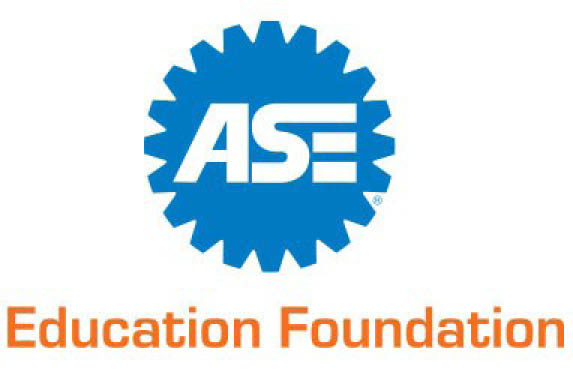 We are the ASE Education Foundation. Our mission is to educate, prepare, and inspire a new kind of automotive service workforce. One that embraces innovation, today’s workforce demands, and critical thinking. One that is career-ready, eager, and committed. The ASE Education Foundation has designed a powerful new way of preparing students to meet today’s demands.
We are the ASE Education Foundation. Our mission is to educate, prepare, and inspire a new kind of automotive service workforce. One that embraces innovation, today’s workforce demands, and critical thinking. One that is career-ready, eager, and committed. The ASE Education Foundation has designed a powerful new way of preparing students to meet today’s demands.
Successfully preparing students for today’s automotive service industry takes a multidisciplinary approach. ASE Education Foundation is part of the ASE Alliance and is the career-to-work arm of ASE that offers students the means to learn, do, try, ask, grow and then hit the ground running after graduation.
The ASE Education Foundation is engineered from the top-down to:
To learn more about the ASE Education Foundation, contact your GM Regional Office or Training Center. Or visit us on the web at: www.aseeducationfoundation.org.
As a company, General Motors has supported the U.S. military for more than a century, responding swiftly to the need for purpose-built vehicles for use in conflict situations. We’ve employed veterans and military families throughout our history and we continue to be a corporate leader in offering advocacy and significant ongoing financial support for military causes.
In 2013, GM joined forces with the U.S. Chamber of Commerce Foundation’s Hiring Our Heroes program, a national effort to assist veterans, transitioning service members, and military spouses find meaningful employment.
The same year, GM’s Service Technical College began offering free training to veterans and returning service members to prepare them for both technical and non-technical entry-level roles in a dealership. This training can also lead to opportunities with participating ACDelco Warehouse distributors and ACDelco Professional Service Centers.
But that’s not all. GI Bill benefits can be applied to attending GM’s Automotive Service Education Program (ASEP). The GM ASEP training program combines state-of-the-art automotive service, appropriate academic coursework, and real-world internship experiences to give students the best possible preparation for a career as an automotive technician, teaching exclusively on current GM products. The program incorporates advanced automotive technical training with a strong academic foundation of math, reading, and electronics, and both analytical and technical skills. GM ASEP is a joint effort between GM, its dealers, ACDelco Professional Service Center Program Members, and select colleges across the United States, Canada, China, and Ecuador.
GM ASEP students alternate between the classroom and Hands-On work experience at a sponsoring GM dealership. Upon graduation, students earn an Associate Degree in Automotive Technology (or similar), resulting in a solid education combined with invaluable work experience. Any Buick, Cadillac, Chevrolet, GMC, or ACDelco Professional Service Center can sponsor GM ASEP students.
The Hiring Our Heroes initiative has helped more than 200,000 returning military service members and their spouses find training, career counseling, and employment opportunities.
For more information, visit: www.HiringOurHeroes.org.
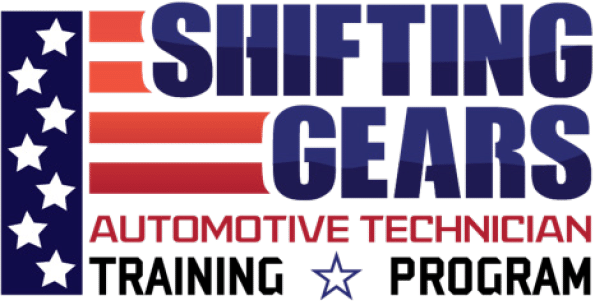 The Shifting Gears Automotive Technician Training Program is designed to support service members who will be transitioning from military service into the civilian workforce. The U.S. Army, GM, and VPS (GM’s training partner) collaborated to design and deliver a training program that provides eligible transitioning service members with the necessary skills to become service technicians at GM dealerships.
The Shifting Gears Automotive Technician Training Program is designed to support service members who will be transitioning from military service into the civilian workforce. The U.S. Army, GM, and VPS (GM’s training partner) collaborated to design and deliver a training program that provides eligible transitioning service members with the necessary skills to become service technicians at GM dealerships.
The program consists of a 12-week customized, on-base technician training curriculum that includes instructor-led technical training, online web-based courses, and hands-on training. Shifting Gears launched in August of 2014 at Fort Cavazos, TX and has graduated over 800 alumni. GM provides the vehicles, VPS developed and delivers the training, and the U.S. Army provides the facility. Service members from all branches of service, to include select veterans, are eligible to attend. Upon successful course completion and program graduation, students can achieve just over 70% of GM’s STS requirements and Silver Certificates in Electrical Academy, Brakes, Chassis, Engine Mechanical, and Engine Performance. Participants also have access to an Engagement Specialist who is embedded in the program and located at Fort Cavazos to help prepare them for their civilian job search and support the regional GM team in connecting them with hiring dealerships.
Alumni from the Shifting Gears Program receive preparation training in Electrical and Brakes prior to taking the ASE exams in those categories. Registration and test fees are both paid for by Workforce Solutions of Central Texas prior to graduation. The alumni are also able to receive a living stipend through the Veteran Administration utilizing their Post 9/11 GI Bill benefits if the dealership that employs them are enrolled as a DOL approved apprenticeship program. The DOL Apprenticeship Program is a great starting point for any entry level technician and is also a great asset to GM dealerships to acquire and retain quality technicians.
When a Shifting Gears alum is hired, the Center of Learning will bill the Dealer’s Open Account in three installments of $2200 each:
Should a Shifting Gears alum separate from the dealership within six months of the Date of Hire (when the hiring Dealer activates the technician in the Center of Learning at www.centerlearning.com), the Dealer is eligible for a full refund of all paid training fees.
 General Motors continues to be one of the world’s leading vehicle manufacturers with over 20 million vehicles on the road. In fact, GM dealerships employ over 29,000 technicians in the United States alone.
General Motors continues to be one of the world’s leading vehicle manufacturers with over 20 million vehicles on the road. In fact, GM dealerships employ over 29,000 technicians in the United States alone.
As a technician in the GM Technician Career Training program, you’ll experience a blended training program of hands-on and online learning to diagnose, repair, and maintain gasoline and diesel vehicles for the Chevrolet, Buick, GMC, and Cadillac brands.
Program Type: Student-paid program
Program Length: 12 weeks
Topics Covered:
Train at Universal Technical Institute (UTI) and earn GM Credits*
When you participate in the GM Technician Career Training program, you’re getting skills and experience valued by every GM dealership. You can earn GM course credits that can elevate you to Bronze, Silver, and Gold certification levels in multiple service areas upon graduation:
*Number of credits required is subject to change.
Program-Specific Requirements:
Web Based Training (WBT)
Hands-On Training
*A small fee may be associated with some of the training materials.
Online instructor-led course components, many of which are prerequisites to hands-on courses, are available for purchase. Service Know How Videos are also available for purchase although they may not be a training requirement. Please visit www.gmtechinfo.com. Hands-On classes, conducted by GM certified instructors, are offered on a space-available basis, providing prerequisite WBT and online instructor-led courses have been completed prior to attendance. Contact one of the Regional Training Centers for more hands-on course, scheduling, and enrollment information.
General Motors is pleased to provide comprehensive training opportunities to help you maintain competent Fleet service personnel and achieve increased productivity. There are four curriculum sources available for service technical training to address your specific needs.
The goal of the GM STC Fleet technician training program is to provide the same high performance training that is available to GM dealership service technicians. The performance-based content is delivered through a blended learning curriculum.
GM STC utilizes the latest in training technology to effectively support the complex and emerging training requirements for service personnel with the objective to enhance the technician’s ability to “Fix it Right the First Time”.
GM STC uses a combination of delivery components to provide highly effective and inexpensive technician training. The different blended learning components available through the GM STC are:

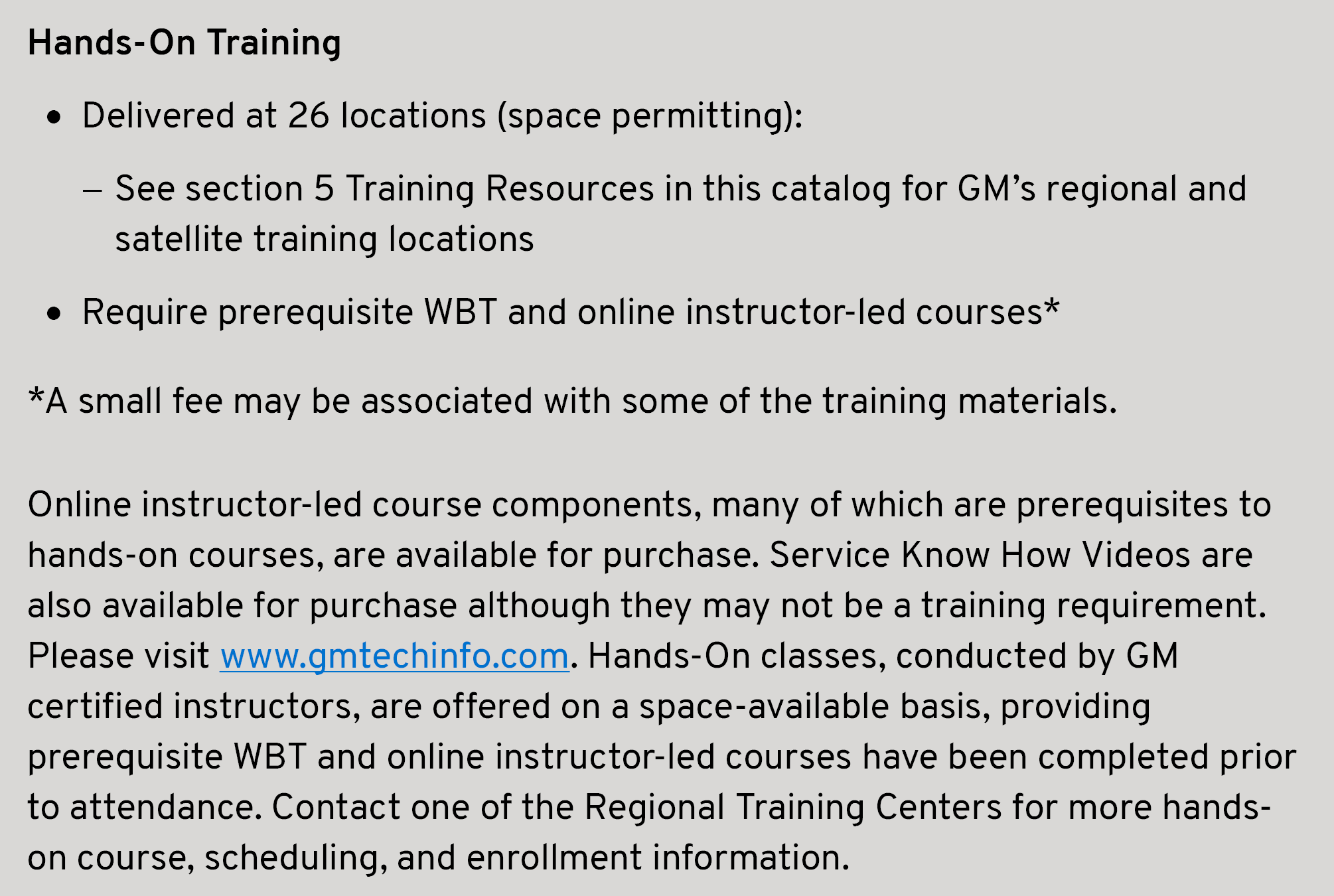

8.1.1 GM Envolve Service Technical Training
This is classroom style training delivered by GM-certified Fleet instructors on-site at your Fleet’s location. Existing programs are tailored for specific Fleet vehicles and designed for Fleet technicians. Past and current models are featured based on the vehicles in your Fleet and training requested.
The GM Fleet Technician Training Program offers:
For more information, scheduling, and to ensure the accuracy of response, email all questions to Jeff Holmes at jeffryholmes@vtxco.com or call (248) 837-6665.
ACDelco Technical Training is the service technician training arm for ACDelco and GM Customer Care and Aftersales. The ACDelco Technical Training program’s objective is to train the aftermarket independent service center technician population across the United States.
ACDelco’s mission is to utilize engaging education methods in an industry-leading training portfolio to ensure aftermarket service professionals have the skills necessary to safely and effectively diagnose and repair customer vehicles
The ACDelco blended learning approach offers courses at a variety of instructional levels and training methods to suit virtually every person’s needs. The following delivery media are currently provided to ACDelco service technicians:
The blended learning training techniques provide performance-based, flexible delivery methods that facilitate training deeper into the shop and enhance the ACDelco service technician’s ability to “Fix it Right the First Time.”
For more information regarding the ACDelco Technical Training program, please visit www.acdelcotraining.com and click on the Training tab.
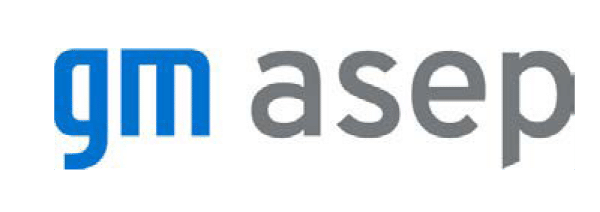
GM has specific technician training initiatives to assist dealers in developing their next generation of technicians. The GM technician training strategy is a three-tiered approach enabling dealers to train technicians at every level — from high school/GM ASE Education Foundation to college/GM ASEP and beyond. For instance, GM ASEP offers training for technically inclined students pursuing a career in servicing and maintaining GM vehicles. The program is a joint effort between GM, its dealers, and select colleges and universities across the United States, Canada, China, and Ecuador. GM ASEP teaches exclusively on current GM products. GM ASEP allows students to alternate between attending college and working at a sponsoring GM dealership for over the course of two years. Upon graduation, students receive an Associate Degree in Automotive Technology (or similar).
GM ASEP incorporates advanced automotive technical training with a strong academic foundation of math, reading, and electronics, and both analytical and technical skills.
Students earn an Associate Degree while working and learning on the job, resulting in a solid education combined with invaluable work experience. Since 1979, GM’s continued commitment to identify and support GM ASEP colleges and universities has produced over 16,000 service technicians.
Any Chevrolet, Buick, GMC, and Cadillac dealer and ACDelco Professional Service Centers (PSC) are eligible to sponsor GM ASEP students.
8.3.1 General Contact Information
Visit www.gmasep.org for locations and additional program information.
GM STEP is an additional technician training initiative to assist dealers in developing the next generation of technicians. GM STEP provides a way for dealerships to connect to local schools and support youth automotive education programs. Dealers will provide mentoring to help build relationships with students, and encourage them to continue their career path in the automotive field.
The dealer is the conduit to connect a high school or non-ASEP college to GM Service Technical College’s (STC) Learning Management System (LMS), the Center of Learning. Students and instructors will have access to complimentary GM-specific web and video technical training courses through the Center of Learning.
GM STEP also provides graduating students an opportunity to be hired as entry-level Maintenance Inspection Technicians (MITs), Maintenance Light Repair (MLR) technicians, or other roles within the dealer they partnered with.
GM STEP has two different programs, one for high schools and another for colleges. It provides schools with the benefit of a dealer relationship, and complimentary GM-training to offer students. The dealer benefits by fostering a steady pipeline of newly trained technicians through its school partnerships.
For more information go to www.GMSTC.com. To get started, dealers should reach out to their zone team representatives.
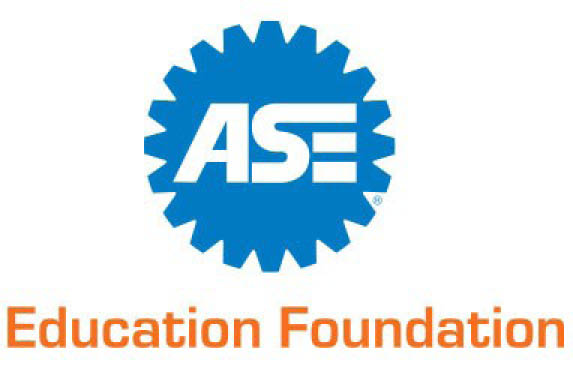
We are the ASE Education Foundation. Our mission is to educate, prepare, and inspire a new kind of automotive service workforce. One that embraces innovation, today’s workforce demands, and critical thinking. One that is career-ready, eager, and committed. The ASE Education Foundation has designed a powerful new way of preparing students to meet today’s demands.
Successfully preparing students for today’s automotive service industry takes a multidisciplinary approach. ASE Education Foundation is part of the ASE Alliance and is the career-to-work arm of ASE that offers students the means to learn, do, try, ask, grow and then hit the ground running after graduation.
The ASE Education Foundation is engineered from the top-down to:
To learn more about the ASE Education Foundation, contact your GM Regional Office or Training Center. Or visit us on the web at: www.aseeducationfoundation.org.
As a company, General Motors has supported the U.S. military for more than a century, responding swiftly to the need for purpose-built vehicles for use in conflict situations. We’ve employed veterans and military families throughout our history and we continue to be a corporate leader in offering advocacy and significant ongoing financial support for military causes.
In 2013, GM joined forces with the U.S. Chamber of Commerce Foundation’s Hiring Our Heroes program, a national effort to assist veterans, transitioning service members, and military spouses find meaningful employment.
The same year, GM’s Service Technical College began offering free training to veterans and returning service members to prepare them for both technical and non-technical entry-level roles in a dealership. This training can also lead to opportunities with participating ACDelco Warehouse distributors and ACDelco Professional Service Centers.
But that’s not all. GI Bill benefits can be applied to attending GM’s Automotive Service Education Program (ASEP). The GM ASEP training program combines state-of-the-art automotive service, appropriate academic coursework, and real-world internship experiences to give students the best possible preparation for a career as an automotive technician, teaching exclusively on current GM products. The program incorporates advanced automotive technical training with a strong academic foundation of math, reading, and electronics, and both analytical and technical skills. GM ASEP is a joint effort between GM, its dealers, ACDelco Professional Service Center Program Members, and select colleges across the United States, Canada, China, and Ecuador.
GM ASEP students alternate between the classroom and Hands-On work experience at a sponsoring GM dealership. Upon graduation, students earn an Associate Degree in Automotive Technology (or similar), resulting in a solid education combined with invaluable work experience. Any Buick, Cadillac, Chevrolet, GMC, or ACDelco Professional Service Center can sponsor GM ASEP students.
The Hiring Our Heroes initiative has helped more than 200,000 returning military service members and their spouses find training, career counseling, and employment opportunities.
For more information, visit: www.HiringOurHeroes.org.
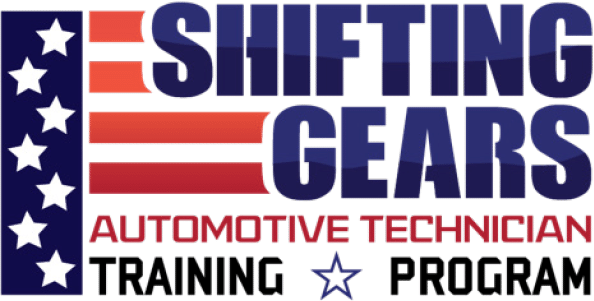
The Shifting Gears Automotive Technician Training Program is designed to support service members who will be transitioning from military service into the civilian workforce. The U.S. Army, GM, and VPS (GM’s training partner) collaborated to design and deliver a training program that provides eligible transitioning service members with the necessary skills to become service technicians at GM dealerships.
The program consists of a 12-week customized, on-base technician training curriculum that includes instructor-led technical training, online web-based courses, and hands-on training. Shifting Gears launched in August of 2014 at Fort Cavazos, TX and has graduated over 800 alumni. GM provides the vehicles, VPS developed and delivers the training, and the U.S. Army provides the facility. Service members from all branches of service, to include select veterans, are eligible to attend. Upon successful course completion and program graduation, students can achieve just over 70% of GM’s STS requirements and Silver Certificates in Electrical Academy, Brakes, Chassis, Engine Mechanical, and Engine Performance. Participants also have access to an Engagement Specialist who is embedded in the program and located at Fort Cavazos to help prepare them for their civilian job search and support the regional GM team in connecting them with hiring dealerships.
Alumni from the Shifting Gears Program receive preparation training in Electrical and Brakes prior to taking the ASE exams in those categories. Registration and test fees are both paid for by Workforce Solutions of Central Texas prior to graduation. The alumni are also able to receive a living stipend through the Veteran Administration utilizing their Post 9/11 GI Bill benefits if the dealership that employs them are enrolled as a DOL approved apprenticeship program. The DOL Apprenticeship Program is a great starting point for any entry level technician and is also a great asset to GM dealerships to acquire and retain quality technicians.
When a Shifting Gears alum is hired, the Center of Learning will bill the Dealer’s Open Account in three installments of $2200 each:
Should a Shifting Gears alum separate from the dealership within six months of the Date of Hire (when the hiring Dealer activates the technician in the Center of Learning at www.centerlearning.com), the Dealer is eligible for a full refund of all paid training fees.

General Motors continues to be one of the world’s leading vehicle manufacturers with over 20 million vehicles on the road. In fact, GM dealerships employ over 29,000 technicians in the United States alone.
As a technician in the GM Technician Career Training program, you’ll experience a blended training program of hands-on and online learning to diagnose, repair, and maintain gasoline and diesel vehicles for the Chevrolet, Buick, GMC, and Cadillac brands.
Program Type: Student-paid program
Program Length: 12 weeks
Topics Covered:
Train at Universal Technical Institute (UTI) and earn GM Credits*
When you participate in the GM Technician Career Training program, you’re getting skills and experience valued by every GM dealership. You can earn GM course credits that can elevate you to Bronze, Silver, and Gold certification levels in multiple service areas upon graduation:
*Number of credits required is subject to change.
Program-Specific Requirements: